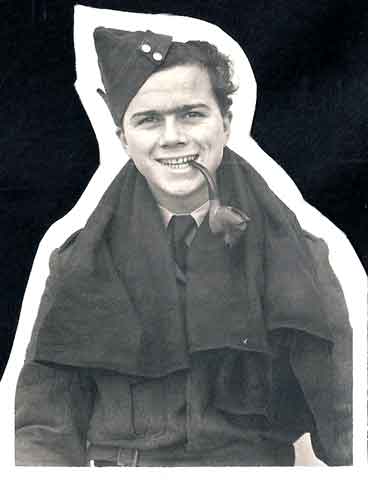
Bebe and his beloved pipe on first joining the RAF at the age of 17.
Mamie,
Bebe's widow, was asked to write a few words for
BeBe's Old Boys' magazine. They were intended for a strictly non-ex-service readership - most City of Norwich School old boys who seem to have been directed into the Norwich Union or accountants' offices!
Brian Sharman 1929-2004
Brian (BeBe) Sharman died very suddenly on 15 October 2004 at the age of 75. He attended the City of Norwich School from 1940 to 1945 and had a marked interest in chemistry. He was a member of the 2nd Norwich Scouts and the Air Training Corps, with which he first left the ground in a glider.
At the age of 17
Brian joined the Royal Air Force and took a course at the RAF School of Photography. In 1950 his real ambition to fly was fulfilled when he was sent to Heany to train in
Tiger Moths. On completion of the course he joined
98 Sqn in 2nd
TAF on
Venoms and
Hunters. On return to the UK in 1956 he took an instructor's course at
CFS, followed by a move back to Norfolk as an instructor at RAF Feltwell. The following years included a posting at RAF Andover, ostensibly on the Communications Squadron while actually there was a very active
RAFGSA gliding club located there - coincidence? He later gave air experience flights to RAF apprentices at Halton, did a
SAM missile tour down the hole at Bawdsey, and ran an RAF gliding school. During his gliding days he gained a
BGA Gold C with Diamond.
Brian retired from the RAF in 1967 and returned to Norwich to spend ten years in civil aviation at the fledgling Norwich Airport (ex-Horsham St Faiths, now Norwich International). He was with Air Anglia on the F27 fleet, followed by executive charter servicing the oil and gas drilling industries, making a triangle between Norwich, Aberdeen and Esjberg. For a while he took the Royal Mail first class post overnight to Liverpool, carried news film from location for Anglia TV, took show biz stars doing summer seasons at Gt Yarmouth to Blackpool and back to record the BBC's Sunday Night variety shows, and had fun joyriding Yarmouth holiday makers round the Broads and to see the seals at Scroby Sands.
Retirement from aviation came in 1985 when
BeBe bought a small picture-framing business. He sold aviation prints and developed a clientele of aircraft enthusiasts. He finally retired in 1999, aged 70, and passed the business over to his manager, who is still successfully running it.
BeBe enjoyed every part of his working life, not just the flying but also the many and varied interesting people that he met. He was still enjoying it the night before he died, when we had four friends round for a convivial dinner.
Bebe Sharman was a charismatic individual with a tremendous sense of humour. He was responsible for all the amusing history and background to the Jever Steam Laundry. These pages are dedicated to his life in the RAF and his sense of humour. He was a professional photographer having joined the RAF originally as an airman in the photographic branch. We are grateful to
Mamie Sharman, his widow, who has kindly given us his five photo albums to load on to the web site in his memory.
The Five Albums, (a total of 761 photos), are as follows (Click on the green title to jump to that album):
Album 1 - January 1948 to November 1948 RAF Luqa, Malta - 198 photos.
Album 2 November 1948 to February 1951 RAF Luqa, Malta, Castel Benito, Libya, RAF Jurby, Isle of Man, flying training at RAF Heany in Northern Rhodesia - 214 photos.
Album 3 - February to November 1951 Flying Training in Rhodesia - 139 photos.
Album 4 - December 1952 to March 1955 Venoms at Fassberg and Hunters at Jever- 120 photos.
Album 5 - December 1955 to July 1966 Hunters at Jever and civilian life - 90 photos.
We start with Album 1 with his first posting to RAF Luqa in Malta from December 1947 to October 1948.
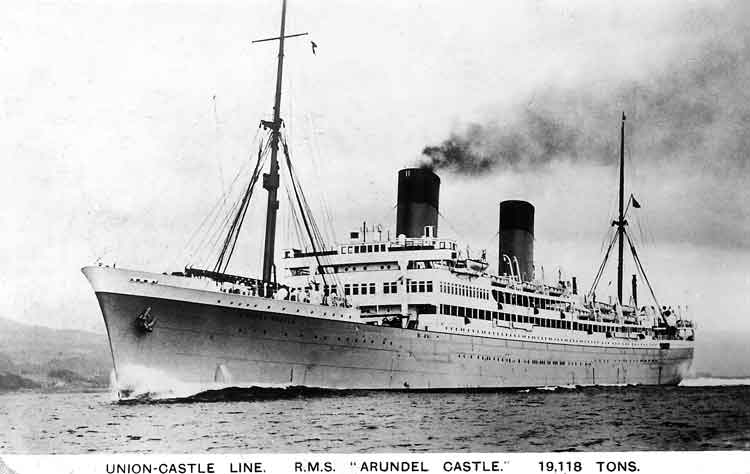
I presume this is the liner that took BeBe out to Malta at the end of 1947.
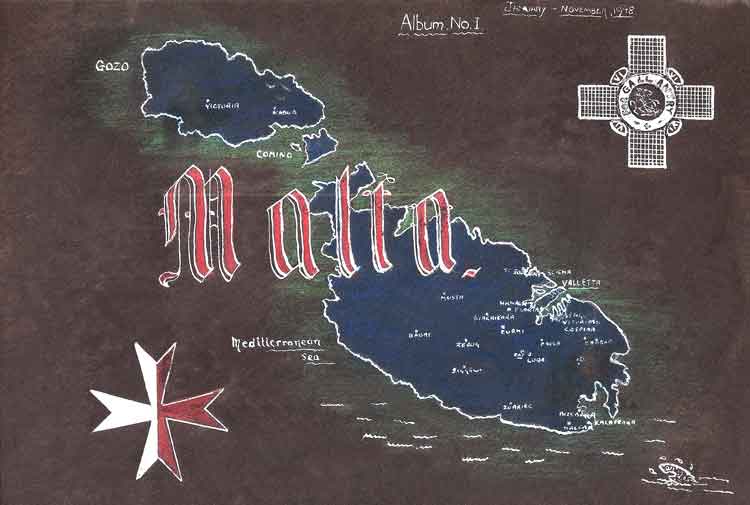
An example of BeBe's talent for artwork recording his arrival in Malta in December 1947.
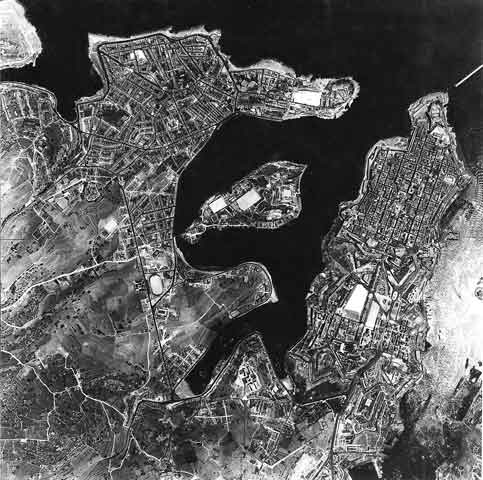
Vertical Photograph of Valetta (on the right) and Siliema (on the outer headland). (Taken from 18,000 ft. 8" lens).
Valletta is the capital of Malta, colloquially known as Il-Belt (English: The City) in Maltese. It is located in the central-eastern portion of the island of Malta, and the historical city has a population of 6,966. Valletta is the second southernmost capital of the EU member states after Nicosia. Valletta contains buildings from the 16th century onwards, built during the rule of the Order of St. John of Jerusalem, also known as Knights Hospitaller. The city is essentially Baroque in character, with elements of Mannerist, Neo-Classical and Modern architecture in selected areas, though World War II left major scars on the city. The City of Valletta was officially recognised as a World Heritage Site by UNESCO in 1980. The city was named for Jean Parisot de Valette, who succeeded in defending the island from an Ottoman invasion in 1565. The official name given by the Order of Saint John was Humilissima Civitas Valletta - The Most Humble City of Valletta, or Cittá Umilissima in Italian. The bastions, curtains and ravelins along with the beauty of its Baroque palaces, gardens and churches, led the ruling houses of Europe to give the city its nickname Superbissima - Most Proud. The Valletta peninsula has two natural harbours, Marsamxett and the Grand Harbour. The Grand Harbour is Malta's major port, with unloading quays at Marsa. A cruise-liner terminal is located along the old seawall of the Valletta Waterfront that Grandmaster Manuel Pinto de Fonseca built. Grand Harbour is on the right partly hidden by the reflected sunlight. Marsamxett Harbour is the dark area in the centre with Manoel Island in the middle. (Thanks to Wikipedia).
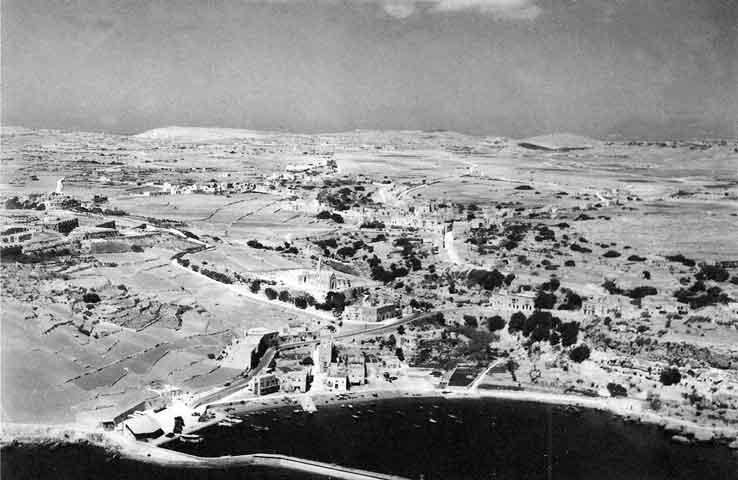
Gozo Harbour. Gozo (Maltese: Ghawdex) is a small island of the Maltese archipelago in the Mediterranean Sea. The island is part of the Southern European country of Malta; after the island of Malta itself, it is the second-largest island in the archipelago. Compared to its southeastern neighbour, Gozo is more rural and known for its scenic hills, which are featured on its coat of arms. The island of Gozo has long been associated with Ogygia, the island home of the nymph Calypso in Homer's Odyssey. Calypso, possessed of great supernatural powers, holds Odysseus captive for a number of years because of her love for him before releasing him to continue his journey home. The island itself has a population of around 31,000 people (all of Malta combined has 402,000), and its inhabitants are known as Gozitans (Maltese: Ghawdxin). It is rich in historical locations such as the Ggantija temples which, along with the Megalithic Temples of Malta, are the world's oldest free-standing structures and also among the world's oldest religious structures. The island is rural in character and, compared to the main island Malta, less developed. Azure Window, a natural arch formed millions of years ago when a limestone cave collapsed, is one of the features of the island. There are many beaches on the island and seaside resorts popular with tourists and locals alike. The most popular are Marsalforn and Xlendi Bay. Gozo is considered one of the top diving destinations in the Mediterranean and a centre for water sports. For such a small island, Gozo has a high concentration of churches (46 in all). The Xewkija church has a capacity of 3000, enough for the entire population of Xewkija village, its dome is larger than that of St. Paul's Cathedral in London. The church bells are rung daily for the canonical hours Matins, Lauds, Terce, Sext, None and vespers. The most famous church on the island is the National Shrine and Basilica of Santwarju tal-Madonna ta' Pinu. (Thanks to Wikipedia).
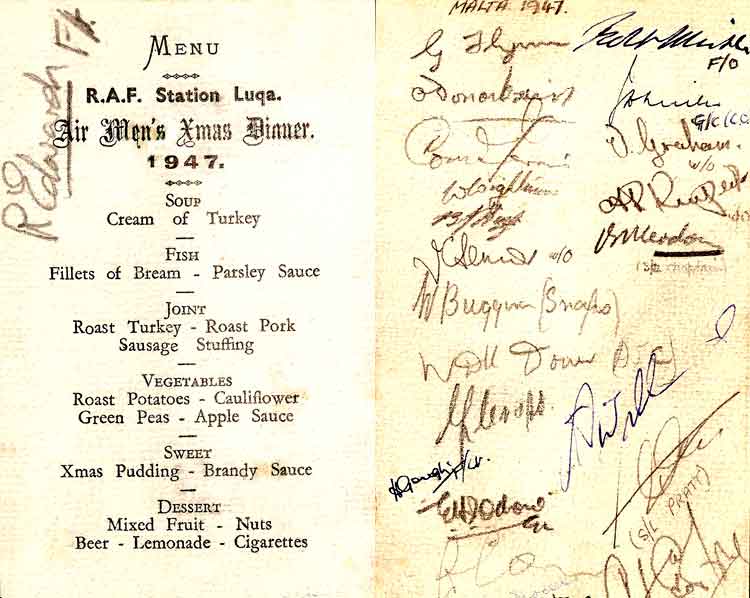 Airmen's Mess Christmas Dinner Menu signed by everyone - Dec47.
Airmen's Mess Christmas Dinner Menu signed by everyone - Dec47.
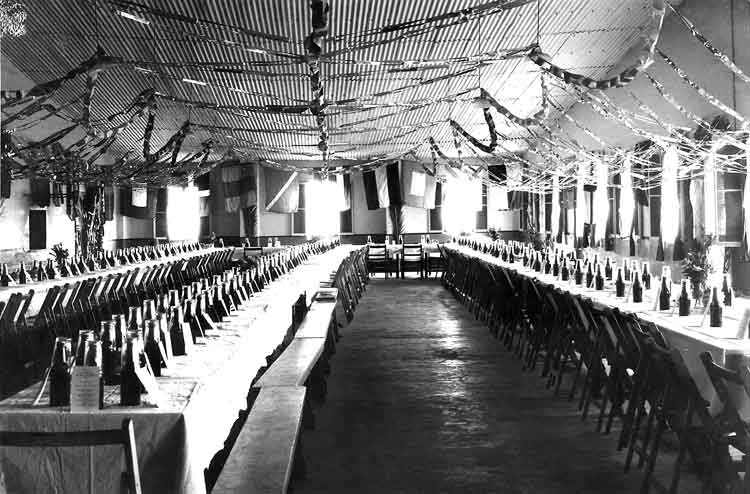 The Mess Christmas Day - '47.
The Mess Christmas Day - '47.
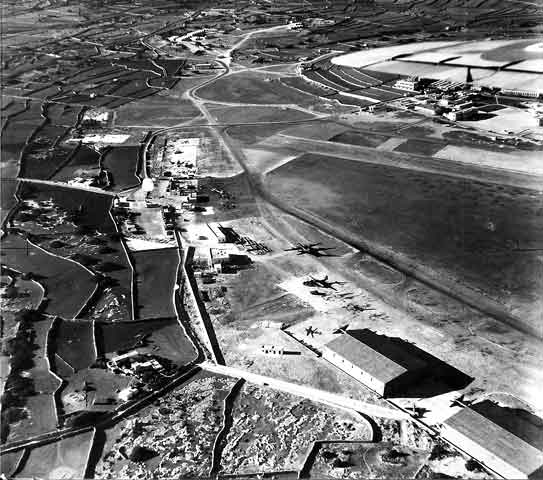
Oblique Aerial View of RAF Hal Far showing Photo Section. The RAF Hal Far airfield was the first permanent airfield to be built on Malta. It was opened on 1Apr29 as HMS Falcon, a Royal Navy base, and was used by Royal Navy air crews. It was transferred to the Maltese Government and redeveloped as from January 1979. It is now closed and one of its runways is used by drag racing enthusiasts. The second runway is now a road leading to an industrial estate which was developed recently.
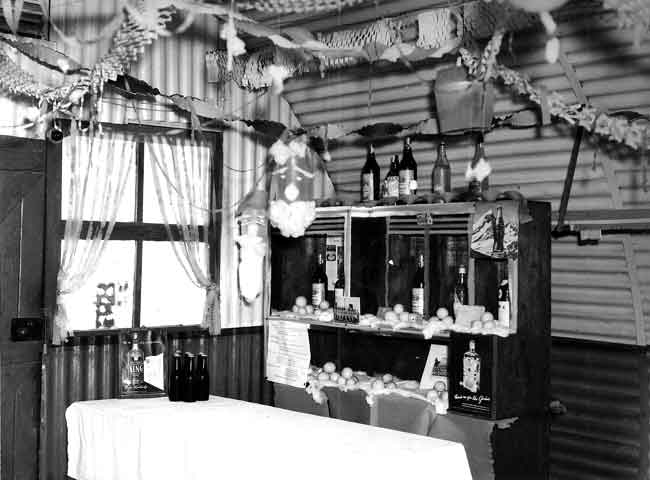
The Best Billet B.1 Xmas Day 1947.
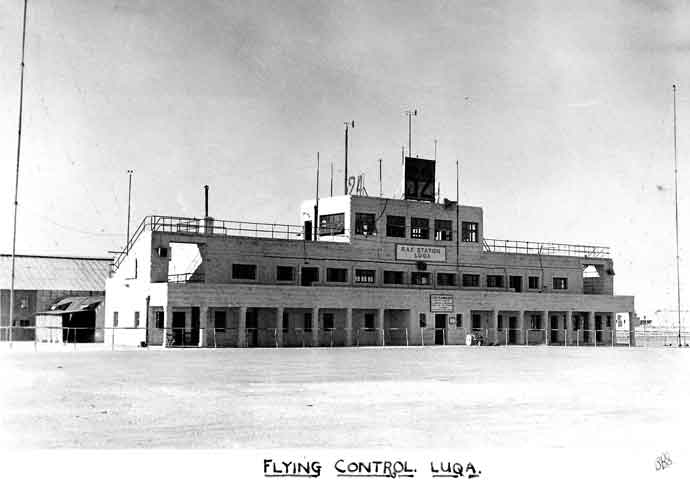
Flying Control RAF Luqa 1948. Royal Air Force Luqa was a flying station and location of RAF Mediterranean Command headquarters of the Royal Air Force on the island of Malta during World War II. Particularly during the Siege of Malta from 1941 to 1943, RAF Luqa was a very important base for British Commonwealth forces fighting against Italy and Germany for naval control of the Mediterranean and for ground control of North Africa. Air combat over and near Malta was some of the most ferocious of the war, and a series of airfields were built on the small, rocky island: at Luqa, Ta'Qali, and Hal Far, plus satellite fields at Safi, Qrendi and on Malta's second island of Gozo. After the war, Luqa remained an important RAF base, serving during the Suez Crisis of 1956, but also served as Malta's main civilian airport. Nowadays, the location has been developed into the main entry point of the modern, independent country of Malta, under the name Malta International Airport. It is sometimes still referred to as "Luqa Airport" or "Valletta Airport". The RAF left in 1979 following a British government decision not to renew the lease on the station from the Maltese. The payments demanded were several times the previous payments under the previous lease. It is also possible that the Avro Vulcan crash over the village of Zabbar led to the Maltese decision to effectively get the RAF to leave by raising the proposed lease payments to what was known to be a level unacceptable to the British. A website exists for anyone that served at any of the British bases in Malta. It is called RAF Luqa Remembered, although it has expanded to include more than Luqa, and the URL is http://raf-luqa.weebly.com. (Thanks to Wikipedia).
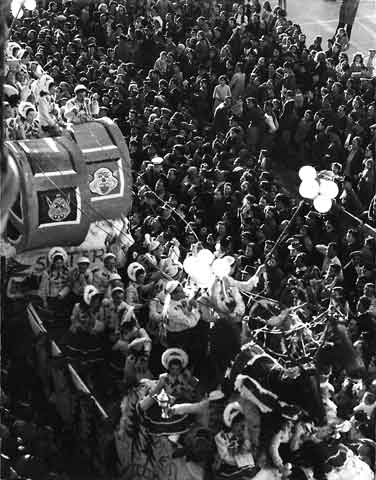
Valletta has a carnival - Feb48.
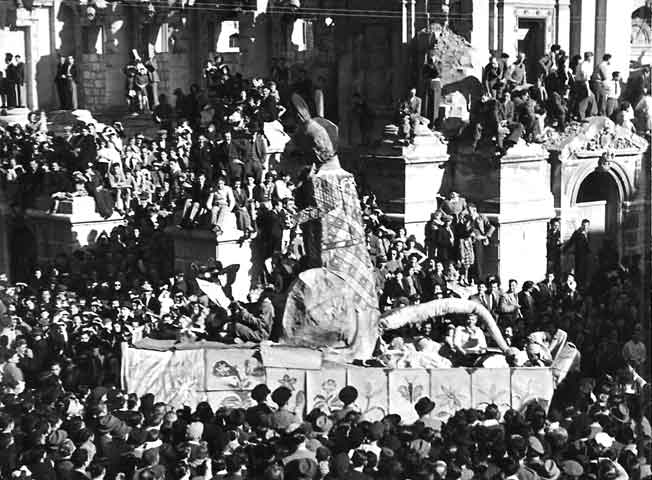
Kangaroo - Valetta Carnival - Feb48.
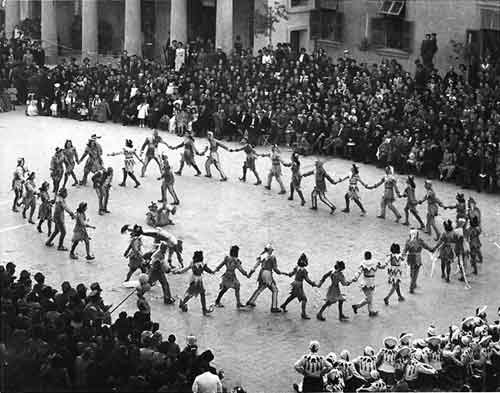
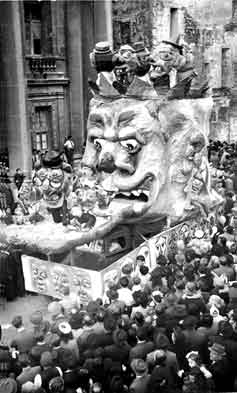
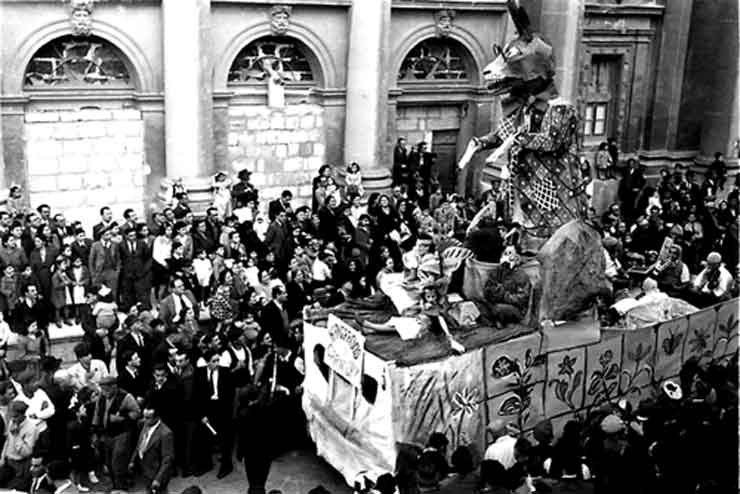 Floats in the Valletta Carnival - Feb48. Carnival (Maltese: il-Karnival ta' Malta) has had an important place on the Maltese cultural calendar for just under five centuries, having been introduced to the Islands by Grand Master Piero de Ponte in 1535. It is held during the week leading up to Ash Wednesday, and typically includes masked balls, fancy dress and grotesque mask competitions, lavish late-night parties, a colourful, ticker-tape parade of allegorical floats presided over by King Carnival (Maltese: ir-Re tal-Karnival), marching bands and costumed revellers. (Thanks to Wikipedia).
Floats in the Valletta Carnival - Feb48. Carnival (Maltese: il-Karnival ta' Malta) has had an important place on the Maltese cultural calendar for just under five centuries, having been introduced to the Islands by Grand Master Piero de Ponte in 1535. It is held during the week leading up to Ash Wednesday, and typically includes masked balls, fancy dress and grotesque mask competitions, lavish late-night parties, a colourful, ticker-tape parade of allegorical floats presided over by King Carnival (Maltese: ir-Re tal-Karnival), marching bands and costumed revellers. (Thanks to Wikipedia).
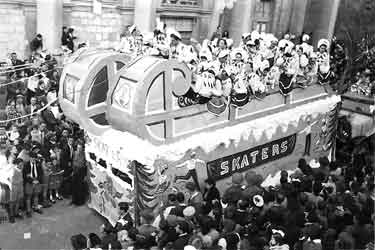
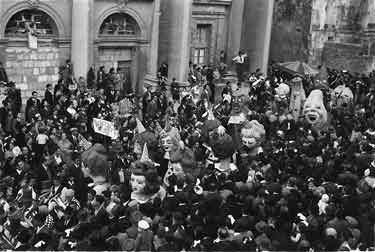

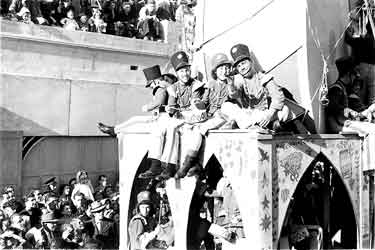
More Floats from the Carnival in Valletta - Feb48.
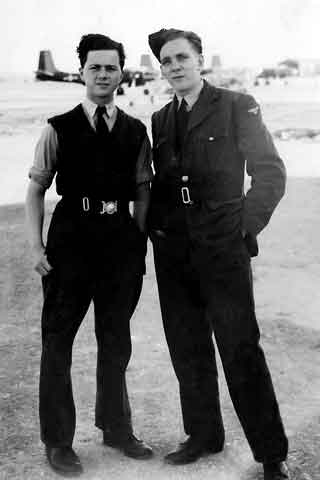
Horne and BeBe - Hal Far.
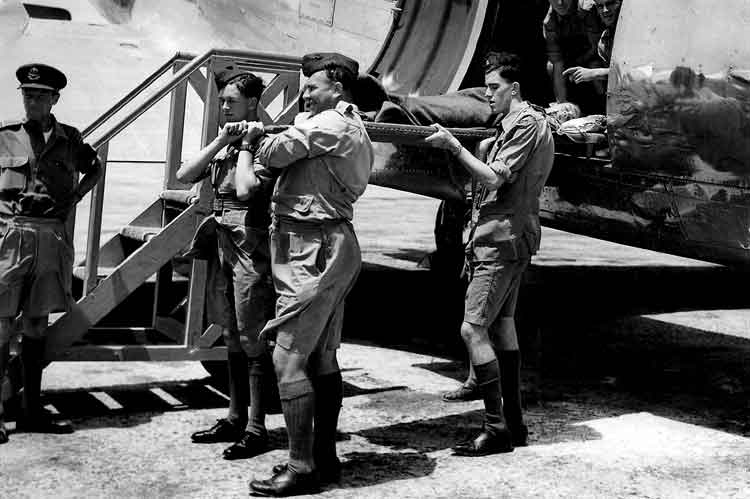
Old Biggins (2nd from left) helps with a mock-up for the PMO.
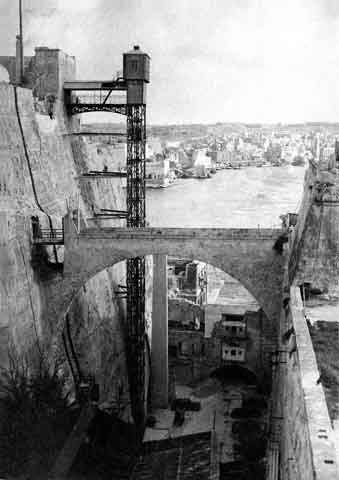
Barracca Lift, Valetta, Malta - Dec47. Macartney, McElroy & Co. Ltd., an engineering company specializing in electric tramway systems, constructed the Upper Barrakka Gardens lift, which opened in September of 1905. Opened to the public in September 1905 at a cost of £5,000 (£510,354 at today's prices Jun13)the Barrakka lift connected Lascaris Wharf (Old Customs House) with Upper Barrakka Gardens offering a shorter and quicker route. The lift incorporated two cabins each capable of carrying 12 passengers. It rose through 75tons of steelwork vertically 167 feet 7inches, with the winding gear housed in a turret even higher at 197 feet (60m), to a lateral bridge, extending some 23 feet out from the bastion gardens. Other than a shutdown from October 1917 to June 1919 due to unavailability of spares and coal to generate electricity, the lift would see daily use until 9pm on 2 February 1973. However, following the privatisation of the dockyard in 1958 along with the withdrawal of British servicemen in the 1960s, its main source of income, revenue, was insufficient to meet the wages of the six employees and the closure became inevitable. Efforts by the Government to find a company to run yet another Maltese unique and historic transport system were unsuccessful and after lying idle for ten years the lift was dismantled in August 1983. In 2006, then Roads Minister Jesmond Mugliett announced the €3.5 million vertical connection project for a city completely interlinked by funicular trains, lifts and escalators, and devoid of traffic turmoil, by mid-2008. That tender was won by a consortium made up of the Gasan Group, Tumas Group and KDM Group. In January 2008, Mr Mugliett presented a motion in Parliament, which would have transferred the sites to the Transport Authority that would then have allocated them to the Valletta Connections Consortium for the rebuilding of the Barrakka lift. However, the motion was not debated because it came too late in the legislature. In 2009, Transport Minister Austin Gatt announced the lift project as part of the Renzo Piano plans for Valletta that included the rebuilding of City Gate, the Royal Opera House and a new Parliament building. The €2.5 million project, mostly funded by the EU, brings back a century-old link between Valletta and Grand Harbour. The new 58m high lift has two passenger cabins with a total capcity of 21 passengers and is able to carry up to 800 people per hour. Its concrete structure is covered with a honey-coloured aluminium mesh to blend in with the fortifications which have been restored. In order to safeguard the newly-restored bastions, the lift is freestanding so as not to damage the fortifications. Once the foundations were completed the next phase included the installation of reinforced concrete columns that support the lift. The freestanding lift is built on foundations that contain 25 tonnes of metal buried 1.5 metres into the ground, said architect Stephen Grech who was overseeing the structural works. The new Barrakka lift was inaugurated by the prime minister, Dr Lawrence Gonzi, on Saturday 15 December 2012 at 1800 hrs. Users pay €1 each to use the lift, which reaches the top in a matter of seconds, offering breathless views of Grand Harbour along the way. The lift also connects the centre of Valletta with the Three Cities thanks to the new ferry service which began operating early December 2012. Ferry users are entitled to free same-day use of the lift. (Thanks to Wikipedia).
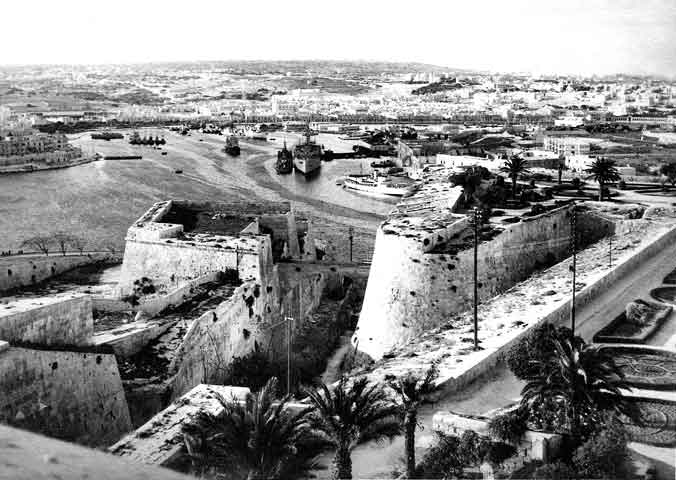
Sliema Creek from St John's Cavalier Mar48. Sliema is a town located on the northeast coast of Malta. It is a centre for shopping, restaurants and café life. Tas-Sliema is also a major commercial and residential area and houses several quality hotels. Tas-Sliema, which means 'peace, comfort', was once a quiet fishing village on the peninsula across Marsamxett Harbour from Valletta. Now Tas-Sliema and the coastline up to neighbouring St. Julian's constitutes Malta's main coastal resort; as a result, Sliema has been ringed with modern apartment blocks and become engorged with traffic in recent decades causing protest from the Sliema Residents Association. In 1881 the first sea water distillery on the island was erected in Sliema in order to provide water to the British barracks on the Tigne Seafront. In 1882 the distillery was decommissioned and the building, whichhhhhhhhhhhhhhhhhh still stands today, has been occupied by a printing press since that time. The barracks it supplied water to were demolished in 2001 in order to make way for the development of Tigne Point. The town has a considerable number of streets connected with the British era in Malta, such as Norfolk Street, Amery Street, Windsor Terrace, Graham Street, Milner Street and Fort Cambridge. Located next to the City Gate, St John's Cavalier, like its twin St James Cavalier, was built as part of the city fortifications. Nine Cavaliers were planned following the 1565 Siege, only these two were built. Constructed in 1582 as a gun platform, St John's was also designed by military engineer Francesco Laparelli de Cortona and completed by the Maltese architect Gerolamo Cassar. Since 1968 it has been the embassy of the Sovereign Military Hospitaller Order of St John which, like the Vatican, is still recognized by some countries as a sovereign entity. Cultural exhibitions are also staged here. (Thanks to Wikipedia).
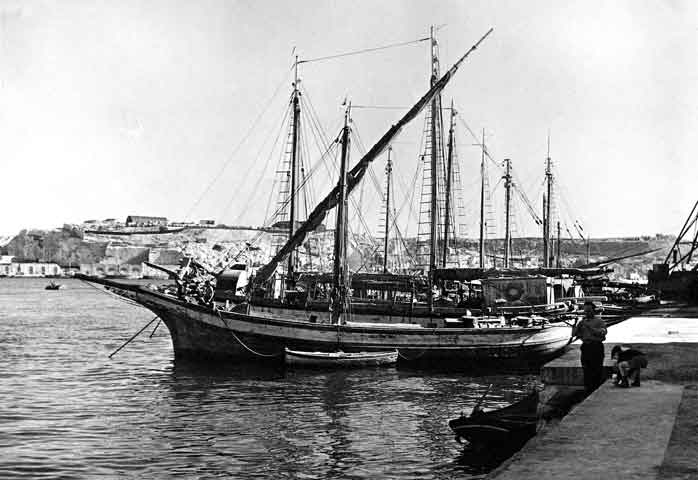
Italian fishing vessels in Grand Harbour, Malta.
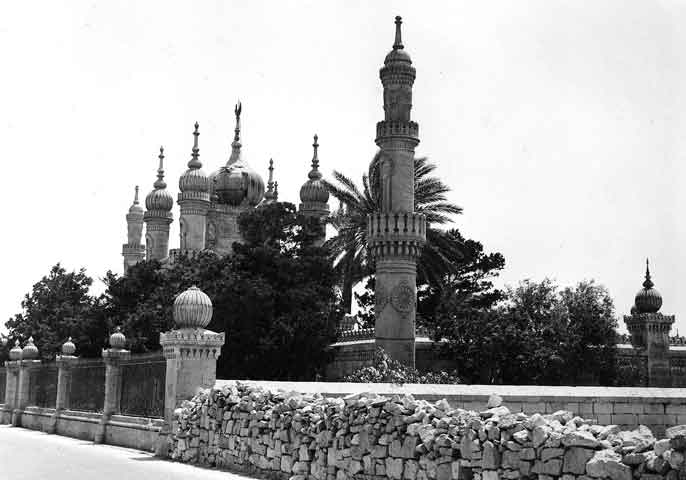 The Turkish Cemetery at Marsa - Jul48. On a visit to Malta in 1867 the Turkish Sultan Abdul Aziz presented Emmanuel Luigi Galizia (1830 - 1906), the Chief Government Architect, with the Order of the Mejidie. He also financed the building of the Turkish cemetery at Marsa which was designed by Galizia and completed in 1874. For this commission he based his design on Persian-Indian architecture. Islam came to Malta as early as the ninth century. When the Turks invaded Malta in 1565, they camped out in Marsa because of its harbour facilities and water supplies. Many died there though, because the wells had been poisoned in advance of their arrival. Since then, Muslims from a number of Arab countries have come to the islands with different intentions, and have received warmer welcomes. Galizia's travels in Cyprus, where the British twice sent him to report on the feasibility of a Maltese settlement, must have helped him to design this "fine example of Moorish architecture" (Zammit 233). He evidently enjoyed the style, turning to it again in the houses he built in the fashionable town of Sliema - one of which was for his own use. Muslims are very much in a minority in predominantly Roman Catholic Malta (about 1.2% of the population), and the cemetery is no longer used. (Thanks to Wikipedia).
The Turkish Cemetery at Marsa - Jul48. On a visit to Malta in 1867 the Turkish Sultan Abdul Aziz presented Emmanuel Luigi Galizia (1830 - 1906), the Chief Government Architect, with the Order of the Mejidie. He also financed the building of the Turkish cemetery at Marsa which was designed by Galizia and completed in 1874. For this commission he based his design on Persian-Indian architecture. Islam came to Malta as early as the ninth century. When the Turks invaded Malta in 1565, they camped out in Marsa because of its harbour facilities and water supplies. Many died there though, because the wells had been poisoned in advance of their arrival. Since then, Muslims from a number of Arab countries have come to the islands with different intentions, and have received warmer welcomes. Galizia's travels in Cyprus, where the British twice sent him to report on the feasibility of a Maltese settlement, must have helped him to design this "fine example of Moorish architecture" (Zammit 233). He evidently enjoyed the style, turning to it again in the houses he built in the fashionable town of Sliema - one of which was for his own use. Muslims are very much in a minority in predominantly Roman Catholic Malta (about 1.2% of the population), and the cemetery is no longer used. (Thanks to Wikipedia).
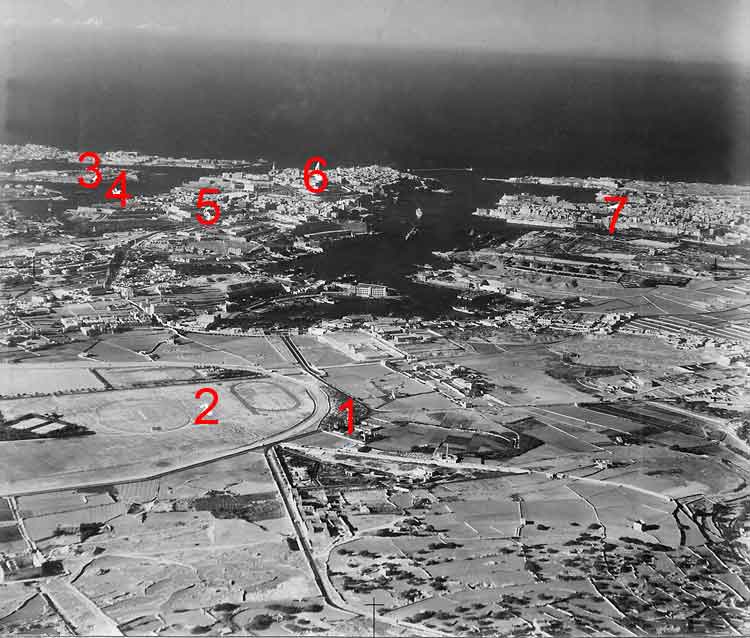
Key to Aerial View of the Grand Harbour, Malta: 1. Turkish and Jewish Cemetery; 2. Marsa Racetrack; 3. Manoel Island; 4. Sliema Creek;
5. Floriana (Port de Bombes (see next photo); 6. Valletta; 7. Conspicua.
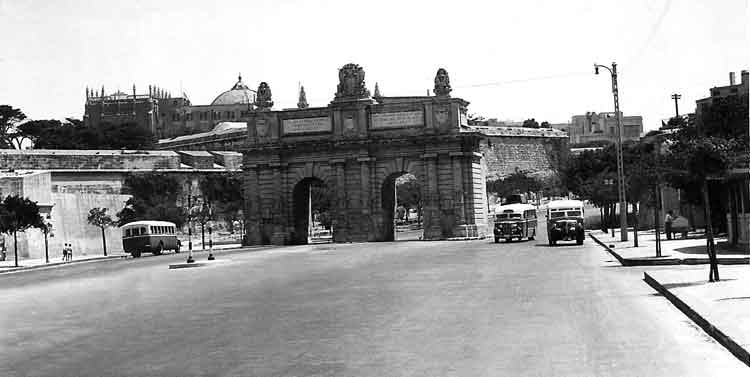
;Porte des Bombes' Floriana. The Porte des Bombes (Bieb il-Bombi) is an ornamental gate in the Floriana Lines, which formed the outer defensive walls of Valletta, Malta. It is situated between Pietà Creek and Marsa to the west and southeast, and the suburb of Floriana to the east. It was constructed in Baroque style between 1697 and 1720, during the reign of Fra Ramon Perellos y Roccaful, 64th Grandmaster of the Knights of Malta. Perellos' coat of arms appears above the gate. During the 19th century, the British government dramatically altered the original design of the gate by adding a second archway to accommodate increasingly heavy traffic in the Grand Harbour area. A marble plaque was affixed to the newer arch, with the following inscription: "Ad majorem popoli accomodatum". The short-lived Malta Railway once ran through a tunnel located near Porte des Bombes. On 24 October 2012, there was minor damage when an Arriva bus skidded into it and two other buses later crashed into the first bus. However the damaged part of the gate was rebuilt a few days later. (Thanks to Wikipedia).
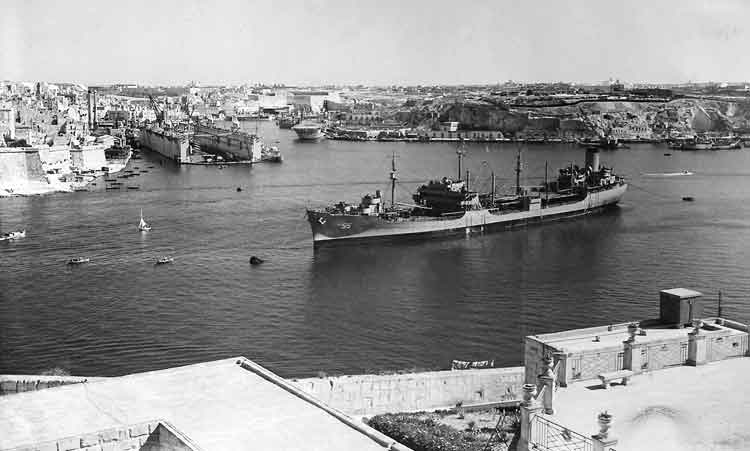 Grand Harbour, Valletta, Malta with dry dock and aircraft carrier. Grand Harbour (in Maltese: Il-Port il-Kbir) is a natural harbour on the island of Malta. It has been used as a harbour since at least Phoenician times. The natural harbour has been greatly improved with extensive docks and wharves, and has been massively fortified. The harbour mouth faces north east and is bounded to the north by St Elmo's Point and further sheltered by an isolated breakwater and is bounded to the south by Ricasoli Point. Its north west shore is formed by the Scebarras peninsula, which is largely covered by the city of Valletta and its suburb Floriana. This peninsula also divides Grand Harbour from a second parallel natural harbour, Marsamxett Harbour. The main waterway of Grand Harbour continues inland almost to Marsa. The south eastern shore of the harbour is formed by a number of inlets and headlands, principally Rinella Creek, Kalkara Creek, Dockyard Creek, and French Creek, which are covered by Kalkara and the Three Cities: Cospicua, Vittoriosa, and Senglea. With its partner harbour of Marsamxett, Grand Harbour lies at the centre of gently rising ground. Development has grown up all around the twin harbours and up the slopes so that the whole bowl is effectively one large conurbation. Much of Malta's population lives within a three kilometer radius of Floriana. This is now one of the most densely populated areas in Europe. The harbours and docks are still active but with the departure of the British Military the harbour lost much of its military significance. A considerable part of Malta's commercial shipping is now handled by the new free port at Kalafrana, so the harbour is much quieter than it was in the first half of the 20th century. (Thanks to Wikipedia).
Grand Harbour, Valletta, Malta with dry dock and aircraft carrier. Grand Harbour (in Maltese: Il-Port il-Kbir) is a natural harbour on the island of Malta. It has been used as a harbour since at least Phoenician times. The natural harbour has been greatly improved with extensive docks and wharves, and has been massively fortified. The harbour mouth faces north east and is bounded to the north by St Elmo's Point and further sheltered by an isolated breakwater and is bounded to the south by Ricasoli Point. Its north west shore is formed by the Scebarras peninsula, which is largely covered by the city of Valletta and its suburb Floriana. This peninsula also divides Grand Harbour from a second parallel natural harbour, Marsamxett Harbour. The main waterway of Grand Harbour continues inland almost to Marsa. The south eastern shore of the harbour is formed by a number of inlets and headlands, principally Rinella Creek, Kalkara Creek, Dockyard Creek, and French Creek, which are covered by Kalkara and the Three Cities: Cospicua, Vittoriosa, and Senglea. With its partner harbour of Marsamxett, Grand Harbour lies at the centre of gently rising ground. Development has grown up all around the twin harbours and up the slopes so that the whole bowl is effectively one large conurbation. Much of Malta's population lives within a three kilometer radius of Floriana. This is now one of the most densely populated areas in Europe. The harbours and docks are still active but with the departure of the British Military the harbour lost much of its military significance. A considerable part of Malta's commercial shipping is now handled by the new free port at Kalafrana, so the harbour is much quieter than it was in the first half of the 20th century. (Thanks to Wikipedia).
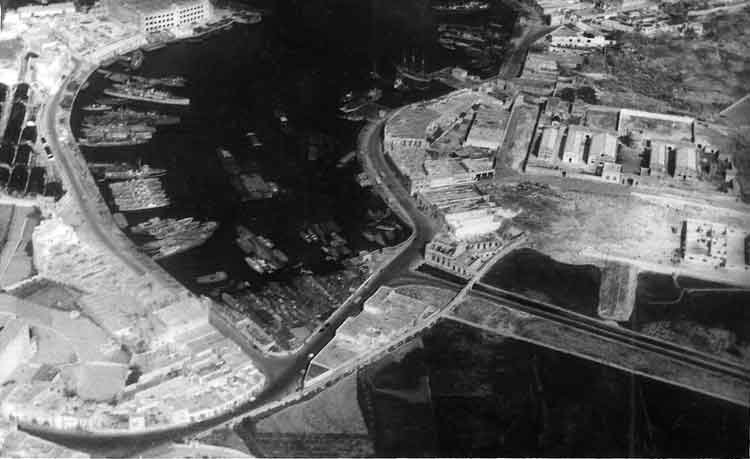
Aerial view of Grand Harbour.
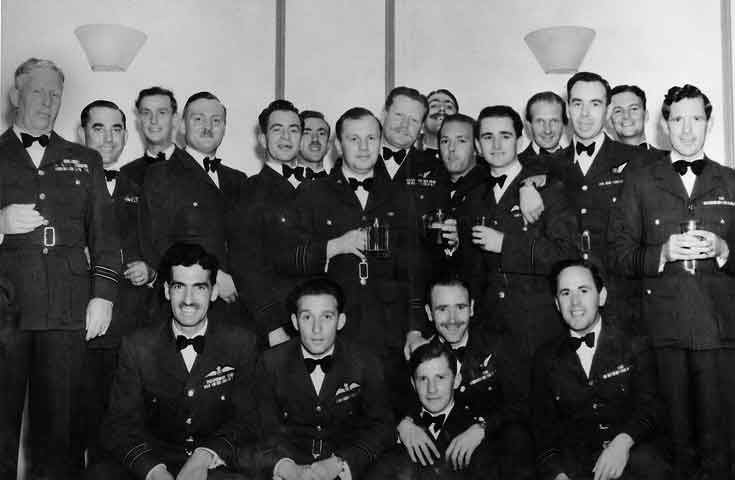 The officers have a dance. Presumably Officers' Mess, RAF Luqa, early 1948 - anyone able to add names?
The officers have a dance. Presumably Officers' Mess, RAF Luqa, early 1948 - anyone able to add names?
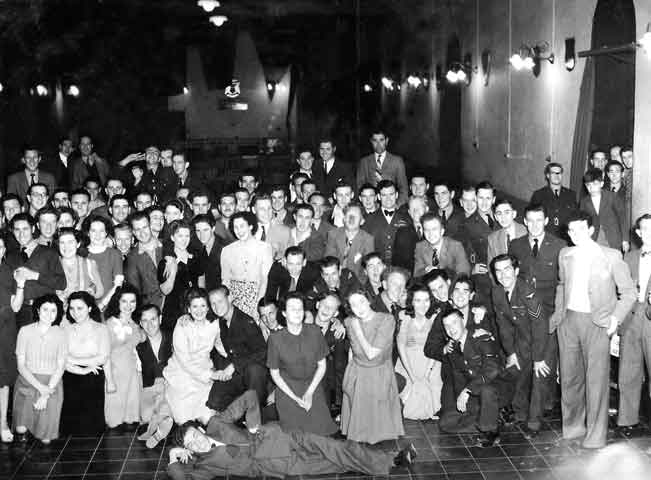
...then the 'Erks' have theirs!!!
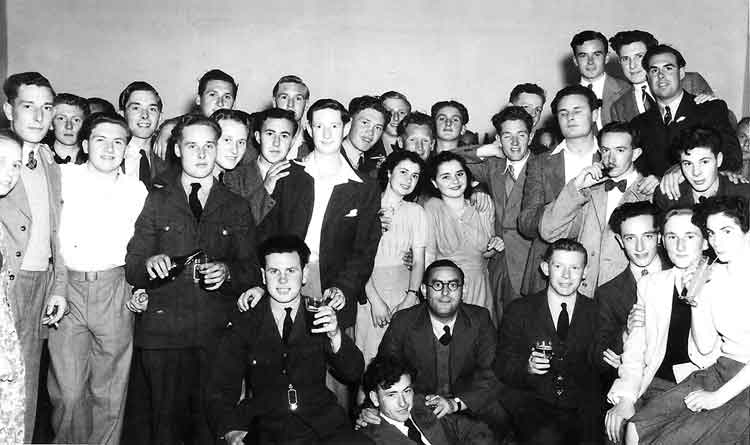
A group of the Signals dance, Queen's Hall, Sliema.
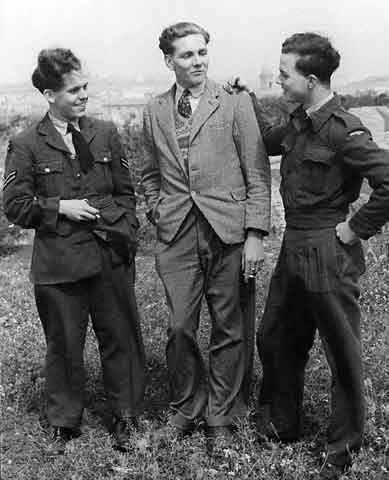
"Three Norwich Types". BeBe on right.
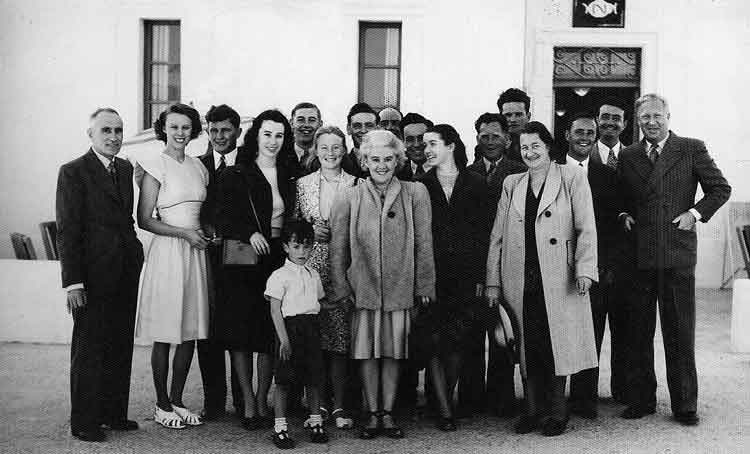 Group taken after the opening of the Ten Pot Inn by the AOC's wife - Mrs Steele - 12Apr48. Mrs Steele does not appear to be in this photo but the I think the AOC, Air Vice Marshal Sir Charles Ronald Steele KCB, DFC - Air Officer Commanding Malta, is on the far right. (Click to see). I can find no references for the "Ten Pot Inn" but presume it was a NAAFI type club for servicemen based at RAF Luqa?
Group taken after the opening of the Ten Pot Inn by the AOC's wife - Mrs Steele - 12Apr48. Mrs Steele does not appear to be in this photo but the I think the AOC, Air Vice Marshal Sir Charles Ronald Steele KCB, DFC - Air Officer Commanding Malta, is on the far right. (Click to see). I can find no references for the "Ten Pot Inn" but presume it was a NAAFI type club for servicemen based at RAF Luqa?
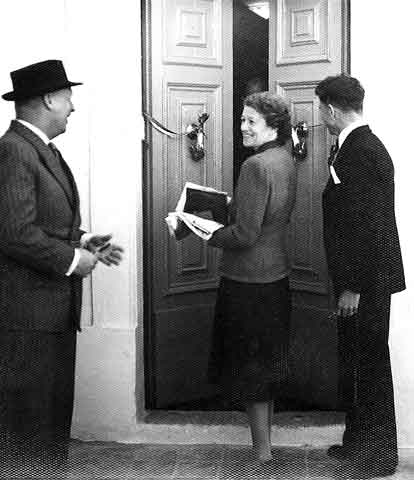
Mrs Steele, the AOC's wife formally opening the "Sealed Door" of the Ten Pot Inn - 12Apr48. The AOC is on the left.
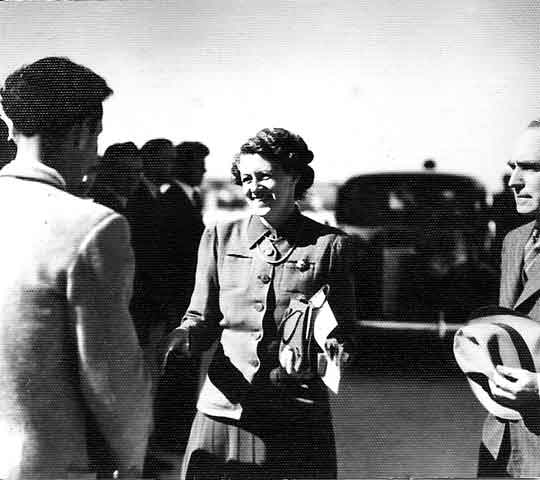
Mrs. Steele, the AOC's wife, being introduced at the formal opening of the "Ten Pot Inn" - 12Apr48.
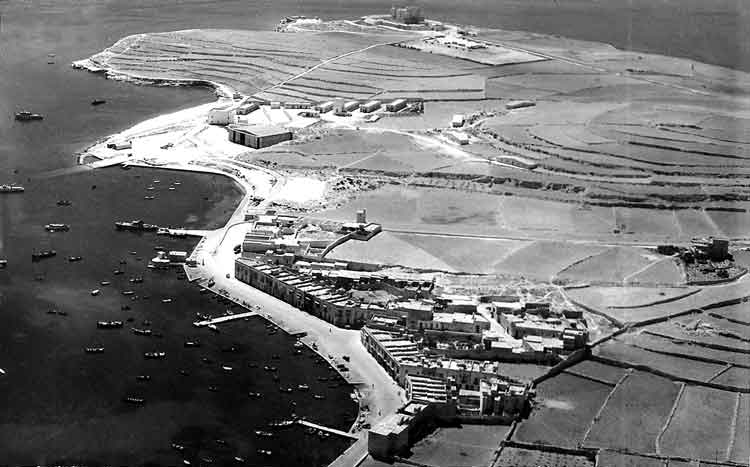
Aerial Views of Malts. Marsaxlokk is a traditional fishing village located in the south-eastern part of Malta, with a population of 3,277 people in Dec 2008. The village's name comes from Marsa, which means "port" and xlokk, which is the local name for south east. The word is related to the name for the dry sirocco wind that blows from the Sahara, comparable to the equivalent Catalan word, "xaloc". Marsaxlokk is about 35 minutes from Valletta by public bus No. 81. The village is approached via a long, narrow, straight road with vineyards on both sides. The bay is at the south-east end of the island and is memorable for the many colourful, traditional fishing boats called luzzu. The painted eyes on these luzzus are believed to protect the boats from danger. Tourists visit the town for the picturesque photo opportunities of the bay filled with colourful fishing boats, plethora of seafood restaurants and the very busy Sunday market that sells everything from fish, local produce and groceries to souvenirs,clothing and footwear. (Thanks to Wikipedia).
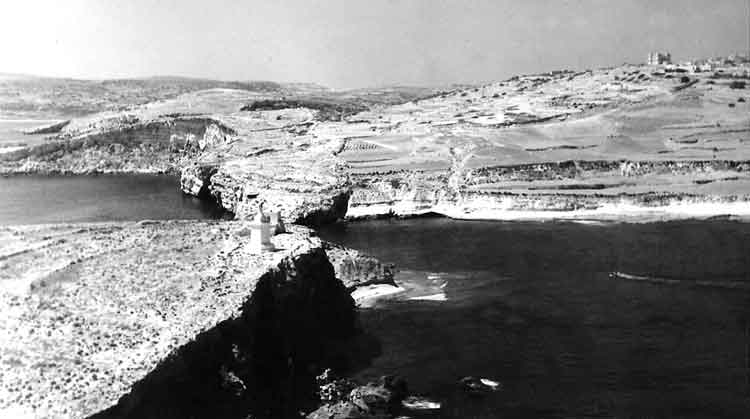 St Paul's Island, Malta. St. Paul's Island (also referred to as Selmunett) is a small island close to Selmun near the north-east of the island of Malta. St. Paul's Island is sometimes split into two islands when the sea is rough. It has been uninhabited since the sole farmer abandoned his tiny dwelling and fields decades ago, thus making it the largest uninhabited island of Malta. The Acts of the Apostles tell the story of how St Paul was shipwrecked on an island which some scholars have identified as Malta while on his way to Rome to face charges. Traditionally, St Paul's Bay and, specifically, St Paul's Island are identified as the location for this shipwreck. A prominent statue of the saint, erected in 1845, stands on the island. (Thanks to Wikipedia).
St Paul's Island, Malta. St. Paul's Island (also referred to as Selmunett) is a small island close to Selmun near the north-east of the island of Malta. St. Paul's Island is sometimes split into two islands when the sea is rough. It has been uninhabited since the sole farmer abandoned his tiny dwelling and fields decades ago, thus making it the largest uninhabited island of Malta. The Acts of the Apostles tell the story of how St Paul was shipwrecked on an island which some scholars have identified as Malta while on his way to Rome to face charges. Traditionally, St Paul's Bay and, specifically, St Paul's Island are identified as the location for this shipwreck. A prominent statue of the saint, erected in 1845, stands on the island. (Thanks to Wikipedia).
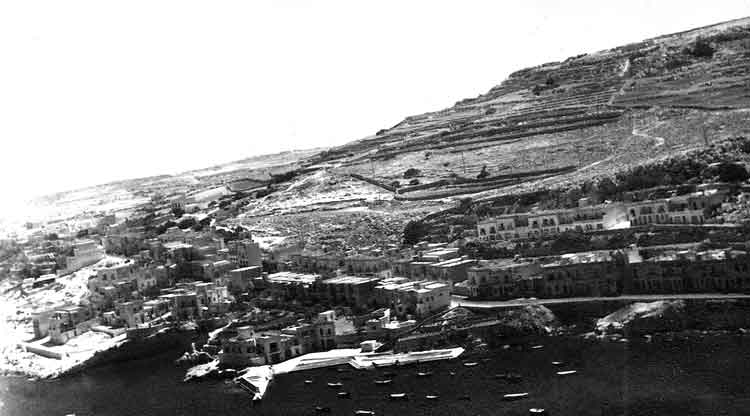
St Paul's Bay. Saint Paul's Bay (Maltese: San Pawl il-Bahar, Italian: Baia di San Paolo) is a town in Malta, situated in the north east of the island of Malta, sixteen kilometres from the capital city Valletta. Its name refers to the shipwreck of Saint Paul, as documented in the Acts of the Apostles, due to the tradition that Saint Paul was shipwrecked on the isles, named St. Paul's Isles, which are situated in St Paul's Bay. According to the Bible, St. Paul was shipwrecked on an island which many scholars have identified as Malta on his voyage from Caesarea to Rome. The Maltese people believe that it was St. Paul who laid the foundations of Christianity on the island. (Thanks to Wikipedia).
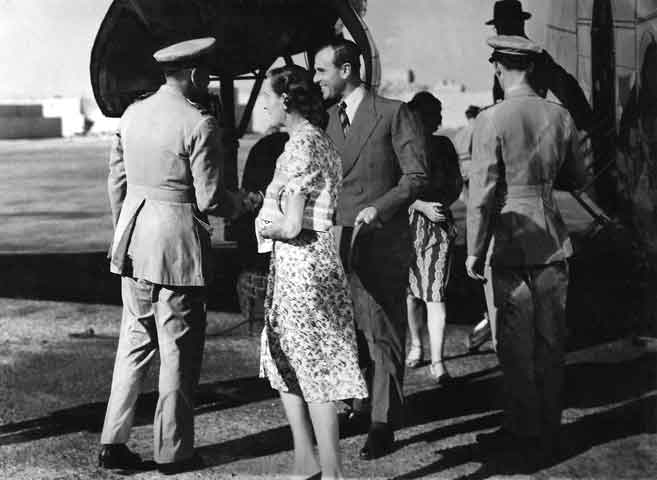
Lord Louis Mountbatten, with his wife Lady Edwina, arrives at Luqa in his personal aircraft, the Avro York, and is greeted by the AOC Air Vice-Marshal Charles Steele. Admiral of the Fleet Louis Francis Albert Victor Nicholas Mountbatten, 1st Earl Mountbatten of Burma, KG GCB OM GCSI GCIE GCVO DSO PC FRS (born Prince Louis of Battenberg; 25 June 1900 - 27 August 1979) - known informally as Lord Mountbatten - was a British statesman and naval officer, an uncle of Prince Philip, Duke of Edinburgh and second cousin once removed to Elizabeth II. He was the last Viceroy of India (1947) and the first Governor-General of the independent Union of India (1947-48), from which the modern Republic of India emerged in 1950. This visit probably took place shortly after he relinquished his role as Governor General of India. From 1954 until 1959 he was the First Sea Lord, a position that had been held by his father, Prince Louis of Battenberg, some forty years earlier. Thereafter he served as Chief of the Defence Staff until 1965, making him the longest serving professional head of the British Armed Forces to date. During this period Mountbatten also served as Chairman of the NATO Military Committee for a year. In 1979 Mountbatten, along with three other people, including a grandson Nicholas, was assassinated by the Provisional Irish Republican Army (IRA), who planted a bomb in his fishing boat, the Shadow V, at Mullaghmore, County Sligo, in Ireland. (Thanks to Wikipedia).
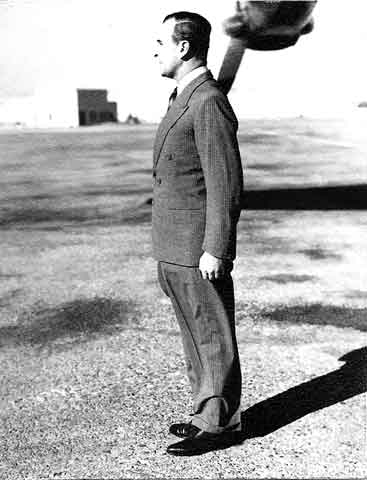
Admiral of the Fleet Louis Francis Albert Victor Nicholas Mountbatten, 1st Earl Mountbatten of Burma, KG GCB OM GCSI GCIE GCVO DSO PC FRS (born Prince Louis of Battenberg; 25 June 1900 - 27 August 1979) - known informally as Lord Mountbatten. After India, Mountbatten served as commander of the 1st cruiser squadron in the Mediterranean Fleet and, having been granted the substantive rank of vice admiral on 22 June 1949, he became Second-in-Command of the Mediterranean Fleet in April 1950. In June 1948 he hands over as Governor General to Rajaji Chakravarti Rajagopalachari and returns to a somewhat hostile England. Mountbatten returns to the Navy in Malta under the command of some of his former juniors, and sets about climbing the ladder to First Lord, via Vice Admiral, 1949; 4th Sea Lord, 1950; Commander in Chief, Mediterranean, 1952; and Commander in Chief, Allied forces, Mediterranean in 1953. He finishes his tour of command in Malta in December 1954. (Thanks to Wikipedia).
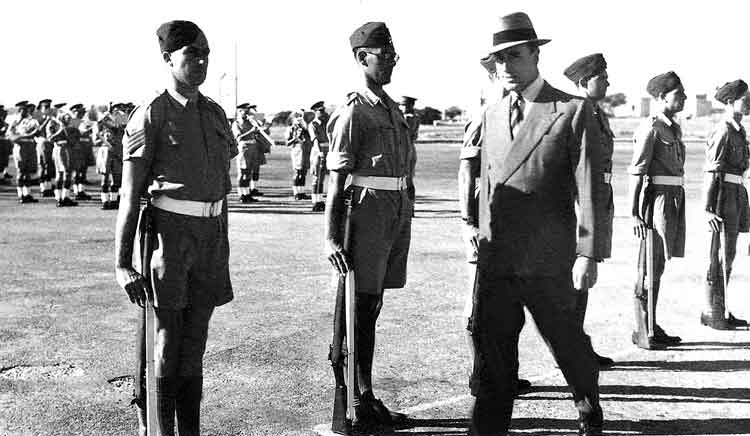
"Don't look at me like that, you civvy!" Lord Mountbatten inspects the troops at RAF Luqa.
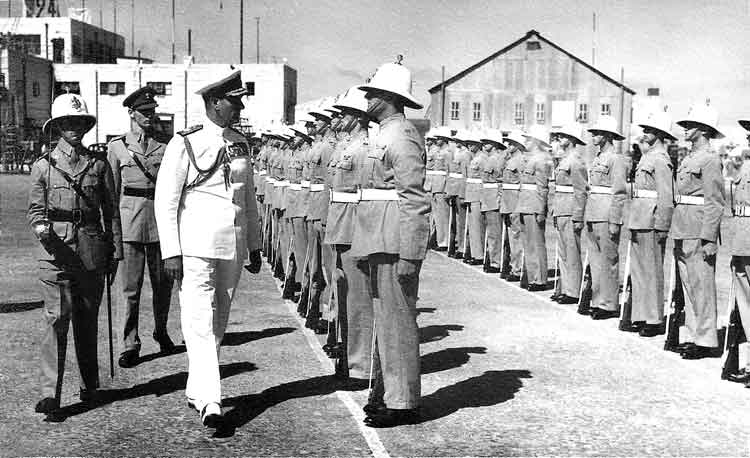 Lord Mountbatten, now dressed in his uniform, inspecting the Marines.
Lord Mountbatten, now dressed in his uniform, inspecting the Marines.
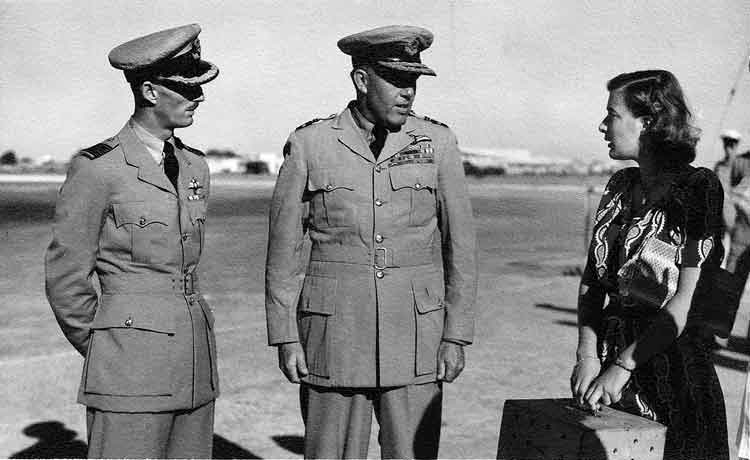
Group Captain Miller, the AOC Air Vice-Marshal Charles Steele and Pamela Mountbatten, Lord Mountbatten's daughter. It is interesting that she appears to be clutching an animal carrying case? Maybe she was bringing home a pet from India? Lady Pamela Carmen Louise Hicks (née Mountbatten; born 19 April 1929) is a British aristocrat. She is the younger daughter of the 1st Earl Mountbatten of Burma by his wife, Edwina Mountbatten. Through her father, Lady Pamela is a first cousin of Prince Philip, Duke of Edinburgh and a great niece of the last Tsarina of Russia, Alexandra Feodorovna. In May 2013, Lady Pamela is 687th in line for the throne. In 1947 Lady Pamela accompanied her parents to India remaining with them throughout her father's term as Viceroy of pre-Independence India and then Governor-General of post-Partition India through 1948, living with them in Government House, New Delhi and the summer Viceregal Lodge in Simla. This helps to confirm that they were on their way back to UK from India. In November 1947, Lady Pamela acted as a bridesmaid to then-Princess Elizabeth at her 1947 wedding to Prince Philip, Duke of Edinburgh (her first cousin). As lady-in-waiting to Princess Elizabeth she was with her and the Duke of Edinburgh in Kenya when King George VI died on 6 February 1952. In late 1953 and early 1954, she accompanied the Queen as lady-in-waiting on the royal tour to Jamaica, Panama, Fiji, Tonga, New Zealand, Australia, Ceylon, Aden, Libya, Malta and Gibraltar. Lady Pamela is the widow of interior decorator and designer David Nightingale Hicks (25Mar29-29Mar98), son of Herbert Hicks and Iris Elsie Platten. They were married on 13Jan60 at Romsey Abbey in Hampshire. The bridesmaids were Princess Anne, Princess Clarissa of Hesse (daughter of Princess Sophie of Greece and Denmark), Lady Amanda Knatchbull, Victoria Marten (god-daughter of the bride), and the Hon. Joanna Knatchbull (daughter of the bride's sister Patricia). Upon returning from honeymoon in the West Indies and New York she learned the death of her mother in Feb60. Together, the couple had three children: Edwina Victoria Louise Hicks (born 24Dec61); Ashley Louis David Hicks (born 18Jul63) and India Amanda Caroline Hicks (born 5Sep67). (Thanks to Wikipedia).
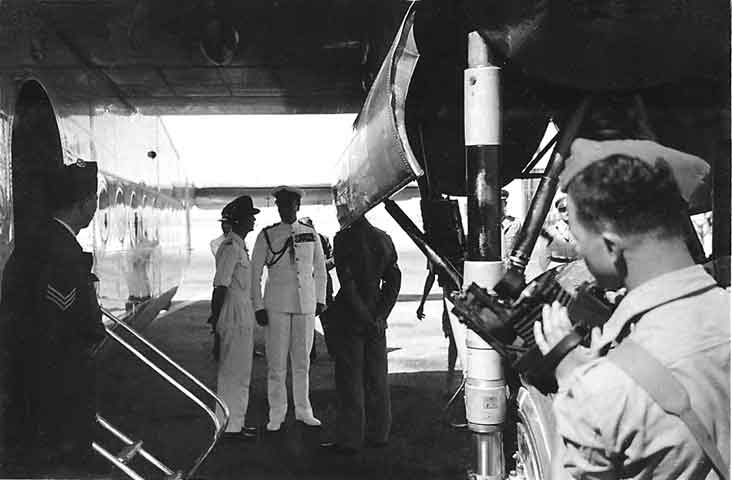
BeBe at Work! - Station Photographer on the right. Senior officers saying goodbye to Lord Mountbatten at his Avro York aircraft at RAF Luqa.
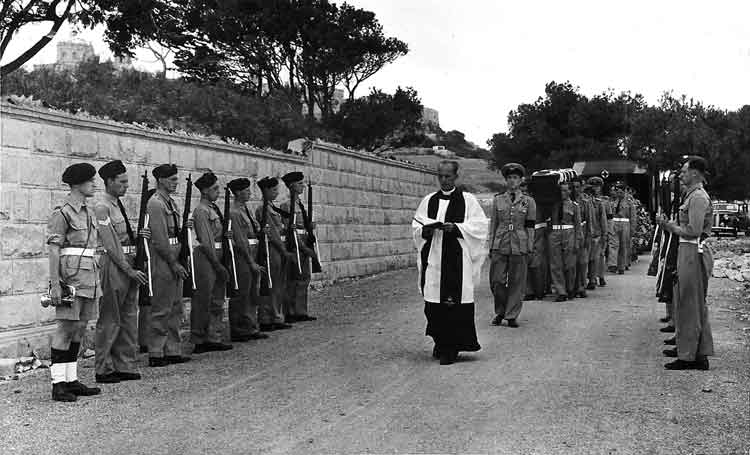
A Royal Air Force funeral - Leading Aircraftsman Heard. Padre Meadows leads the procession...
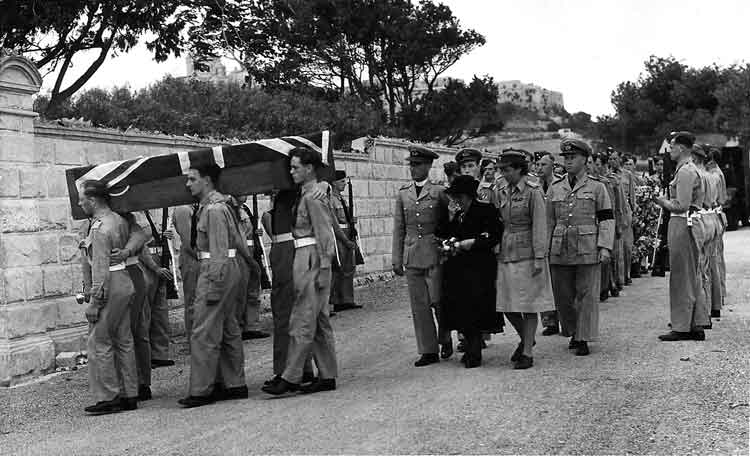
...His Mother follows.
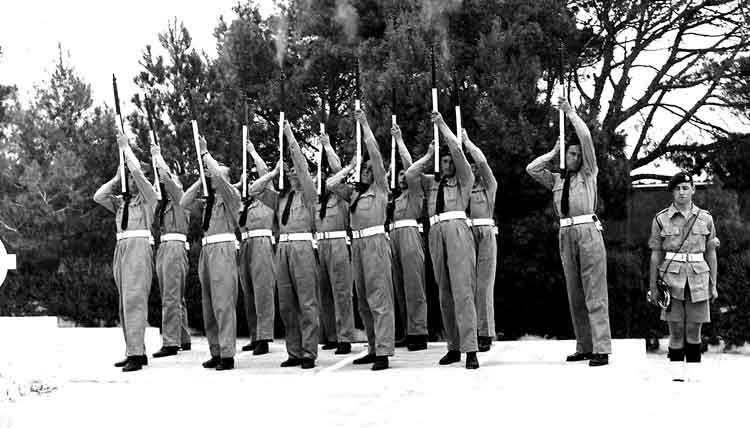
Firing the salute.
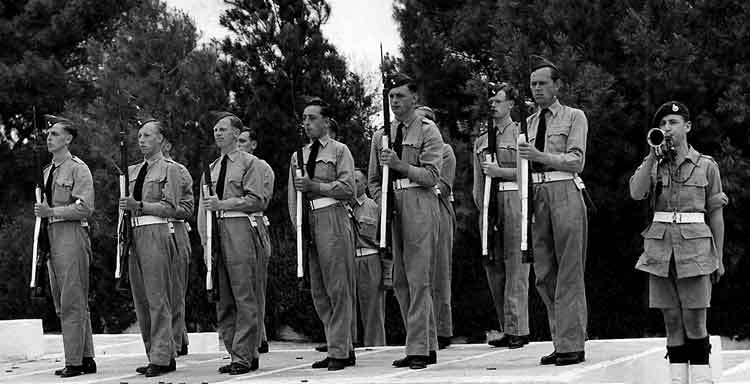 The Last Post.
The Last Post.
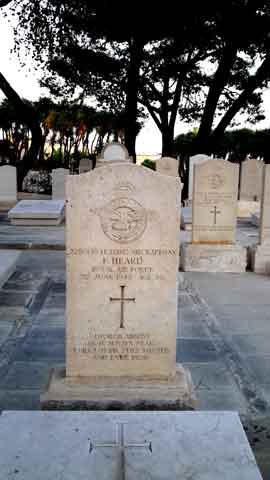
The headstone of his grave today.
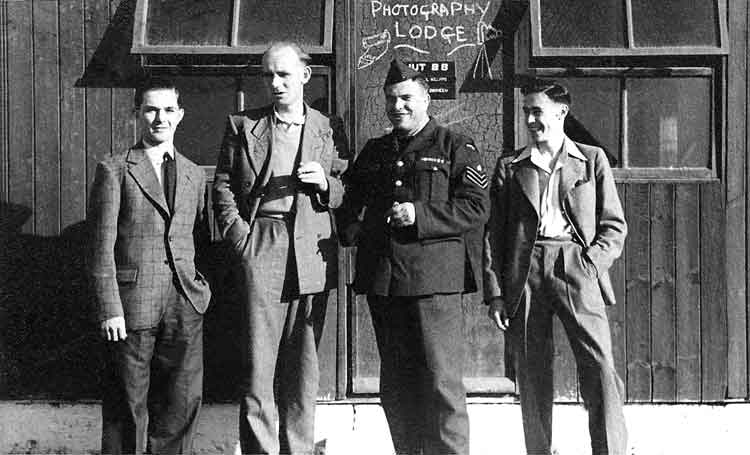
L to R: BeBe, Tosh Harris, Flt Sgt Dineen and Ron Trim outside the Photo Section at RAF Luqa.
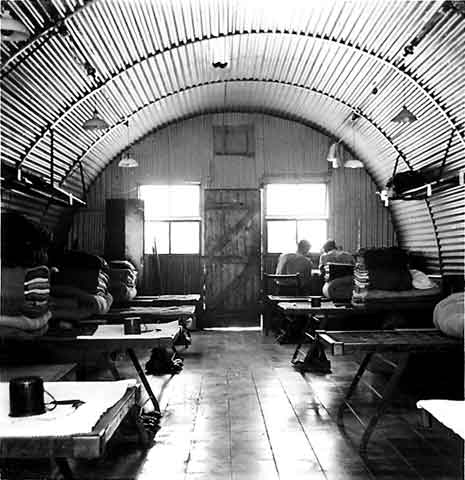
'B.S.' Billet on B.S. morning.
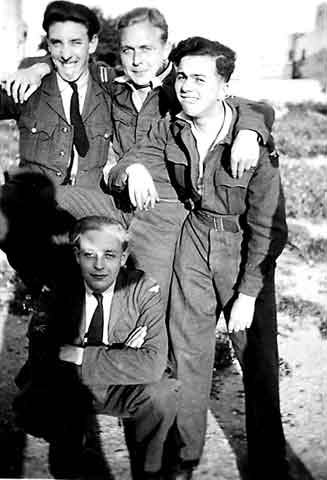
Acting the fool!- particularly BeBe on the right!
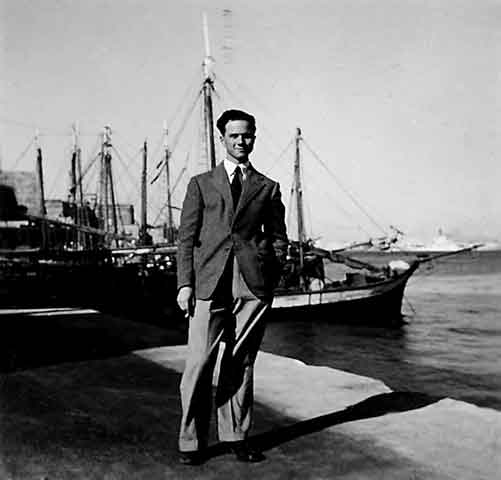
Spiv!
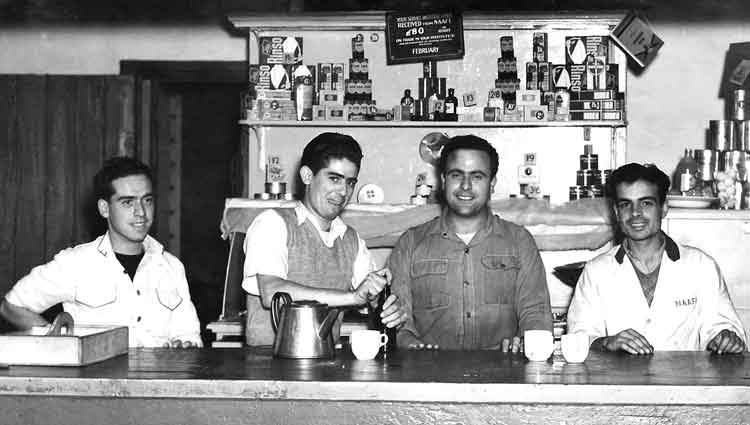
Luqa NAAFI types.
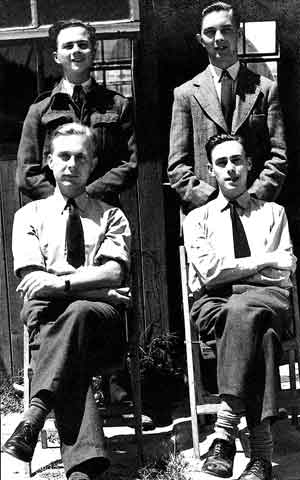
L to R: Back: Bebe and Tosh Harris; Front: Tony and Ron Trim.
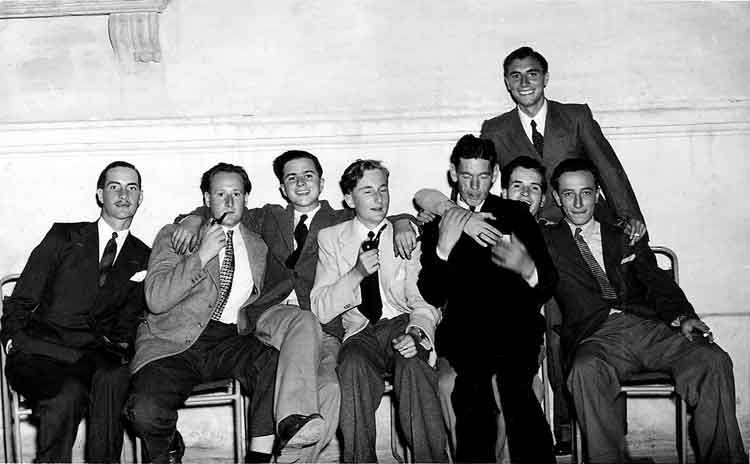
A dance at the Vernon Club. BeBe 3rd from left.
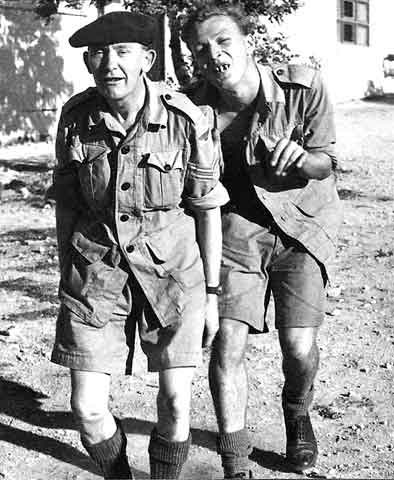
The two Geordies!! - almost sane
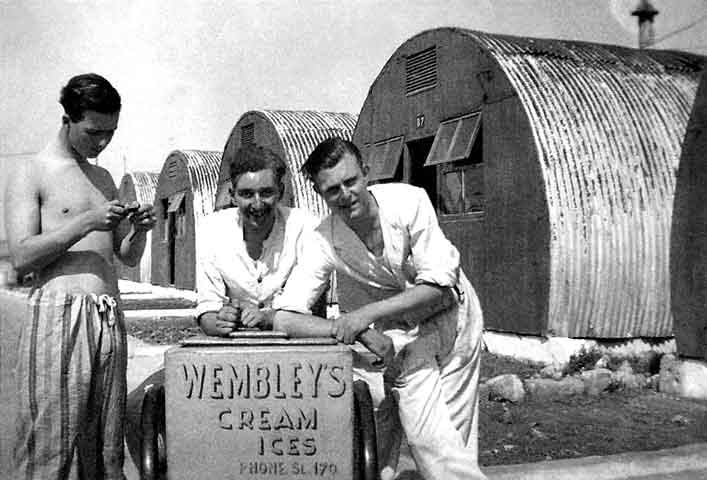
One Sunday morning. Bebe on the left.
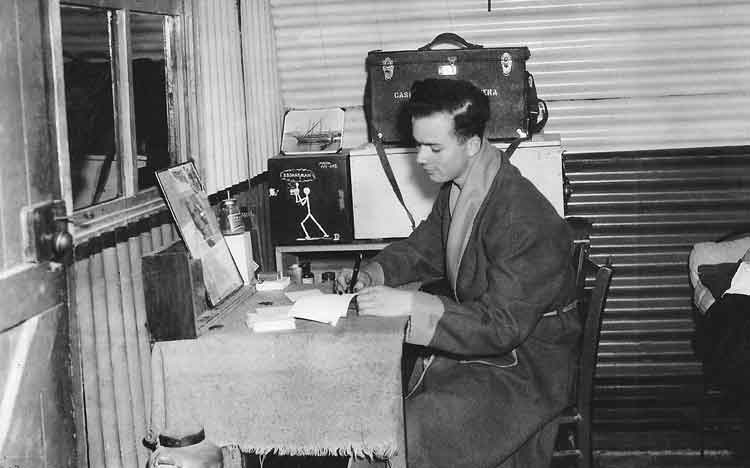 BeBe in just THE best bed space at Luqa - that's all!.
BeBe in just THE best bed space at Luqa - that's all!.
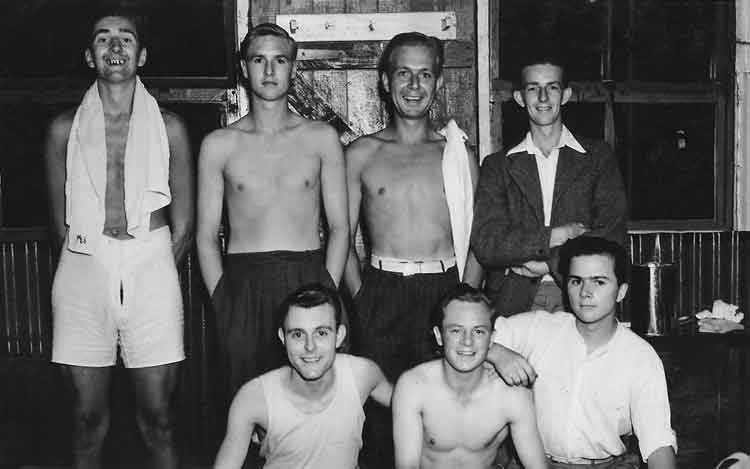 Billet photos - just a shower in B.8!!! BeBe front right.
Billet photos - just a shower in B.8!!! BeBe front right.
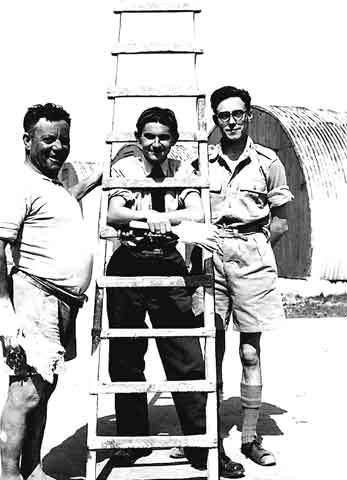
More snaps of friends.
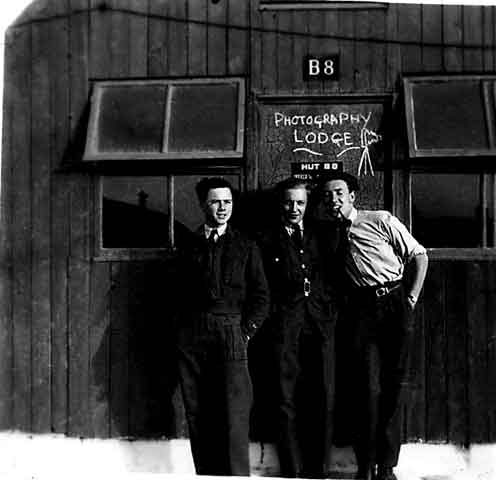
Billet B.8 and Photography Lodge.
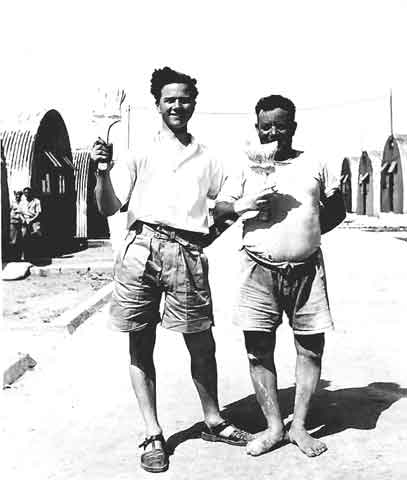
BeBe and friend.
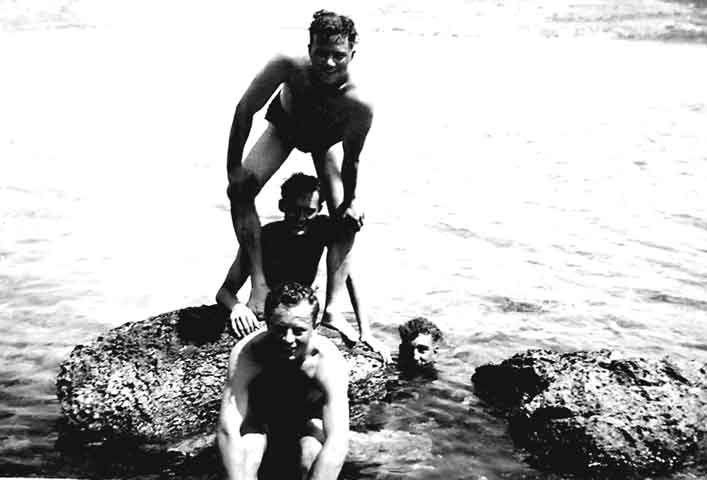
BeBe on top with two friends taking a day out at Mellieha. Mellieha ([m?'li?h?], or il-Mellieha) is a large village (pop. 7,221 in Dec 2008) in the northwestern part of Malta. It is a popular tourist destination during the summer months. Mellieha as a village developed under British colonization after the British encouraged people to settle in the area by giving leases to the population. For two centuries previously, the area was abandoned due to fear from attacks of corsairs and Saracens. Before that, only a few villagers lived in the area. (Thanks to Wikipedia).
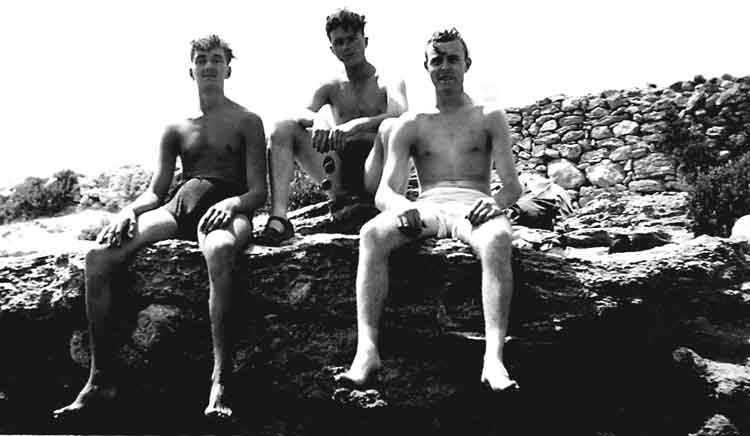
BeBe between two friends on a day out at Millieha.
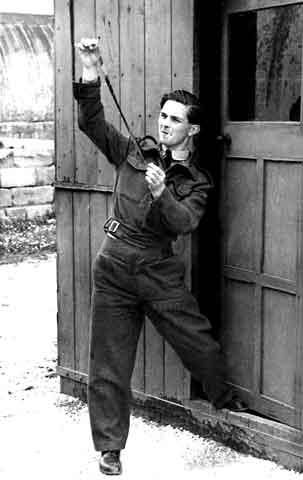
"What's on this 'ere then" - Tosh.
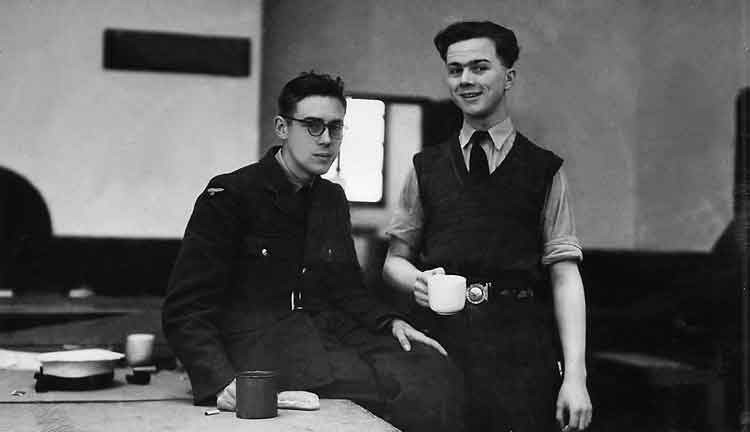
Ron Trim on left with BeBe having a NAAFI break.
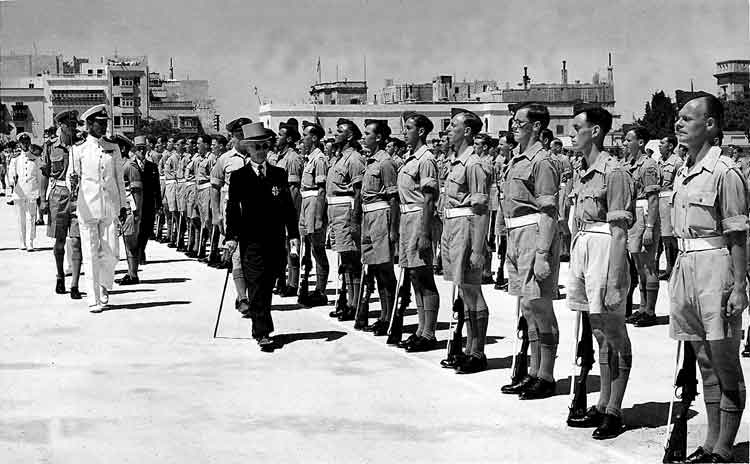
Inspection by civilian dignitary on the King's Birthday Parade. The Queen's Official Birthday (King's Official Birthday in the reign of a male monarch) is the selected day on which the birthday of the monarch of the Commonwealth realms (currently Queen Elizabeth II) is officially celebrated in those countries. The date varies as adopted by each Commonwealth country, but is generally around the end of May to the start of June, to coincide with a high probability of fine weather in the Northern Hemisphere for outdoor ceremonies. The sovereign's birthday was first officially marked in the United Kingdom in 1748. Since then, the date of the king or queen's birthday has been determined throughout the British Empire and later the Commonwealth according to either different royal proclamations issued by the sovereign or governor or by statute laws passed by the local parliament. The exact date of the celebration today varies from country to country and except by coincidence does not fall on the day of the monarch's actual birthday (that of the present monarch being 21 April). In some cases, it is an official public holiday, sometimes coinciding with the celebration of other events. Most Commonwealth realms release a Birthday Honours List at this time. The Queen's Official Birthday is now celebrated on the first, second, or third Saturday in June, although it is rarely the third. Edward VII, who reigned from 1901 to 1910, and whose birthday was on 9 November, in autumn, after 1908 moved the ceremony to summer in the hope of good weather. In 2013, it was celebrated on 15 June, and will be on 14 June in 2014. (Thanks to Wikipedia).
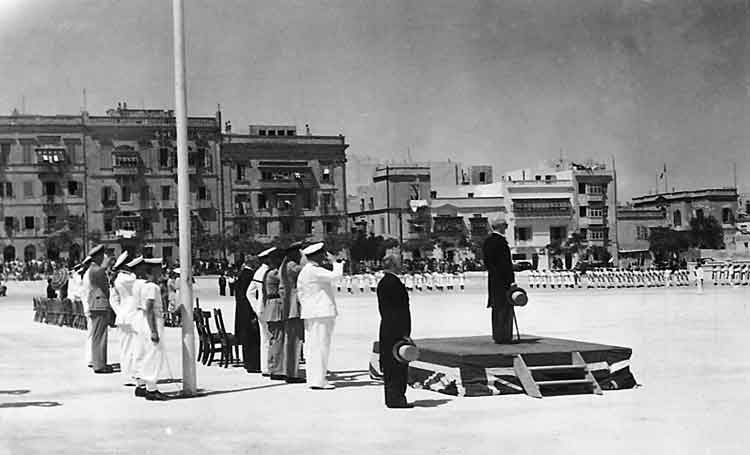 Taking the salute on the King's Birthday Parade - June 1948.
Taking the salute on the King's Birthday Parade - June 1948.
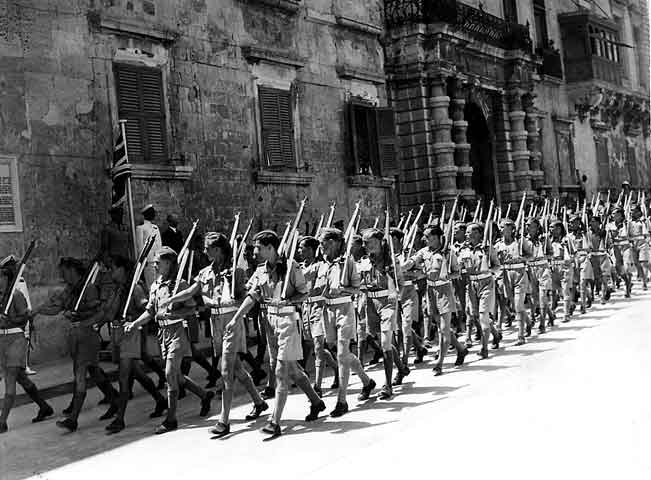
March Past in the town on the King's Birthday June 1948.
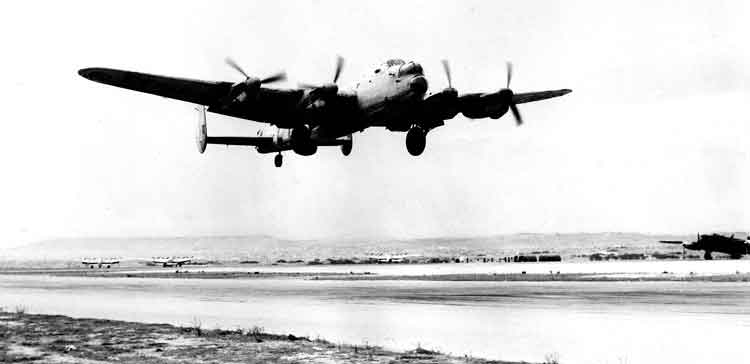
Lancaster GR.3 L for Love from 37 Squadron taking off from RAF Luqa, Malta - 1948. No. 37 Squadron reformed again in Palestine on 14Sep47 flying Lancasters in the maritime reconnaissance role until May 1948 when it moved to Malta. In Aug53 No. 37 converted to Shackletons and in Aug57 it moved to Aden where it flew patrols until it disbanded on 7Sep67.
Avro Lancaster
One of the most famous bomber aircraft of all time, the Avro Lancaster was developed from the Avro Manchester. While production of the Manchester was in progress, one airframe (BT308) was fitted with four Rolls-Royce Merlin XX engines. This was the prototype Lancaster, which first flew on 9Jan41 and was delivered to No. 44 (Rhodesia) Squadron at Waddington, Lincolnshire, in September that year. The first operational sortie with Lancasters was on 3Mar42, when four aircraft laid mines in the Heligoland Bight.
The second squadron to be equipped with Lancasters was No. 97, and in company with No. 44 it carried out a low-level daylight raid on the MAN factory in Augsburg, Bavaria, which was manufacturing U-boat diesel engines. Seven out of the 12 Lancasters involved were lost. Sqn. Ldr. Nettleton, one of 44's flight commanders, was awarded the VC for his role in the raid.
As an insurance against possible interruption in supplies of Merlins, it was decided to equip some Lancasters with four 1,231 kW (1,650 hp) Bristol Hercules 6 (or 16) radials in place of the Merlin XX. These aircraft becoming the Lancaster Mk. II. Several Mks. I and II were used for experimental work, particularly as engine testbeds. One of the Mk.I experimental aircraft, ED817, had its fuselage underside modified to accommodate development rounds of the special mine used in the famous raid by No. 617 Squadron on the Ruhr dams in May 1943.
Little modification was made to the basic Lancaster airframe during its life, a testimony to its sturdiness and reliability, and as a result very little extra work was necessary when the Mk. III with Packard-built Merlin engines superseded the Mk. I on the production lines.
Deployment of the Lancaster Mk. III enabled Bomber Command to use a 3,624 Kg (8,000 lb) bomb, then the 5,436 Kg (12,000 lb) 'Tallboy', and finally the 9,966 Kg (22,000 lb) 'Grand Slam', recessed in the doorless bomb bay. The last Lancaster raid of the war was carried out against an SS barracks at Berchtesgaden on 25Apr45. During the war Lancasters flew 156,192 sorties, dropping 618,380 tonnes (608,612 tons)of bombs. Losses in action were 3,431 aircraft, a further 246 being destroyed in operational accidents. At peak strength in Aug44, no fewer than 42 Bomber Command squadrons were armed with the Lancaster. Towards the end of the war in Europe, plans were made for the large scale use of Lancasters and Lincolns against Japan, the intention being to convert some Lancasters as flight refuelling tankers. Extensive trials were carried out by Flight Refuelling Ltd and a great deal of flight refuelling equipment had already been manufactured when the war ended and the project was abandoned. The much modified Lancasters Mks. IV and V became the Lincoln Mks. I and II. The Mk. VI, nine of which were converted from Mks. I and II, were equipped for electronic countermeasures.
The last production Lancaster was the Mk. VII, 180 of which were built by Austin Motors. The Mks. VIII and IX were never built and the Mk. X was a licence-built Mk. III, 422 being produced by the Victory Aircraft Co. of Canada.
Some Lancasters were converted as RAF and later BOAC transports, with faired over turrets. Lancasters remained in service with RAF Bomber Command for some time after World War II until replaced by the Avro Lincoln, and RAF Coastal Command used the GR.3 maritime patrol version until this was replaced by the Avro Shackleton. Avro re-furbished 54 Mk. Is and VIIs and converted them to the maritime patrol role for use by France's Aeronavale, and other Mk. Is were converted for photographic survey work as PR. MK. I. Some Lancasters were converted to the civil air transport role as the Lancastrian. Total Lancaster production, all variants, was 7,374 aircraft.
Specification refers to the Lancaster Mk. III:
Crew: 7; Powerplant: four 1,233 KW (1,640 hp) Rolls-Royce Merlin 28 or 38 12-cylinder V-type engines; Performance: max speed 462 Km/h (287 mph); range 2,784 Km (1,730 miles) service ceiling 5,790 m (19,000 ft) Dimensions: wingspan 31.09 m(102 ft); length 21.18 m (69 ft 6 in); height 6.25 m (20 ft 6 in). Weight: 29,484 Kg (65,000 lb) loaded. Armament: two 7.7 mm (0.303 in) machine gun in nose turret, two in dorsal turret and four in tail turret; maximum internal bomb load 8,165 Kg (18,000 lb). (Thanks to The Encyclopedia of Aircraft edited by Robert Jackson).
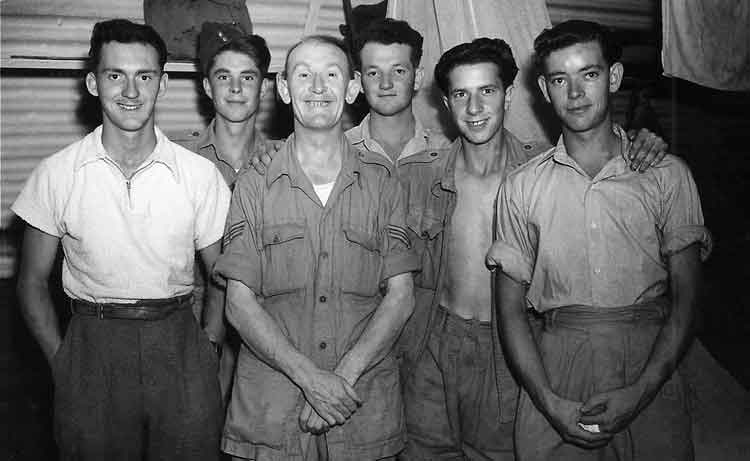
Testing a Flashbulb - L to R: J. Campbell, A. Brown, Geordie, Curly Warman, Pearson and Taffy.
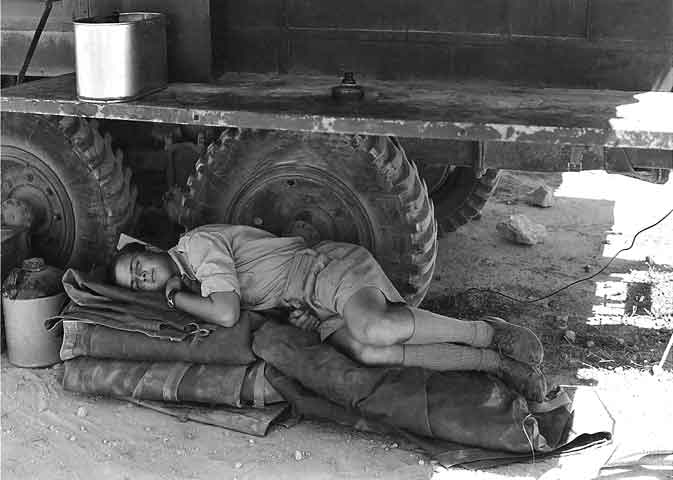
A slack day for BeBe.
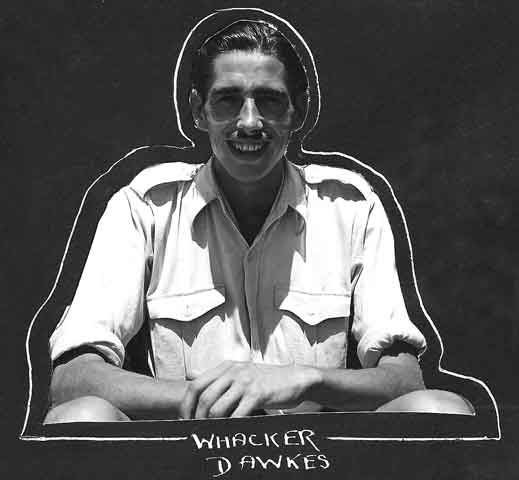
Whacker Dawes.
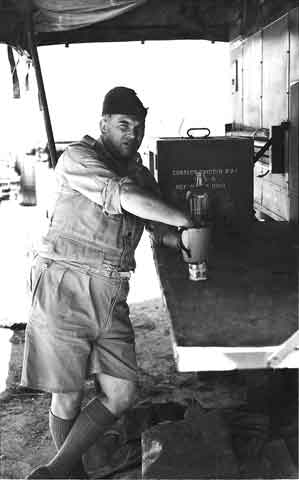
P,,,off with that Camera Sharman! - Flt. Sgt. Buggins
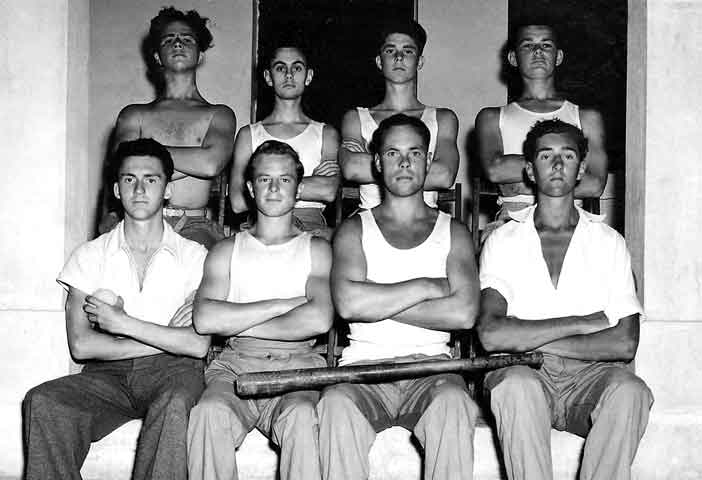
"Luqa Baseball Team - Period 1901'. L to R: Rear: BeBe, Hampton, Brown, Kemp; Front: Cambell, Howell, McCrory and Shaver.
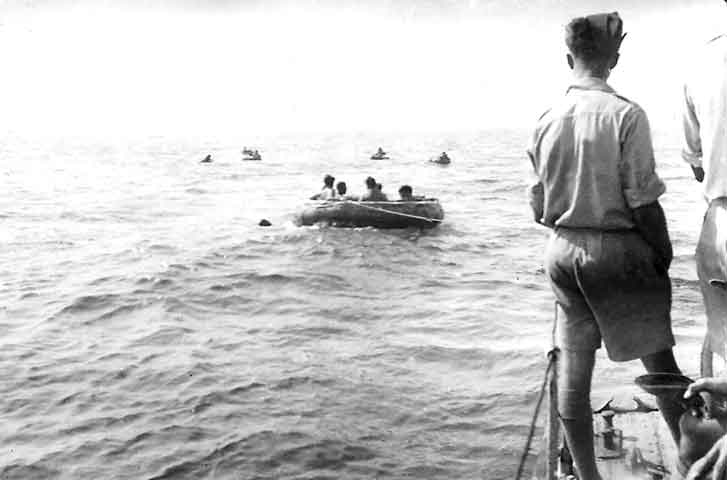
Air/Sea rescue exercises in the Med.
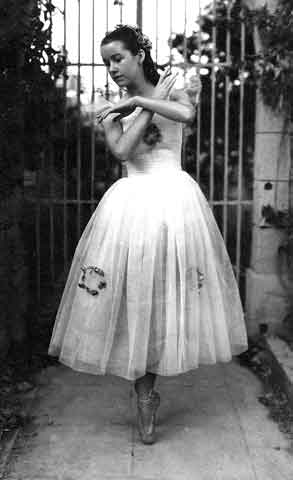
Sheila Lawson.
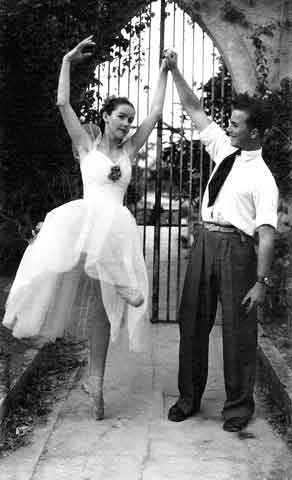
I must have a bash at this ballet! - Sheila and BeBe.
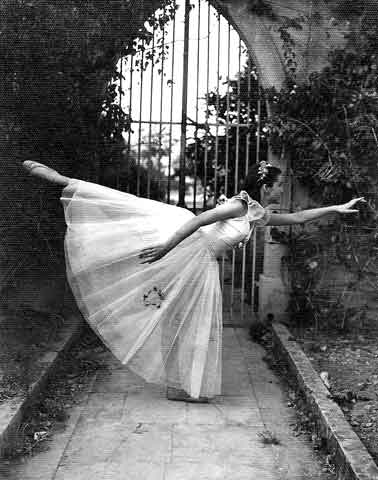
Well, Anyhow, I should fall over!
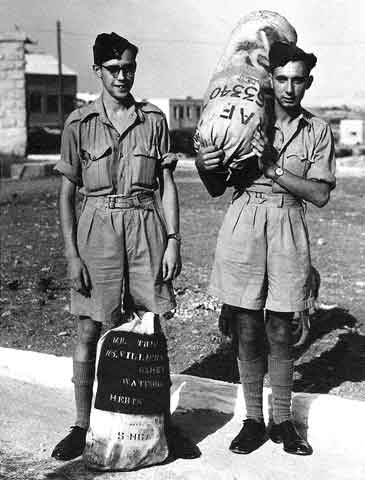
Ron Trim going home.
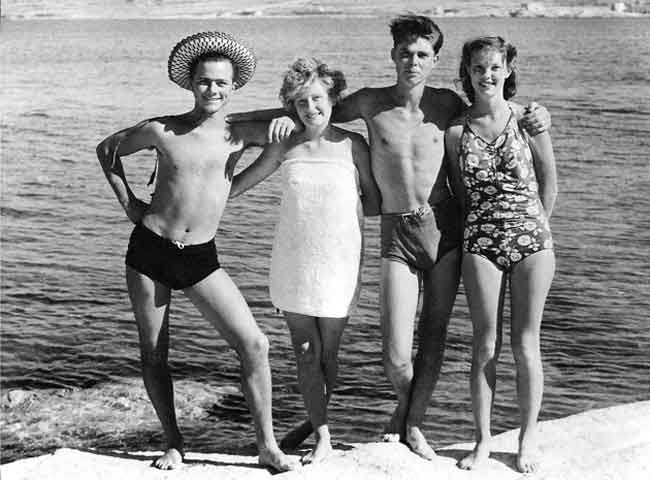
You know, Malta isn't so bad! A VERY fine Sunday afternoon. L to R: BeBe, Joyce Coe, Dave Brown and Margaret Newman.
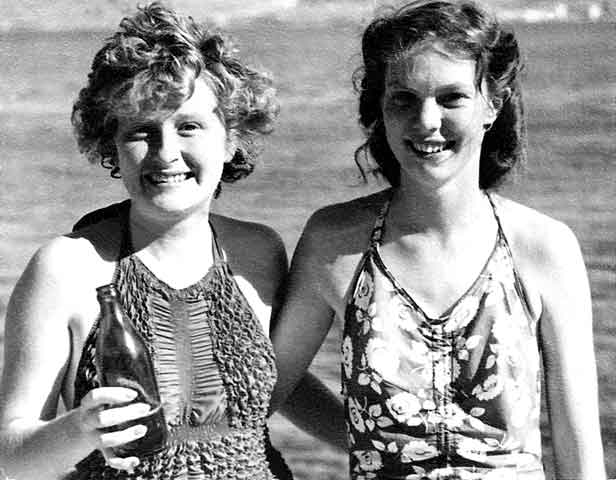
The Girls - L to R: Joyce Coe and Margaret Newman.
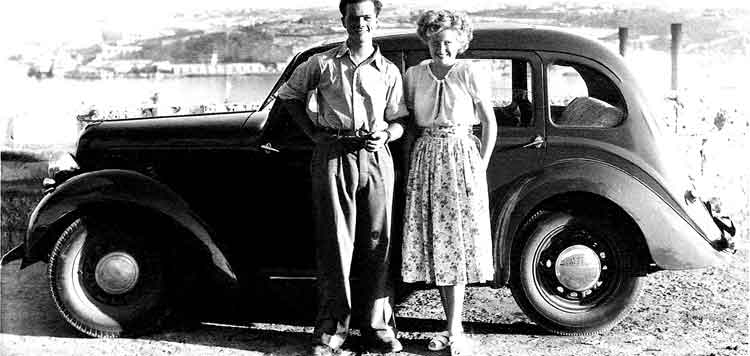
"Our car" - 1/c a mile : phew! BeBe and Joyce Coe.
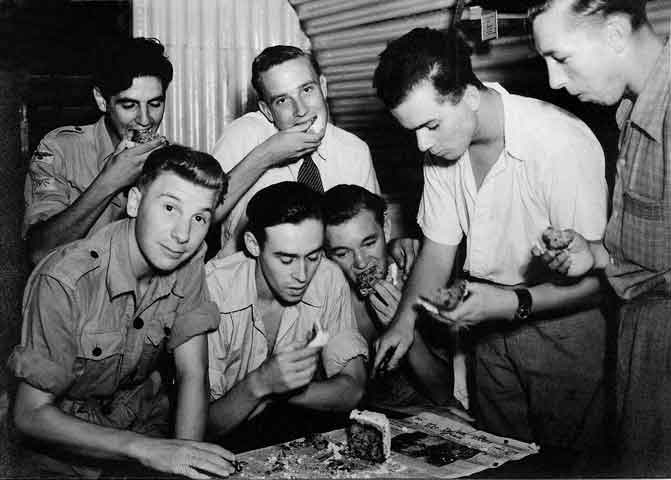
BeBe's 19th birthday cake.
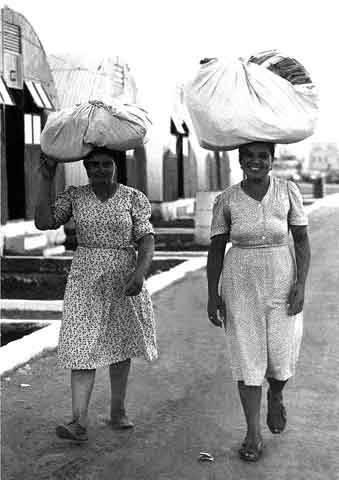
"Any washing?" - Liberty and her u/t.
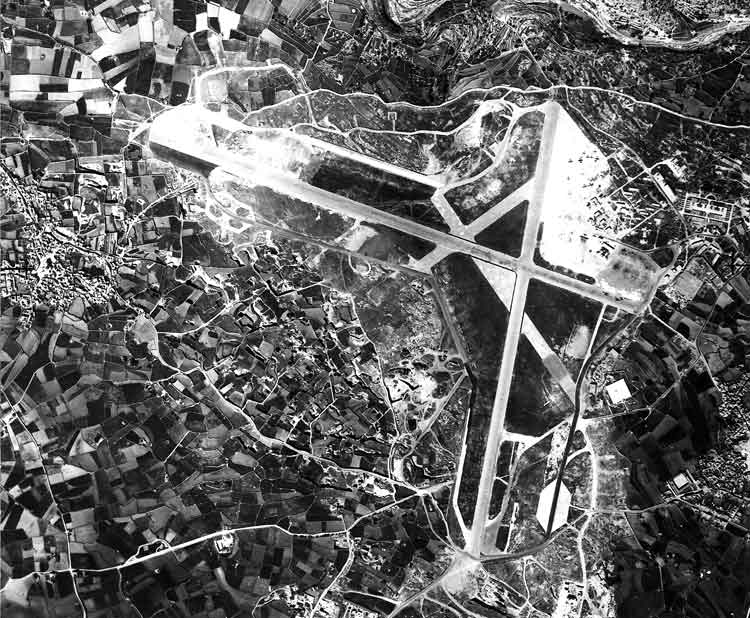
RAF Station Luqa, Malta from 9,000 ft, (5" lens f1).
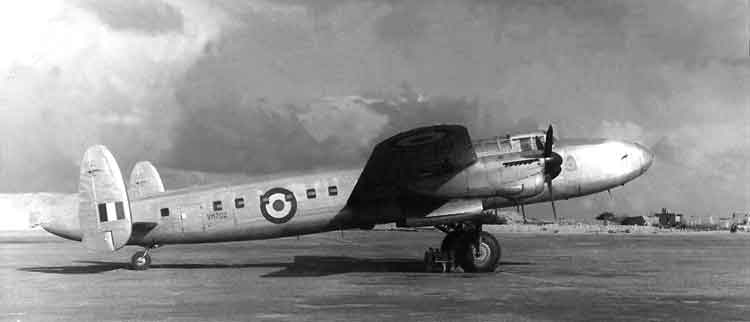
Avro Lancastrian at RAF Luqa - March 1948. The Avro 691 Lancastrian was a Canadian and British passenger and mail transport aircraft of the 1940s and 1950s developed from the Avro Lancaster heavy bomber. The Lancaster was named after Lancaster, Lancashire; a Lancastrian is an inhabitant of Lancashire. The Lancastrian was basically a modified Lancaster bomber without armour or armament and with the gun turrets replaced by streamlined metal fairings, including a new nose section. The initial batch was converted directly from Lancasters; later batches were new builds. In 1943, Canada's Victory Aircraft converted a Lancaster X bomber for civil transport duties with Trans-Canada Airlines (TCA). (After the war Victory Aircraft was purchased by what became Avro Canada). This conversion was a success resulting in eight additional Lancaster Xs being converted. The "specials" were powered by Packard-built Merlin 38 engines and featured a lengthened, streamlined nose and tail cone. Range was increased by two 400 gal (1,818 L) Lancaster long-range fuel tanks fitted as standard in the bomb bay. These Lancastrians were used by TCA on its Montreal-Prestwick route. The modification of abundant military aircraft into desperately needed civil transports was common in the United Kingdom in the immediate post-war period: the Handley Page Halton was a similar conversion of the Halifax heavy bomber. 1945, deliveries commenced of 30 British-built Lancastrians for BOAC. On a demonstration flight on 23 April 1945, G-AGLF flew 13,500 miles (21,700 km) from England to Auckland, New Zealand in three days, 14 hours at an average speed of 220 mph (354 km/h). The Lancastrian was fast, had a long range, and was capable of carrying a heavy load, but space inside was very limited as the Lancaster had been designed with space for its 7 crew dispersed through the fuselage, and the 33 ft (10.05 m) long bomb bay. Consequently it was not suited to carry large numbers of passengers, but for mail and a small number of VIP passengers. BOAC used it for flights between England and Australia from 31 May 1945. It also served with the RAF; RAF Lancaster I serial number PD328, was converted to a Lancastrian and renamed Aries, as well as serving with QANTAS and Flota Aérea Mercante Argentina. Lancastrians were used during the Berlin Airlift to transport petrol; 15 aircraft made over 5,000 trips. In 1946 a Lancastrian operated by BSAA was the first aircraft to make a scheduled flight from the then-newly opened London Heathrow Airport. Variants: Lancaster XPP Nine built by converting Lancasters at Victory Aircraft Ltd Canada. Lancastrian C.1 Nine-seat transport aircraft for BOAC and Qantas. Royal Air Force designation Lancastrian C.1 to Specification 16/44. A total of 23 built by Avro. Lancastrian C.2 Nine-seat military transport aircraft for the RAF. A total of 33 built by Avro. Lancastrian 3 13-seat transport aircraft for British South American Airways. A total of 18 built by Avro. Lancastrian C.4 Ten to 13-seat military transport aircraft for the RAF. Eight built by Avro. Specification (C.1): Crew: 5; Powerplant: 4 x Rolls-Royce Merlin 12 piston engine, 1,250 hp (930 kW) each; Capacity: 9 passengers; Payload: mail (3,560 kg) Length: 76 ft 10 in (23.4 m); Wingspan: 102 ft (31.1 m); Height: 19 ft 6 in (5.9 m); Wing area: 1,297 sq ft (120.5 sq m); Empty weight: 30,426 lb (13,800 kg); Loaded weight: 65,000 lb (29,480 kg); Performance: Maximum speed: 310 mph (500 km/h) at 5,000 ft (1,520 m); Range: 4,150 mi (6,680 km); Service ceiling: 23,000 ft (7,000 m); Rate of climb: 750 ft/min (230 m/min). (Thanks to Wikipedia).
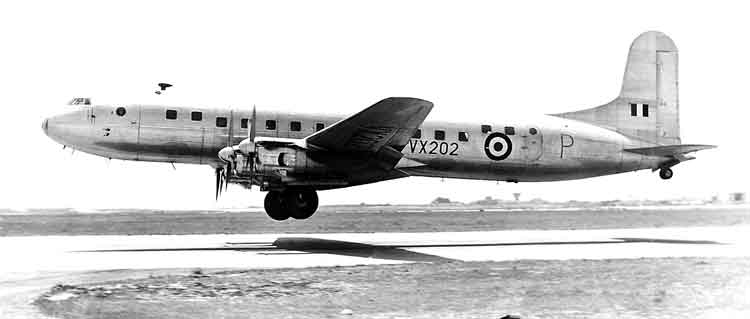 Avro 688 Tudor II taking off from RAF Luqa - June 1948. The second Tudor II to be completed, G-AGRY, went to Nairobi for tropical trials as VX202 (see this photo which may have been taken on its way to or from the trials), but these were unsatisfactory and Tudor II orders were reduced to 18. Eventually, only four Tudor IIs were completed including the prototype. Avro's Type 688 Tudor was a British piston-engined airliner based on their four-engine Lincoln bomber, itself a descendant of the famous Lancaster heavy bomber, and was Britain's first pressurised airliner. Despite having a reasonably long range, customers saw the aircraft as little more than a pressurised DC-4 Skymaster, and few orders were forthcoming, important customers preferring to buy US aircraft. The tailwheel undercarriage layout was also dated and a disadvantage. Avro began work on the Type 688 Tudor in 1943, following Specification 29/43 for a commercial adaptation of the Lancaster IV bomber, which was later renamed Lincoln. The specification was based on recommendations of the Brabazon Committee, which issued specifications for nine types of commercial aircraft for postwar use. Avro first proposed to build the Avro 687 (Avro XX), which was a Lincoln bomber with a new circular section pressurized fuselage and a large single fin and rudder in place of the predecessor's double ones. During the design stage, the idea of a simple conversion was abandoned and the Avro 688 was designed, which retained the four Rolls-Royce Merlin engines. It was designed by Roy Chadwick who, due to wartime restrictions, could not design a completely new aircraft, but had to use existing parts, tools and jigs. Using the Lincoln's wing, Chadwick, who had worked on the Lancaster, designed the Tudor to incorporate a new pressurized fuselage of circular cross-section, with a useful load of 3,765 lb (1,705 kg) and a range of 3,975 mi (6,400 km). Two prototypes were ordered in September 1944 and the first, G-AGPF, was assembled by Avro's experimental flight department at Manchester's Ringway Airport and first flew on 14Jun45. It was the first British pressurised civilian aircraft, although the prototype initially flew unpressurised. The prototype Tudor I had 1,750 hp (1,305 kW) Rolls-Royce Merlin 102 engines, but the standard engines were 1,770 hp (1,320 kW) Merlin 621s. Variants: All except the prototype built by Avro at their Chadderton factory and assembled and test flown from Woodford Aerodrome. 688 Tudor 1 Production variant, 12 built, later conversion to other variants. 689 Tudor 2 Stretched version, five built. 688 Tudor 3 Tudor 1 modified by Armstrong Whitworth Aircraft as executive transport aircraft. It could seat up to nine passengers, two built. 688 Tudor 4 Stretched version of the Tudor 1 (but not the same as the Tudor 2 with the fuselage lengthened by only 6 ft/1.83 m). It could seat up to 32 passengers, 11 built. 688 Tudor 4B As Tudor 4 but retained the Tudor 1's flight engineers station. Small number of Tudor 1s were converted into Tudor 4Bs. 689 Tudor 5 Tudor 2 for BSAA, powered by four 1,770 hp (1,320 kW) Rolls-Royce Merlin 621 piston engines, six built. One aircraft crashed in 1950 killing 80 in the Llandow Air Disaster. 689 Tudor 6 Ordered by the Argentinian airline FAMA, but the order was cancelled. None of the airframes were completed. 689 Tudor 7 Tudor 2 fitted with four 1,750 hp (1,305 kW) Bristol Hercules 120 radial piston engines, one prototype only. 688 Tudor 8 Jet-engined version of the Tudor 1. Tudor 1 VX195 was fitted with four Rolls-Royce Derwent Mk.V turbojet engines. Tudor 9 Jet-engined version of the Tudor 2, became the 706 Ashton. Super Trader 4B Re-engined version, fitted with four 1,760 hp (1,312 kW) Rolls-Royce Merlin 23 piston engines. Tudor Freighter 1 Freight and cargo version, three aircraft were used by BOAC during the 1949 Berlin Airlift. 711 Trader
Proposed freighter development of the Tudor 2 fitted with a tricycle landing gear; not built. Specifications: (Avro 688 Tudor 1) Data from Jane's Fighting Aircraft of World War II. Crew: 5 (two pilots, flight engineer, radio operator, navigator); Powerplant: 4 x Rolls-Royce Merlin 100 12-cylinder V12 engines, 1,770 hp (1,320 kW) each; Capacity: 24 passengers; Length: 79 ft 6 in (24.23 m) Wingspan: 120 ft 0 in (36.58 m); Height: 22 ft 0 in (6.71 m); Wing area: 1,421 sq ft (132 sq m); Loaded weight: 66,000 lb (30,000 kg); Max. takeoff weight: 76,000 lb (34,500 kg); Performance: Maximum speed: 320 mph (512 km/h) at 8,000 ft (2,440 m); Cruise speed: 283 mph (453 km/h) at 12,000 ft (3,660 m); Range: 3,630 mi (5,840 km); Service ceiling: 30,100 ft (9,180 m); Rate of climb: 990 ft/min (5 m/s); Wing loading: 53.5 lb/sq ft (261 kg/sq m). (Thanks to Wikipedia).
Avro 688 Tudor II taking off from RAF Luqa - June 1948. The second Tudor II to be completed, G-AGRY, went to Nairobi for tropical trials as VX202 (see this photo which may have been taken on its way to or from the trials), but these were unsatisfactory and Tudor II orders were reduced to 18. Eventually, only four Tudor IIs were completed including the prototype. Avro's Type 688 Tudor was a British piston-engined airliner based on their four-engine Lincoln bomber, itself a descendant of the famous Lancaster heavy bomber, and was Britain's first pressurised airliner. Despite having a reasonably long range, customers saw the aircraft as little more than a pressurised DC-4 Skymaster, and few orders were forthcoming, important customers preferring to buy US aircraft. The tailwheel undercarriage layout was also dated and a disadvantage. Avro began work on the Type 688 Tudor in 1943, following Specification 29/43 for a commercial adaptation of the Lancaster IV bomber, which was later renamed Lincoln. The specification was based on recommendations of the Brabazon Committee, which issued specifications for nine types of commercial aircraft for postwar use. Avro first proposed to build the Avro 687 (Avro XX), which was a Lincoln bomber with a new circular section pressurized fuselage and a large single fin and rudder in place of the predecessor's double ones. During the design stage, the idea of a simple conversion was abandoned and the Avro 688 was designed, which retained the four Rolls-Royce Merlin engines. It was designed by Roy Chadwick who, due to wartime restrictions, could not design a completely new aircraft, but had to use existing parts, tools and jigs. Using the Lincoln's wing, Chadwick, who had worked on the Lancaster, designed the Tudor to incorporate a new pressurized fuselage of circular cross-section, with a useful load of 3,765 lb (1,705 kg) and a range of 3,975 mi (6,400 km). Two prototypes were ordered in September 1944 and the first, G-AGPF, was assembled by Avro's experimental flight department at Manchester's Ringway Airport and first flew on 14Jun45. It was the first British pressurised civilian aircraft, although the prototype initially flew unpressurised. The prototype Tudor I had 1,750 hp (1,305 kW) Rolls-Royce Merlin 102 engines, but the standard engines were 1,770 hp (1,320 kW) Merlin 621s. Variants: All except the prototype built by Avro at their Chadderton factory and assembled and test flown from Woodford Aerodrome. 688 Tudor 1 Production variant, 12 built, later conversion to other variants. 689 Tudor 2 Stretched version, five built. 688 Tudor 3 Tudor 1 modified by Armstrong Whitworth Aircraft as executive transport aircraft. It could seat up to nine passengers, two built. 688 Tudor 4 Stretched version of the Tudor 1 (but not the same as the Tudor 2 with the fuselage lengthened by only 6 ft/1.83 m). It could seat up to 32 passengers, 11 built. 688 Tudor 4B As Tudor 4 but retained the Tudor 1's flight engineers station. Small number of Tudor 1s were converted into Tudor 4Bs. 689 Tudor 5 Tudor 2 for BSAA, powered by four 1,770 hp (1,320 kW) Rolls-Royce Merlin 621 piston engines, six built. One aircraft crashed in 1950 killing 80 in the Llandow Air Disaster. 689 Tudor 6 Ordered by the Argentinian airline FAMA, but the order was cancelled. None of the airframes were completed. 689 Tudor 7 Tudor 2 fitted with four 1,750 hp (1,305 kW) Bristol Hercules 120 radial piston engines, one prototype only. 688 Tudor 8 Jet-engined version of the Tudor 1. Tudor 1 VX195 was fitted with four Rolls-Royce Derwent Mk.V turbojet engines. Tudor 9 Jet-engined version of the Tudor 2, became the 706 Ashton. Super Trader 4B Re-engined version, fitted with four 1,760 hp (1,312 kW) Rolls-Royce Merlin 23 piston engines. Tudor Freighter 1 Freight and cargo version, three aircraft were used by BOAC during the 1949 Berlin Airlift. 711 Trader
Proposed freighter development of the Tudor 2 fitted with a tricycle landing gear; not built. Specifications: (Avro 688 Tudor 1) Data from Jane's Fighting Aircraft of World War II. Crew: 5 (two pilots, flight engineer, radio operator, navigator); Powerplant: 4 x Rolls-Royce Merlin 100 12-cylinder V12 engines, 1,770 hp (1,320 kW) each; Capacity: 24 passengers; Length: 79 ft 6 in (24.23 m) Wingspan: 120 ft 0 in (36.58 m); Height: 22 ft 0 in (6.71 m); Wing area: 1,421 sq ft (132 sq m); Loaded weight: 66,000 lb (30,000 kg); Max. takeoff weight: 76,000 lb (34,500 kg); Performance: Maximum speed: 320 mph (512 km/h) at 8,000 ft (2,440 m); Cruise speed: 283 mph (453 km/h) at 12,000 ft (3,660 m); Range: 3,630 mi (5,840 km); Service ceiling: 30,100 ft (9,180 m); Rate of climb: 990 ft/min (5 m/s); Wing loading: 53.5 lb/sq ft (261 kg/sq m). (Thanks to Wikipedia).
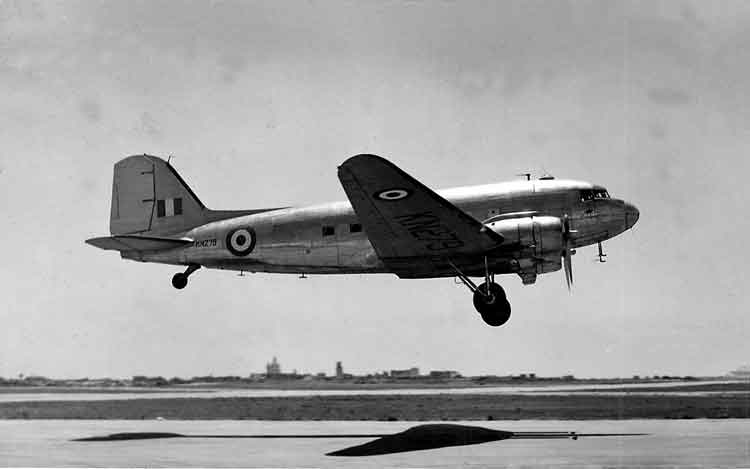 AOC's Douglas C-47 Dakota 279 takes off from RAF Luqa June 1948.
AOC's Douglas C-47 Dakota 279 takes off from RAF Luqa June 1948.
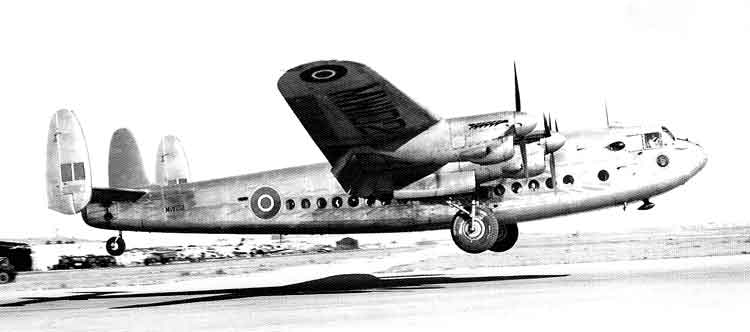
Earl Mountbatten's Avro 685 York MW102 landing at RAF Luqa June 1948. See earlier photographs of his visit above.
Avro 685 York: The Avro York was a British transport aircraft that was derived from the Second World War Lancaster heavy bomber, and used in both military and airliner roles between 1943 and 1964. Development began in 1941 of the Type 685 which paired the wings, tail and undercarriage of the Lancaster bomber with a new square section fuselage of much greater capacity. Production was undertaken by Avro with the hopes of sales to the Royal Air Force and in the postwar civil airliner market. To meet Operational Requirement OR.113 for a transport aircraft Specification C.1/42 was issued to Avro in 1942 and three further prototypes were ordered in different configurations. The prototype, LV626, was assembled by Avro's experimental flight department at Manchester's Ringway Airport and first flew there on 5Jul42. It had initially been fitted with the twin fins and rudders of the Lancaster but the increased fuselage side area forward of the wing compared to the Lancaster necessitated fitting a third central fin to retain adequate control and directional stability. Initial assembly and testing of production Yorks mainly for the RAF, was at Ringway, later Yeadon (Leeds) and Woodford (Cheshire). One pattern aircraft was built at Victory Aircraft in Canada but no further orders were received. Victory tooled up for 30 aircraft and built parts for five with one ultimately being completed about the time the war came to an end. The first civilian York (G-AGJA), initially built for the RAF as MW103, was delivered from Ringway to British Overseas Airways Corporation (BOAC) in Feb44. In RAF Transport Command service, the York was used on the England-India route. Production orders included 50 civilian Yorks and 208 military versions to the RAF - many of which subsequently passed into civilian hands. During the Berlin Airlift, Yorks flew over 58,000 sorties - close to half of the British contribution, alongside the Douglas Dakota and Handley Page Hastings. During wartime years they also served as VIP transport aircraft. In the postwar years, BOAC used Yorks on their Cairo to Durban service, which had previously been worked by Shorts flying-boats. They were also used by British South American Airways (BSAAC) on their routes to the Caribbean and South America, until their merger into BOAC in September 1949. BOAC's Yorks continued to operate freight schedules until Nov57 when the last example was withdrawn. After disposal by BOAC and BSAAC, their York fleets were purchased by several UK independent airlines and operated on both passenger and freight flights. These included long distance trooping flights to Jamaica and other UK garrisons. The last Yorks were retired from service by Skyways and Dan Air in 1964. When the Distant Early Warning Line (Dew Line) was being constructed in Canada in the late 1950s, the Avro York was introduced as a freighter by Associated Airways. At least one of the Yorks, CF-HAS, was retained, and was in service with Transair as late as 1961. Avro 685 prototypes: V626 - prototype first flown with twin tail and later converted to C.II standard. LV629 - prototype fitted with passenger seats. LV633 - prototype fitted as a flying conference room, later used by Winston Churcill. LV639 - prototype fitted as a paratroop drop variant with a drop hatch in the floor. York I Four-engined civilian transport aircraft, 44 built. York C.I Four-engined military transport aircraft for the RAF, 208 built by Avro and one by Victory Aircraft. York C.II One prototype York aircraft fitted with four Bristol Hercules XVI radial piston engines. Specifications (Avro York): Data from Jane's Fighting Aircraft of World War II. Crew: 5 (two pilots, navigator, wireless operator, cabin steward); Powerplant: 4 x Rolls-Royce Merlin 24 liquid-cooled V12 engines, 1,280 hp (950 kW) each; Capacity: 56 passengers; Payload: 20,000 lb (9,100 kg); Length: 78 ft 6 in (23.9 m)' Wingspan: 102 ft 0 in (31.1 m); Height: 16 ft 6 in (5 m); Wing area: 1,297 sq ft (120.5 sq m); Empty weight: 40,000 lb (18,150 kg); Loaded weight: 65,000 lb (29,480 kg); Performance: Maximum speed: 298 mph (258 kn, 479 km/h) at 21,000 ft (6,400 m); Range: 3,000 mi (2,600 nmi, 4,800 km); Service ceiling: 23,000 ft (7,010 m); Rate of climb: 820 ft/min (4.2 m/s); Wing loading: 54 lb/sq ft (260 kg/sq m); Power/mass: 0.079 hp/lb (130 W/kg). (Thanks to Wikipedia).
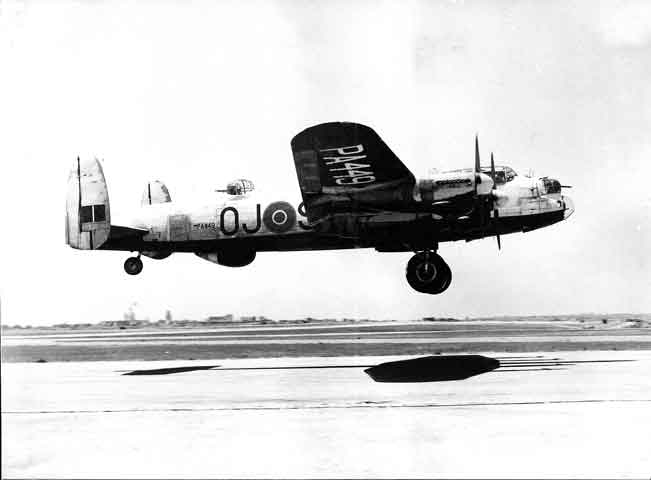
Avro Lancaster from 149 Sqn taking off from RAF Luqa on 17Jul48

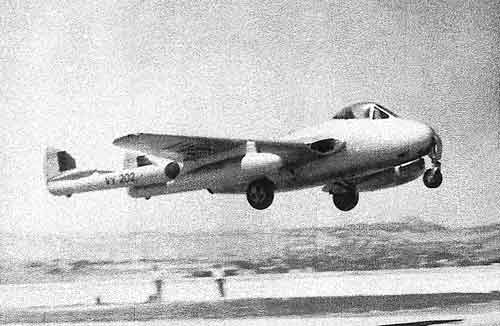
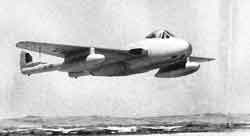
de Havilland Vampires at RAF Luqa. (From photocopies as originals were missing.)
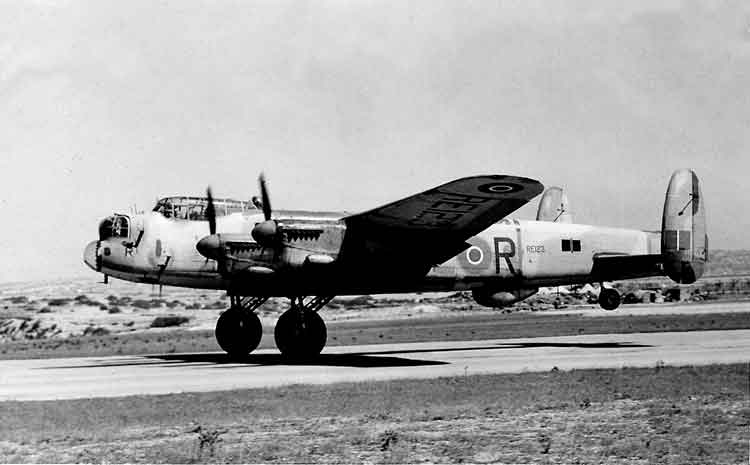
Avro Lancaster from 38 Sqn taking off from RAF Luqa in June 1948.
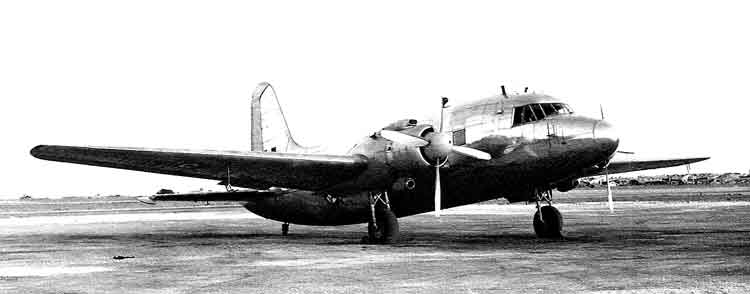 Vickers Valetta at RAF Luqa.
Vickers Valetta at RAF Luqa.
The Vickers Valetta was a British twin-engine military transport aircraft of the late 1940s. It was an all-metal mid-wing monoplane with a tailwheel undercarriage. The Valetta was a military transport development of the Viking civil airliner. The 158th Viking became the prototype Valetta, which was first flown from Brooklands by Mutt Summers on 30 June 1947. The Valetta differed from the Viking fundamentally in being fitted with more powerful engines, a strengthened floor and large loading doors. The Viking and Valetta provided the basis of the Varsity. The Varsity although similar was slightly larger and had a tricycle landing gear and under-fuselage pannier. The Valetta C.1 entered service with the RAF in 1948, replacing the Douglas Dakota with RAF Transport Command and with transport squadrons in the Middle and Far East. The Valetta was used to carry out parachute drops in the 1956 Suez Crisis, and was used to provide transport support for a number of other British Military operations in the 1950s and 1960s, such as during the Malayan Emergency and operations in Aden. The Valetta T.3 was built to provide a navigational trainer for service with the RAF College at RAF Cranwell and with No.1 and No.2 Air Navigation Schools. 40 were delivered from August 1951. 18 aircraft were later converted to T.4 standard with a longer nose to accommodate a radar scanner in order to train crews in the AI (Airborne Interception) role. Variants: Valetta C.1 - transport, 211 built; Valetta C.2 - VIP transport, 11 built; Valetta T.3 - aircrew trainer, 40 built; Valetta T.4 - converted from T.3 with radar fitted in nose. Specifications for Valetta C.1: General characteristics: Crew: 4; Powerplant: 2 x Bristol Hercules 230 14-cylinder radial piston engine, 1,975 hp (1,473 kW) each; Capacity: 34 troops or 20 paratroops; Length: 62 ft 11 in (19.18 m); Wingspan: 89 ft 3 in (27.21 m); Height: 19 ft 7 in (5.97 m); Wing area: 882 sq ft (82.0 sq m); Empty weight: 24,980 lb (11,355 kg); Loaded weight: 36,500 lb (16,591 kg); Propellers: de Havilland (or Rotol) four-bladed constant-speed; Performance: Maximum speed: 224 kn (258 mph, 415 km/h) at 10,000 ft; Cruise speed: 150 kn (172 mph, 277 km/h); Range: 1,270 nmi (1,460 mi, 2,350 km); Service ceiling: 21,500 ft (6,550 m); Rate of climb: 1,275 ft/min (6.48 m/s); Wing loading: 41.4 lb/sq ft (202 kg/sq m); Power/mass: 0.108 hp/lb (0.178 kW/kg). (Thanks to Wikipedia).
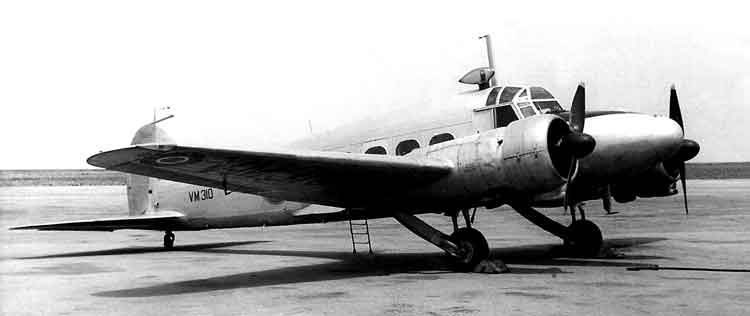 Avro Anson VM310 at Benina Airfield. Benina International Airport (IATA: BEN, ICAO: HLLB) serves Benghazi, Libya. It is located in the town of Benina, 19 km east of Benghazi, from which it takes its name. The airport is operated by the Civil Aviation and Meteorology Bureau of Libya and is the second largest in the country after Tripoli International Airport. Benina International is also the secondary hub of both Buraq Air and flag carrier, Libyan Airlines. (Thanks to Wikipedia).
Avro Anson VM310 at Benina Airfield. Benina International Airport (IATA: BEN, ICAO: HLLB) serves Benghazi, Libya. It is located in the town of Benina, 19 km east of Benghazi, from which it takes its name. The airport is operated by the Civil Aviation and Meteorology Bureau of Libya and is the second largest in the country after Tripoli International Airport. Benina International is also the secondary hub of both Buraq Air and flag carrier, Libyan Airlines. (Thanks to Wikipedia).
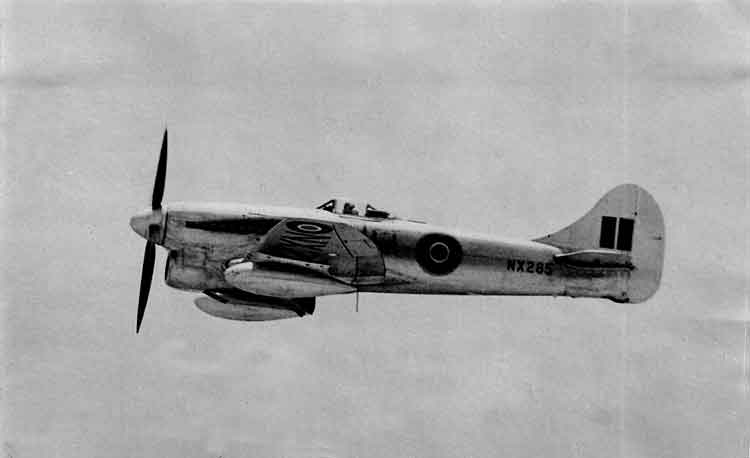 Hawker Tempest NX285 taking off from RAF Luqa July 1948.
Hawker Tempest NX285 taking off from RAF Luqa July 1948.
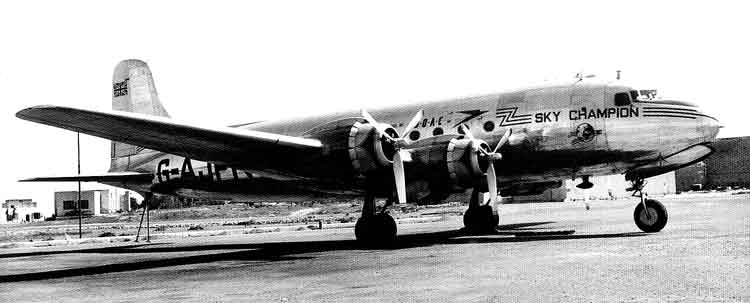 Douglas DC-4 Skymaster in dispersal at RAF Luqa July 1948.
Douglas DC-4 Skymaster in dispersal at RAF Luqa July 1948.
Douglas DC-4E, DC-4/C-54 Skymaster. When Douglas initial design of a 52-seat pressurized airliner with a triple tailfin arrangement (later designated DC-4E) failed to attract orders, it decided to design a smaller, simpler un pressurized airliner - the result was the DC-4/C-54. The onset of World War II necessitated production for the military, and over 1,200 were built to military C-54 requirements. After the war, 79 civilian DC-4-1009s were built, but many more were converted from C-54 standard. Along with the Canadair C-4 Argonaut these became the backbone of many early post-war airlines' long-haul fleets.
The C-54 served with the US military in many marques and roles, including VIP transport, but it was most readily associated with the 1948-9 Berlin airlift. A few examples survive in service to date.
Specifications apply to DC-4-1009: Crew: 4; Powerplant: four 1,081 KW (1,450 hp) Pratt & Whitney R-2000-2SD13G Twin Wasp radial piston engines; Performance: max speed 451 Km/h (280 mph); Range 4,023 Km (2,500 miles) with a 5,189 Kg (11,440 lb) payload; service ceiling 6,800 m (22,300 ft) Dimensions: Wingspan 35.81 m(117 ft 6 in); length 28.60 m (93 ft 10 in); Height 8.38 m (27 ft 6 in). Weight: 33,112 Kg (73,000 lb) maximum take-off weight. Payload: Up to 86 passengers. (Thanks to The Encyclopedia of Aircraft edited by Robert Jackson).
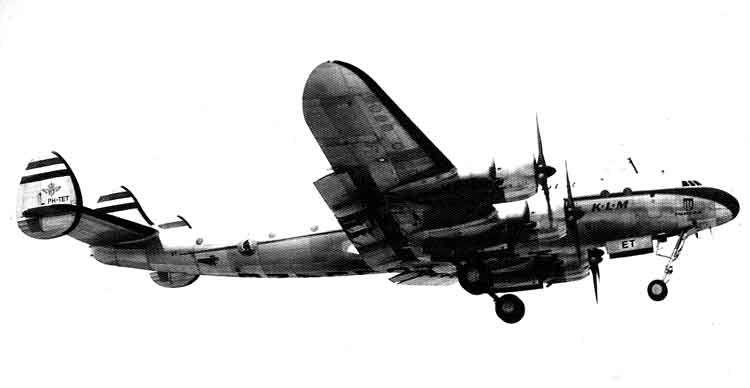
"The Flying Dutchman" Lockheed Constellation takes off from RAF Luqa July 1948.
Lockheed C-69, L-049 and L-749 Constellation. The Lockheed Constellation was the classic postwar airliner, with a distinctive triple fin tail and a humped back. It began its life as a response to a TWA civil transport requirement in 1939.
However, World War II intervened and the project was sequestered by the USAAF - 22 military examples were produced before the end of the hostilities. At this point military interest in the Constellation was withdrawn and remaining work in progress was converted to airliner standard as the L-049 for airlines such as TWA and BOAC.
Lockheed turned its efforts to producing the L-649 airliner, which included more powerful engines, increased weights and onboard systems for commercial use. The Lockheed L-749, with structural improvements and consequently greater maximum weights, became the definitive version - there was also a military transport derivative, designated the C-121. A total of 233 examples of all versions were built, mostly for major airlines, however, the Constellation was gradually superseded by the greater weight L-1049 Super Constellation.
Specifications apply to the L-749: Crew: 4; Powerplant: four 1,864 KW (2,500 hp) Wright R-3350-C18-BA1 Cyclone radial piston engines; Performance: Cruising speed 480 Km/h (298 mph); range 4,185 Km (2,600 miles); Dimensions: wingspan 37.49 m(123 ft); length 29.67 m (97 ft 4 in); height 7.21 m (23 ft 8 in). Weight: 48,535 Kg (107,000 lb) maximum take-off weight; Payload: up to 81 passengers. (Thanks to The Encyclopedia of Aircraft edited by Robert Jackson).
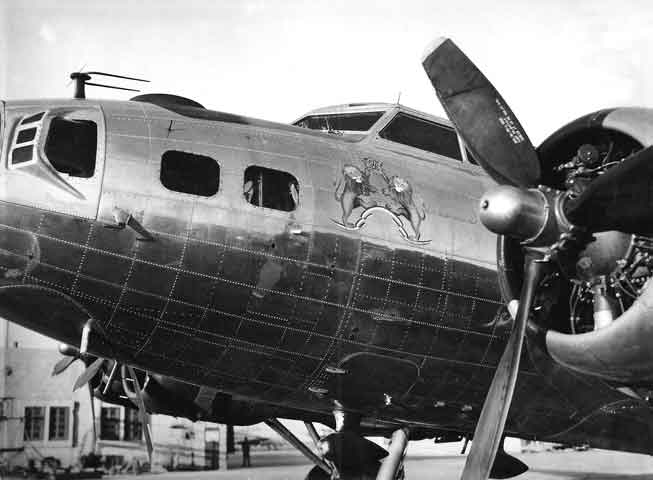
Shah in Shah of Iran's Fortress.
Boeing B-17 Flying Fortress.
The B-17B Flying Fortress was designed in response to a US Army Air Corps requirement, issued in 1934, for a long-range, high-altitude daylight bomber. The prototype bearing the company designation Boeing Model 299, flew for the first time on 28Jul35.
Although the prototype was later destroyed in an accident, the cause was attributed to human error and the project went ahead. Thirteen Y1B-17s and one Y1B-17A were ordered for evaluation, and after the trials period these versions were designated B-17 and B-17A respectively. The first production batch of 39 B-17Bs were all delivered by the end of March 1940; meanwhile a further order had been placed for 38 B-17Cs, which were powered by four Wright 895KW (1,200 hp) Cyclone engines and featured some minor changes . Twenty of these were supplied to the RAF as the Fortress I in 1941 but after sustaining several losses on bombing operations the remainder were delivered to Coastal Command or the Middle East. By the time the Pacific War began, the B-17D, 42 of which had been ordered in 1940, was in service. This was generally similar to the C model, and the Cs which were in service were subsequently modified to D standard.
A new tail design, the main recognition feature of all subsequent Flying Fortresses, was introduced with the B-17E, together with improved armament which for the first time included a tail gun position. The B-17E was the first version of the Flying Fortress to see combat in the European theatre of operations. The RAF received 42 B-17Es in 1942 under the designation Fortress IIA. A total of 512 B-17Es were produced, this variant being followed into service by the further refined B-17F, which entered production in April 1942. Total production of the B-17F was 3,400, including 61 examples converted to the long-range reconnaissance role as the F-9. Another 19 were delivered to RAF Coastal Command as the Fortress II. The last B-17Fs were fitted with a chin-mounted power-operated Bendix turret mounting a pair of 12.7 mm (0.50in) guns, which proved invaluable as the Luftwaffe increasingly adopted frontal fighter attacks. This became standard on the B-17G, the major production model.
The RAF was to receive 85 B-17Gs as the Fortress III, some of these being used for electronic-countermeasures. Ten B-17Gs were converted for reconnaissance as the F-9C, while the US Navy and Coast Guard employed 24 PH-1Ws and 16 PB-1Gs for maritime surveillance and aerial survey. About 130 were modified for air-sea rescue duties as the B-17H or TB-17H, with a lifeboat carried under the fuselage and other rescue equipment.
Production of the Fortress, from the B-17F onwards, was shared between Boeing, Douglas and Lockheed-Vega, which between them produced 8,680 B-17Gs. The Free French Air Force used a small number of B-17Fs in Indo-China during the closing stages of the war against Japan, and also used modified B-17Gs in transport and survey roles. Thirteen B-17Gs in all were acquired between 1947 and 1955, all from surplus USAAF or US Government sources and one of the B-17Fs already in French Air Force service was retained for spares.
Specifications apply to B-17G Flying Fortress: Crew: 10; Powerplant: four 895 KW (1,200 hp) Wright Cyclone R-1820-97 radial engines; Performance: max speed 462 Km/h (287 mph); range 3,220 Km (2,000 miles) service ceiling 10,850 m (35,000 ft) Dimensions: wingspan 31.62 m(103 ft 9 in); length 22.78 m (74 ft 9 in); height 5.82 m (19 ft 1 in). Weight: 32,660Kg (72,000 lb) loaded. Armament: twin 12.7 mm (0.50 in) machine gun under nose, aft of cockpit, under centre fuselage and in tail, and single-gun mountings in sides of nose, in radio operator's hatch and waist positions; maximum bomb load 7,983 Kg (17,600 lb).
(Thanks to The Encyclopedia of Aircraft edited by Robert Jackson).
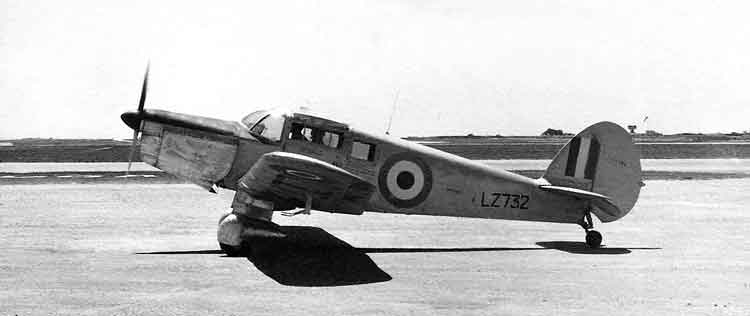
CO's Percival Proctor LZ732 taxying out at RAF Luqa.
Percival Proctor. The Proctor was an important component of the RAF's wartime communications and radio training needs. This low-wing, fixed-tailwheel light aircraft served in large numbers, having been selected against a tender specification, although it was itself developed from the Vega Gull racing aeroplane. The Mk.I was produced for communications. Subsequent versions were for radio training and the Proctor Mk. IV featured a larger four-seat cabin, and in some cases dual controls. More than 1,200 Proctors were produced, many during wartime by F.Hills and Sons of Manchester.
Some continued in service with the RAF until 1955. After the war successful civilian conversions led to new production of 150 Proctor 5 series new civil builds.
Specifications apply to the Percival Proctor Mk. IV: Crew: 1 (3/4 in radio trainer role); Powerplant: one de Havilland Gypsy Queen in-line piston engine rated at 157 KW (210 hp); Performance: max speed 257 Km/h (160 mph); range 805 Km (500 miles) service ceiling 4,265 m (14,000 ft) Dimensions: wingspan 12.04 m (39 ft 6 in); length 8.59 m (28 ft 2 in); height 2.21 m (7 ft 3 in). Weight: 1,588 Kg (3,500 lb) maximum take-off weight. Payload: four seats in radio trainer mode. (Thanks to The Encyclopedia of Aircraft edited by Robert Jackson).
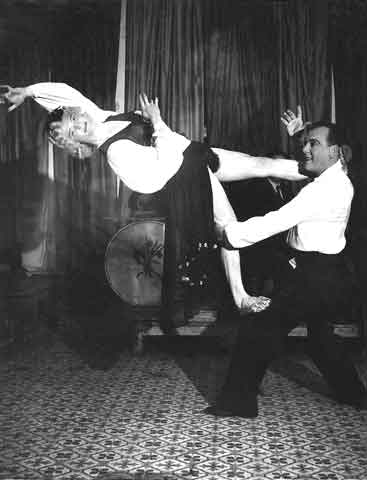
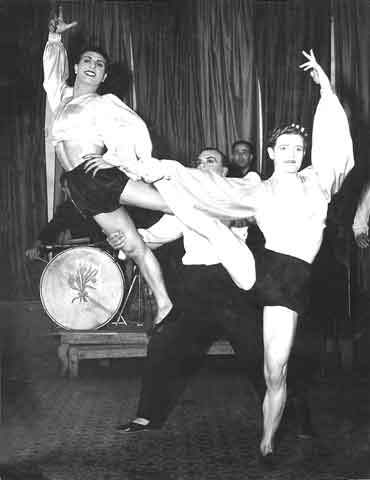
Night life Malta.
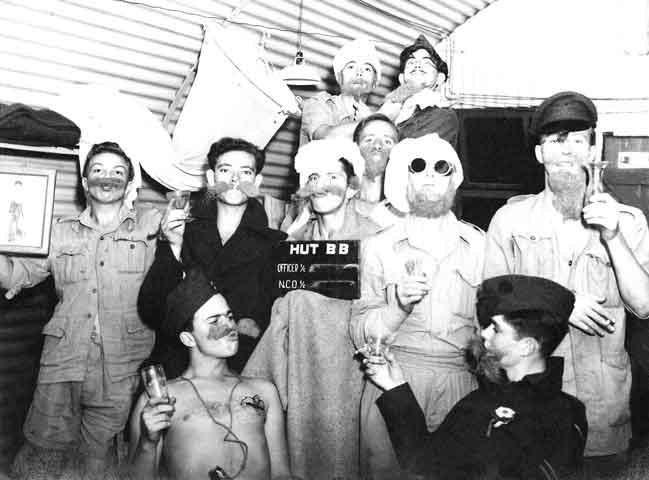
B.8's Own Carnival - Wogs, Flying Types, Jews, Russians and more the merrier together in B.8
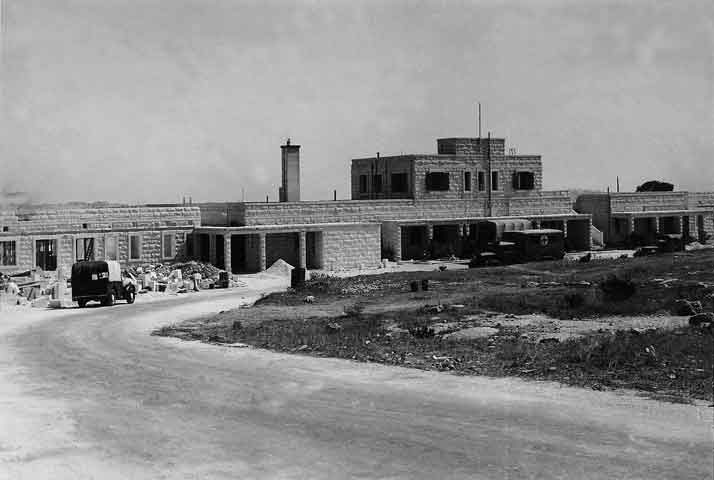
Station Sick Quarters - RAF Luqa.
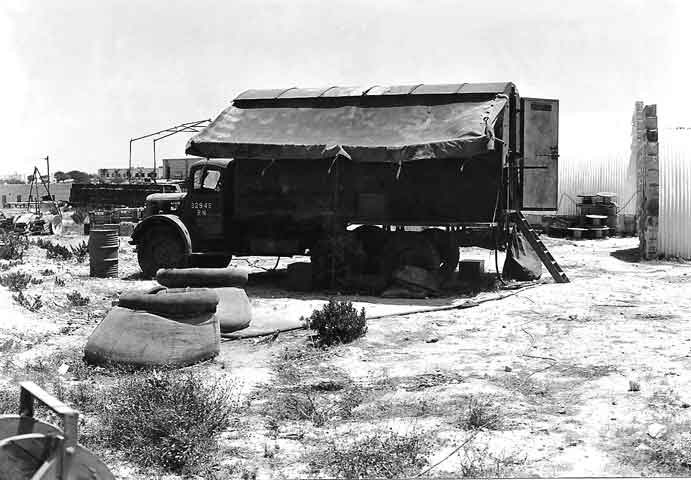
RAF Station Luqa -Campsite. Photographic Section trailer.
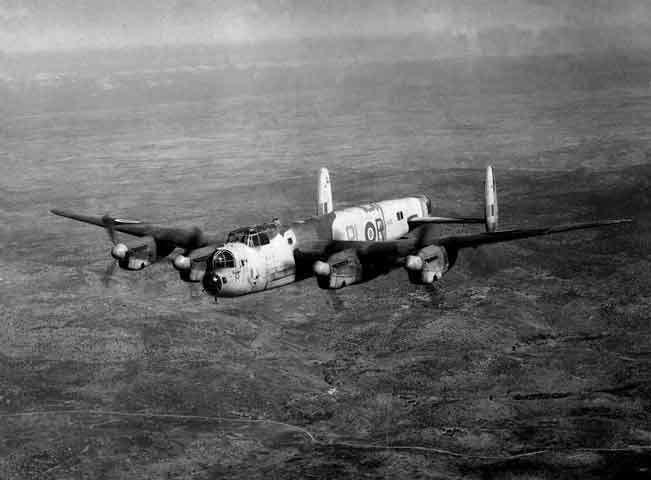
Avro Lancaster GR.3 R for Roger from 38 Squadron flying over Palestine.
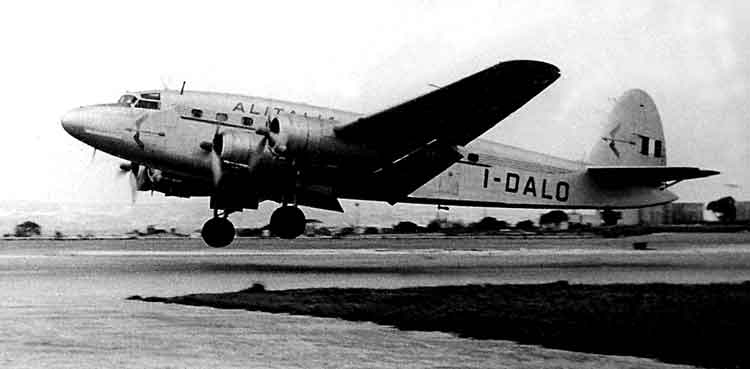
Savoia-Marchetti SM.95 The low-wing SM.95's production and deployment were complicated by Italy's shift from the Axis to the Allied side of in World War II. Two, for example, were sequestered by the Luftwaffe, but later transferred to the Italian Air Force. This retractable-undercarriage airliner was intended for transatlantic services, and production resumed after the war The new version featured a stretched fuselage and a choice of Bristol or Pratt & Whitney engines. No more than 23 SM.95s were built but they served with Alitalia on destinations in Europe and the Americas until 1951. Specifications apply to the SM.95: Crew: 4; Powerplant: four Alfa Romeo 128RC.18 piston engines each rated at 641 KW (860 hp) or four Bristol Pegasus 48 9-cylinder radial piston engines each rated at 562 KW (740 hp), or four Pratt & Whitney E-1830-S1C3-G Twin Wasp 14-cylinder radial engines rach rated at 783 KW (1,050 hp); Performance: max speed 400 Km/h (248 mph); range 2,000 Km (1,243 miles) service ceiling 6,500 m (21,325 ft) Dimensions: wingspan 34.28 m(112 ft 5.5 in); length 24.77 m (81 ft 3.25 in); height 5.70 m (18 ft 8.5 in). Weight: 24,000 Kg (52,910 lb) maximum take-off weight. Payload: up to 30 passengers. Thanks to The Encyclopedia of Aircraft edited by Robert Jackson).
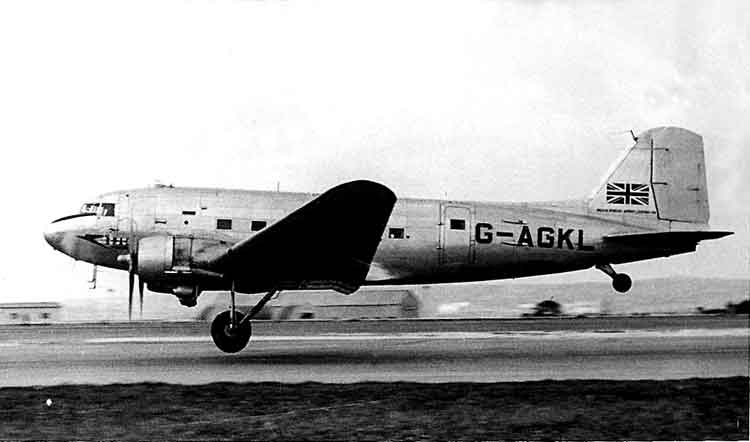
BOAC Douglas Dakota landing at RAF Luqa.
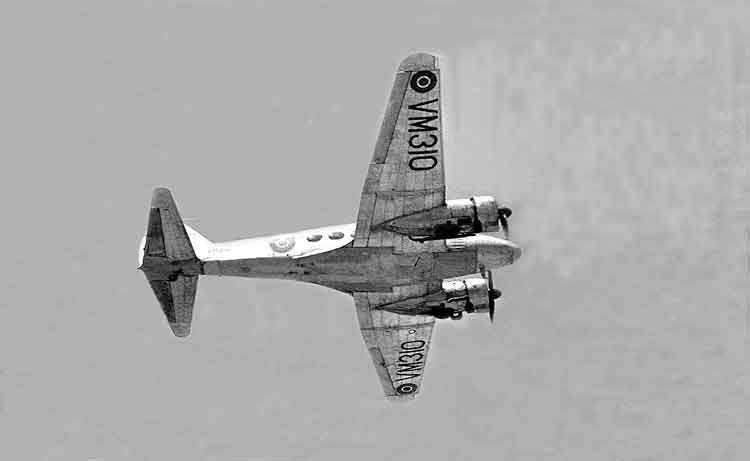 Avro Anson VM310 from Malta Communications Flight RAF Luqa.
Avro Anson VM310 from Malta Communications Flight RAF Luqa.
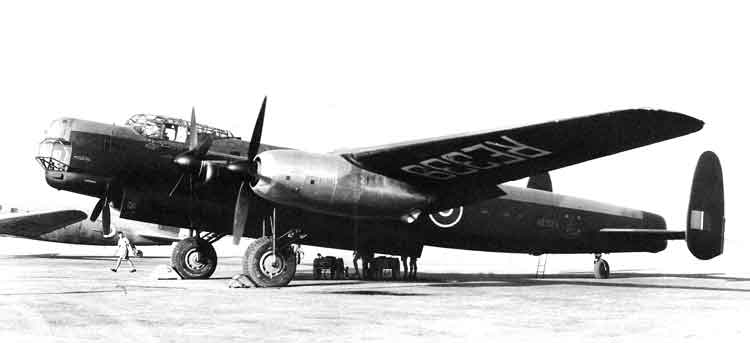
Avro Lincoln RE339 flying testbed for the Theseus turbo-prop engine. RAF Luqa. The Theseus was the Bristol Aeroplane Company's first attempt at a gas-turbine engine design, a turboprop that delivered just over 2,000 hp (1,500 kW). A novel feature was the use of a heat exchanger to transfer waste heat from the exhaust to the compressor exit. The engine was soon superseded by the Proteus design with more power, and the only extended use of the engine was in two Handley Page Hermes 5 development aircraft. Following 156 hours of ground runs and the receipt of a test certificate from the Ministry of Supply on 28Jan47, two Theseus engines were fitted in the outer positions of a four-engined Avro Lincoln for air tests. After ground and taxying test the Lincoln first flew on 17Feb47. In the late 1940's the engine division of the Bristol factory were heavily involved in gas turbine developement. One of their first engines the axial flow Theseus engine was long term tested in a converted Lincoln bomber. The two outboard engines were replaced with the Theseus gas turbine turbo prop and was then used on regular services to Egypt during 1948 - 49 to gain experience of turbo prop operation. The aircraft was also displayed to the eager company employees during the Brabazon Open Day on June 6th 1950.
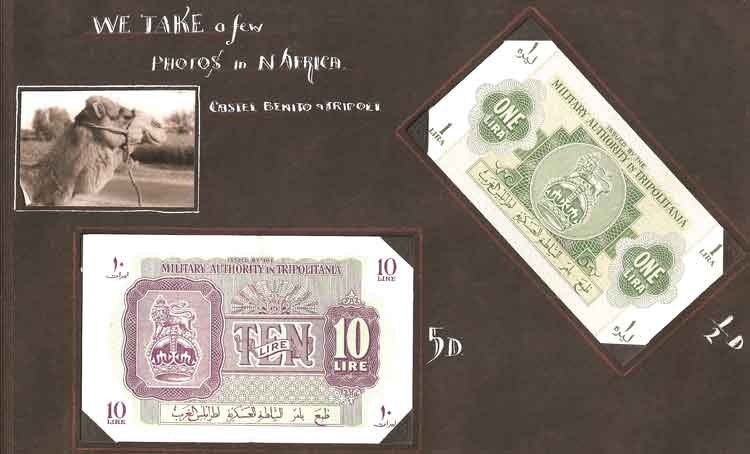
BeBe started to visit North Africa from Malts.
RAF Castel Benito (later RAF Idris) was a Royal Air Force station near Tripoli in Libya between 1943 and 1966. Originally a Regia Aeronautica (Italian Air Force) airfield where later the first units of Italian parachutists were trained and formed shortly before the Second World War. The first Italian Military Parachute School was located at Castel Benito. The first troops trained were two Libyan battalions, the Libyan Parachute Battalion and the 1st National Libyan Parachute Battalion, of the Royal Colonial Corps. After it was captured by the British, the airfield was renamed RAF Station Castel Benito and was used by a number of operational squadrons involved in the desert war, sometimes for only a few days or weeks at a time. In 1952, the station was renamed RAF Idris in honour of the Libyan King Idris at the request of the Libyan government. The station was used as a staging post for flights to and from the United Kingdom to the Middle East and Far East. It was also used in the 1950s as a base for aircraft using the Libyan desert bombing ranges (Tahuna) for practice. The station was closed in the late 1960s when the Libya became a republic. Following the withdrawal of the RAF from Libya, the airfield became Tripoli Idris Airport. It is now known as Tripoli International Airport.

Going in to town.
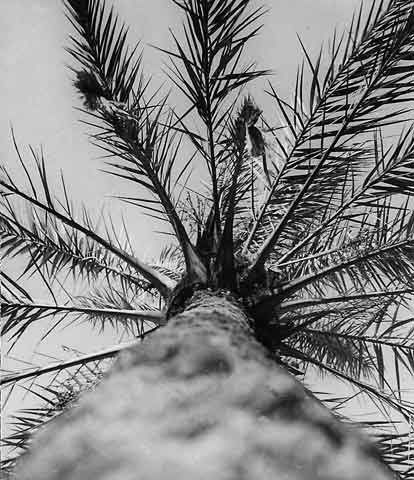
Date palm.
As BeBe so delicately put it - WOGS IN NORTH AFRICA!:
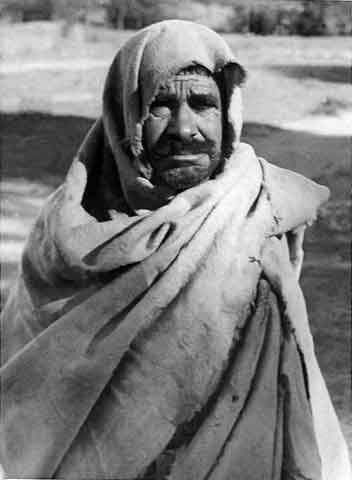
"Buckshees - Shab?" - (Cost BeBe a fag!)
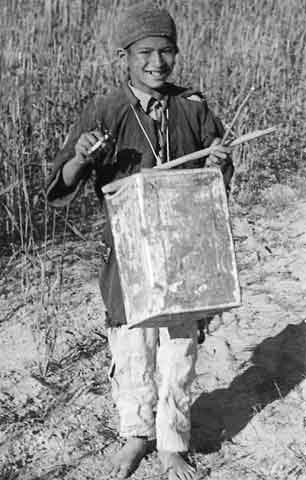
"Bird Scarer" - (Two fags gone.)
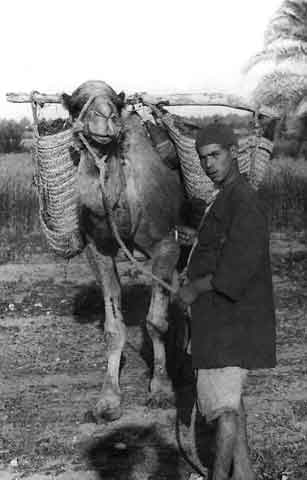
- 3 fags!
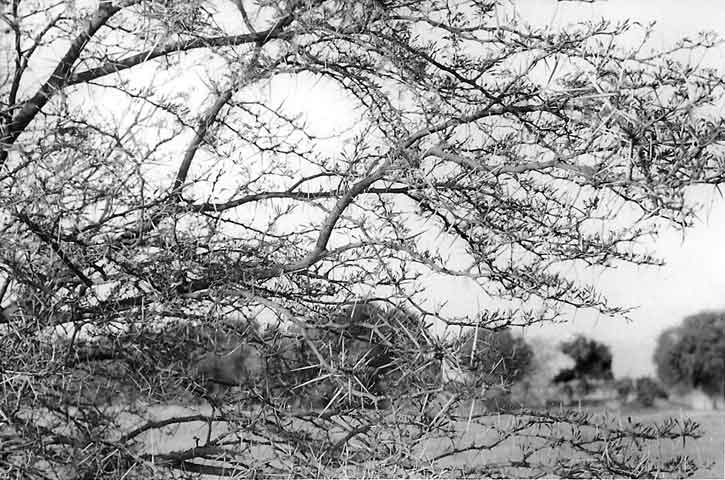
A thorn without a rose!
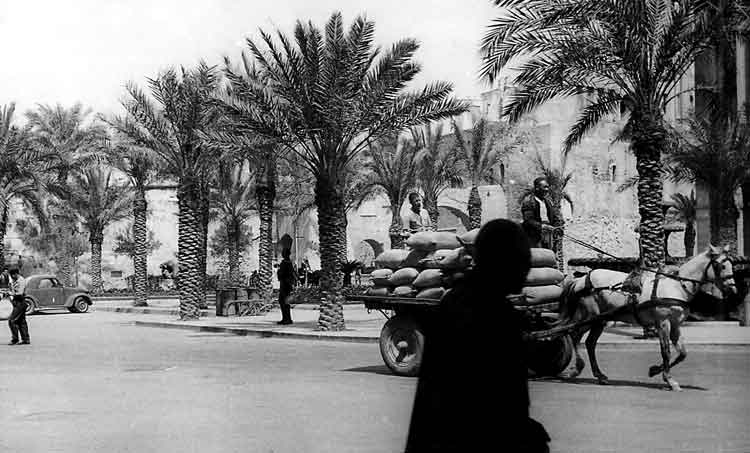
The Square in Tripoli.
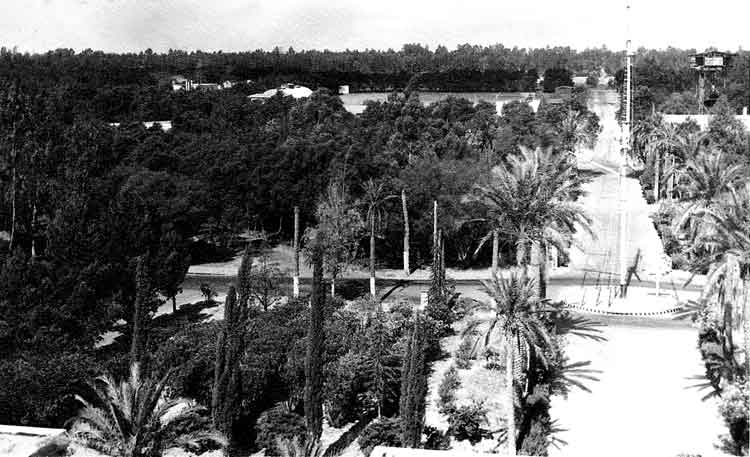
View from Castel Benito Beacon
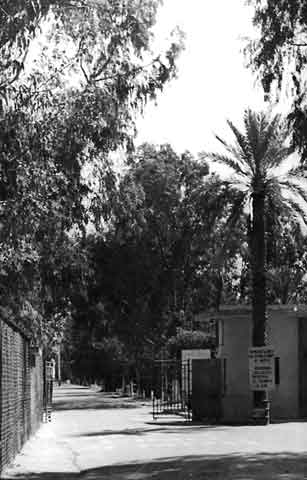
Guard Room - Castel Benito, Libya.
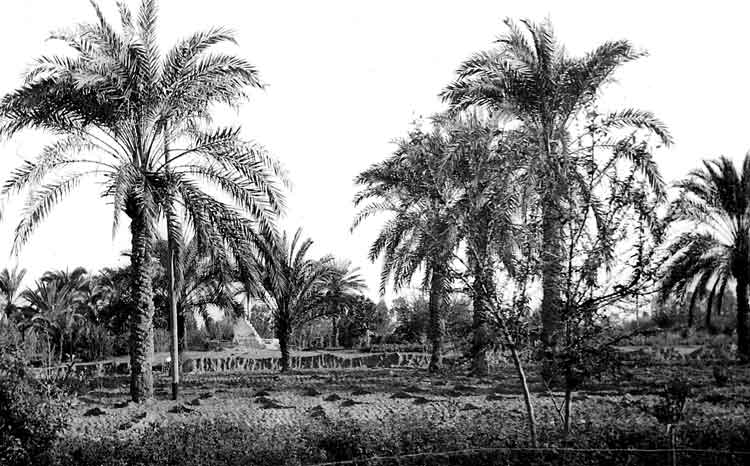
Date Palms.
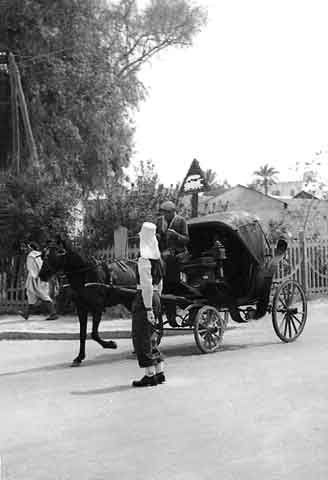
Gharri - a horse-drawn cab or carriage used in India and Egypt.
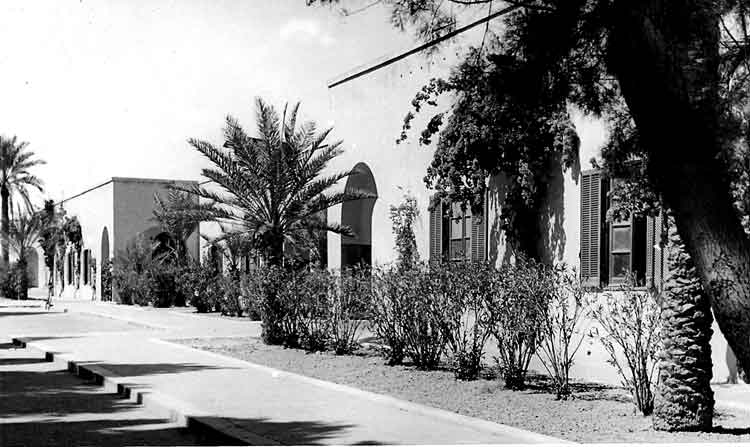
RAF Billets - Castel Benito, Libya.
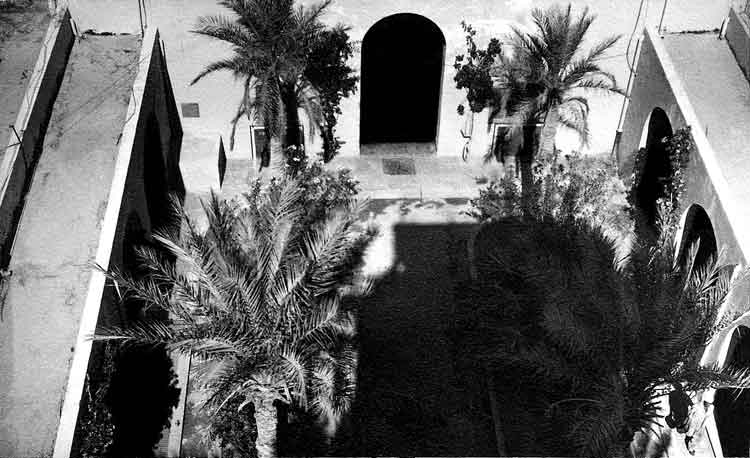
Station Headquarters - RAF Castel Benito, Libya.
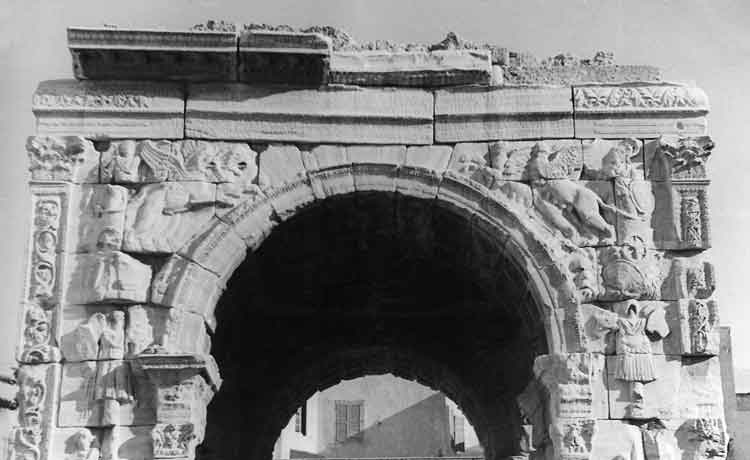
Roman Arch in the Old City of Tripoli. The Arch of Marcus Aurelius was once part of the Ancient Roman city of Oea which was founded by the Phoenicians in the 7th century BC and later conquered by the Romans. The Arch of Marcus Aurelius was built around 165 AD to celebrate the victories of the emperor's brother, Lucius Verus who had defeated the Parthian Empire and sacked their capital city, Ctesiphon. Today, the Arch of Marcus Aurelius is the sole remaining structure from Roman era-Oea, although the arch itself is well-preserved.
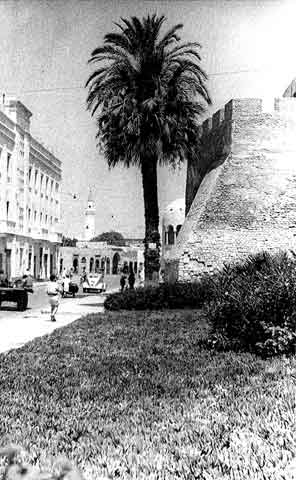
Junction of the old and the new cities of Tripoli, Libya.
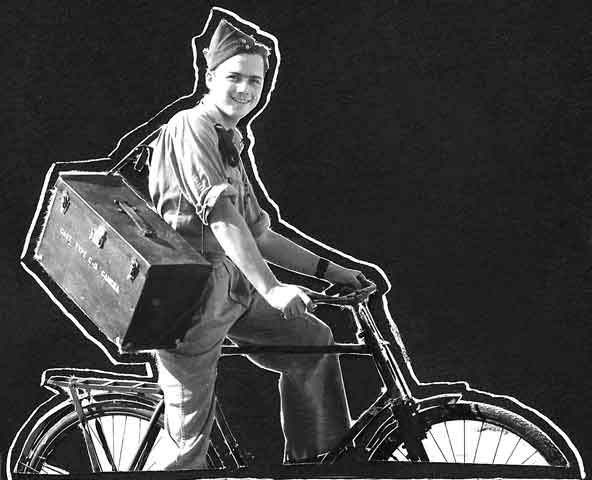
BeBe Getting Mobile!
TO SEA WITH THE ROYAL NAVY!
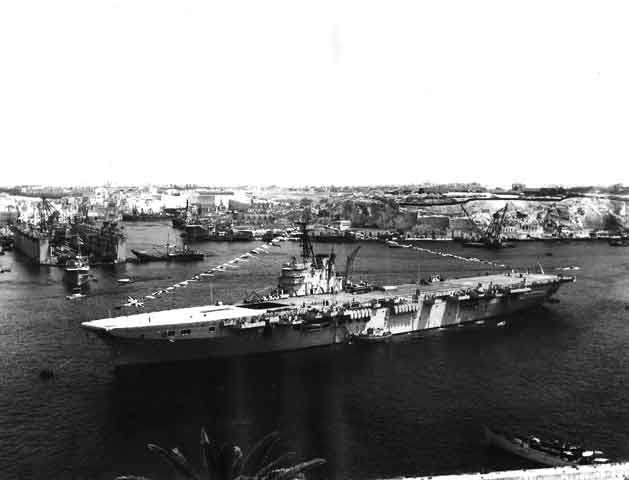
A cruise with the Navy. Aircraft Carrier HMS TRIUMPH in Grand Harbour, Malta. HMS Triumph (R16) (1944-1981) was a Royal Navy Colossus-class light fleet aircraft carrier. Notice she had no "Angled Deck" in those days - you will see why that is relevant later! She served in the Korean War and later, after reconstruction, as a support ship. Triumph was laid down during World War II on 27Jan43 at Hawthorn Leslie and Company on the Tyne. Her construction was relatively rapid and she was launched on 2Oct44 only a few months from the end of the war. She was commissioned into the Royal Navy on 6May46. Class & type: Colossus class aircraft carrier; Displacement: 13,350 tons standard; Length: 695 ft (212 m); Beam: 80 ft (24 m); Draught: 23.5 ft (7.2 m); Propulsion: 2 shafts, Parsons geared Steam turbines. 4 x Admiralty 3-drum boilers; 40,000 shp; Speed: 25 knots (46 km/h); Range: 12,000 nautical miles (22,000 km); Complement: 1,300 (including air group); Aircraft carried: 48. (Thanks to Wikipedia).
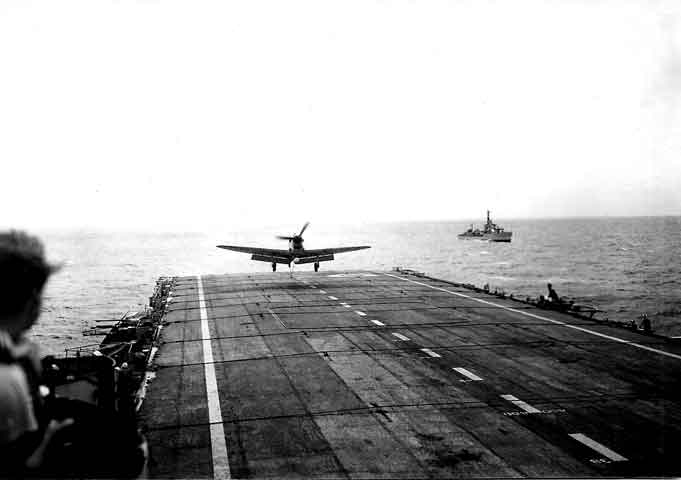
BeBe obviously went to sea with the Navy and took these shots of carrier operations from HMS Triumph. Fairy Firefly landing on.
Fairey Firefly. The prototype Fairey Firefly two-seat naval fighter first flew on22Dec41, production getting under way towards the end of the following year. It became operational in October 1943 on board the carrier HMS Indefatigable. Fireflies provided fighter cover during the series of Fleet Air Arm attacks on the battleship Tirpitz in the summer of 1944; in January 1945, while deploying to the Pacific, they took part in the destruction of Japanese-held oil refineries in Sumatra. The first major postwar variant was there Firefly Mk.IV, which in turn was replaced by the Mk.V. Operating from light carriers, Fireflies carried out many strikes during the Korean War. The Firefly AS.6 was an anti-submarine variant. Specifications apply to the Mk.I Crew: 2; Powerplant: one 1,291 KW (1,730 hp) Rolls-Royce Griffon IIB 12-cylinder vee-type engine; Performance: max speed 508 Km/h (316 mph); range 2,100 Km (1,300 miles) service ceiling 8,500 m (28,000 ft) Dimensions: wingspan 13.56 m(44 ft 6 in); length 11.46 m (37 ft 7 in); height 4.14 m (13 ft 7 in). Weight: 6,350 Kg (14,020 lb) loaded. Armament: four 20 mm (0.79 in) Hispano cannon. (Thanks to The Encyclopedia of Aircraft edited by Robert Jackson).
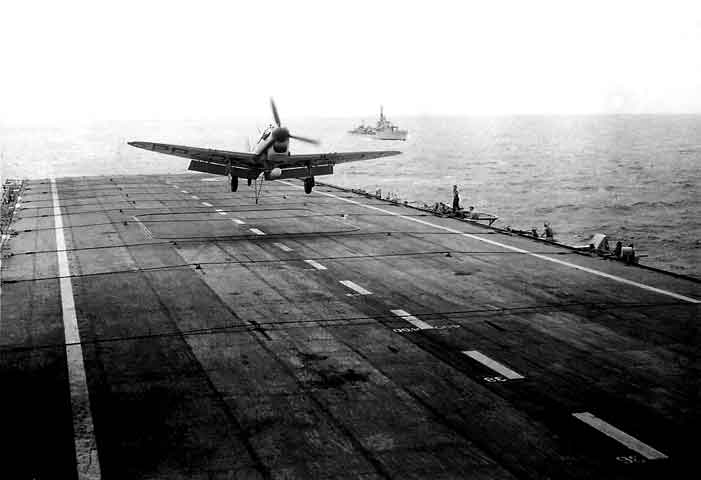
Missed the arrester wires and then......
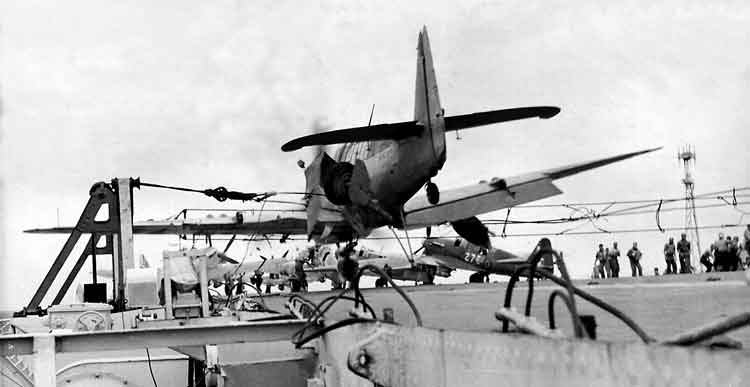
...prang! Quite a sequence to record from one visit on board! It can't have happened very often or the RN would have no Fireflies left?! With no angled deck they obviously had to go into the barrier if they missed the wire.
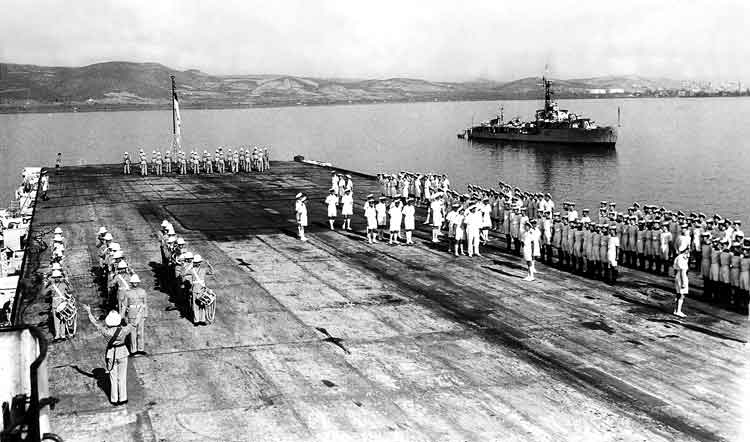
"Divisions" on board HMS Triumph, Palmas Bay, Sardinia.
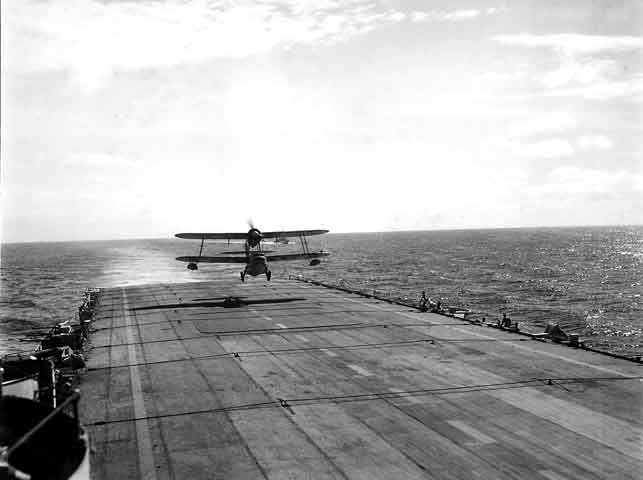
Mail arriving - Supermarine Walrus lands on the deck of the carrier HMS Triumph.
Supermarine Walrus The Supermarine Walrus was a British single-engine amphibious biplane reconnaissance aircraft designed by R. J. Mitchell and first flown in 1933. It was operated by the Fleet Air Arm (FAA) and also served with the Royal Air Force (RAF), Royal Australian Air Force (RAAF), Royal Canadian Air Force (RCAF), Royal New Zealand Navy (RNZN) and Royal New Zealand Air Force (RNZAF). It was the first British squadron-service aircraft to incorporate a fully retractable main undercarriage, completely enclosed crew accommodation, and an all-metal fuselage. Designed for use as a fleet spotter to be catapult launched from cruisers or battleships, the Walrus was later employed in a variety of other roles, most notably as a rescue aircraft for downed aircrew. It continued in service throughout the Second World War. The Walrus was initially developed as a private venture in response to a 1929 Royal Australian Air Force (RAAF) requirement for an aircraft to be catapult-launched from cruisers, and was originally called the Seagull V, although it only resembled the earlier Supermarine Seagull III in general layout. Construction was started in 1930 but owing to Supermarine's other commitments it was not completed until 1933. By 1943, catapult-launched aircraft on cruisers and battleships were being phased out; their role at sea was taken over by much improved radar. Also, a hangar and catapult occupied a considerable amount of valuable space on a warship. However, Walruses continued to fly from Royal Navy carriers for air-sea rescue and general communications tasks. Their low landing speed meant they could make a carrier landing despite having no flaps or tailhook. Specifications data from Supermarine Walrus I & Seagull V Variants. Crew: 3-4; Length: 37 ft 7 in (11.45 m); Wingspan: 45 ft 10 in (14.0 m); Height: 15 ft 3 in (4.6 m); Wing area: 610 sq ft2 (56.7 sq m); Empty weight: 4,900 lb (2,220 kg); Loaded weight: 7,200 lb (3,265 kg)
Max. takeoff weight: 8,050 lb (3,650 kg); Powerplant: 1 x Bristol Pegasus VI radial engine, 680 hp (510 kW); Performance Maximum speed: 135 mph (215 km/h) at 4,750 ft (1,450 m); Range: 600 mi (965 km); Service ceiling: 18,500 ft (5,650 m); Rate of climb: 1,050 ft/min (5.3 m/s); Wing loading: 11.8 lb/sq ft (57.6 kg/sq m); Power/mass: 0.094 hp/lb (0.16 kW/kg); Armament Guns: 2 or 3 x .303 in (7.7 mm) Vickers K machine guns. (Thanks to Wikipedia).
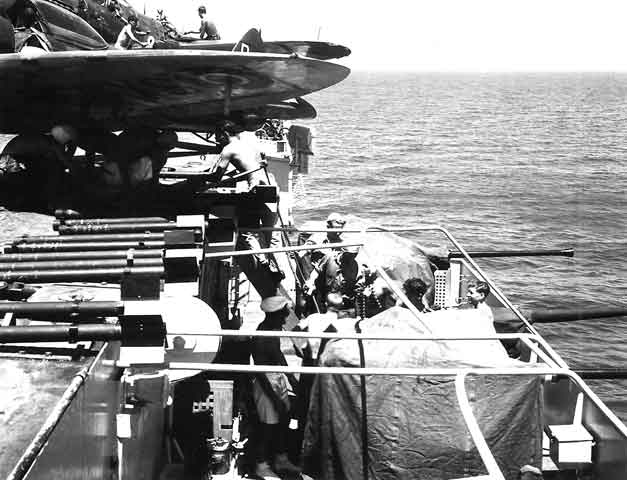
Armourers at work.
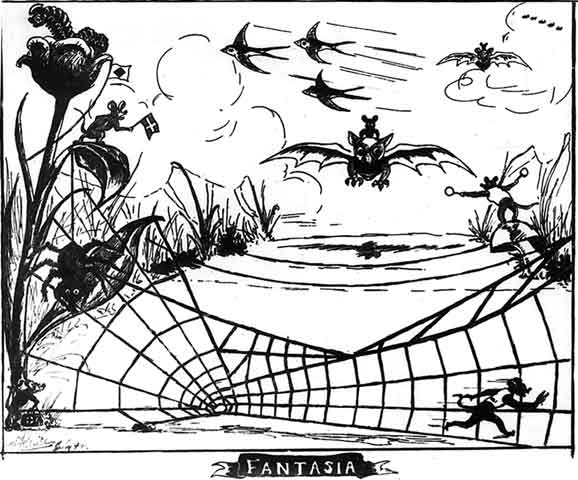
BeBe's hidden drawing of his view of carrier operations.
SARDINIA, ITALY
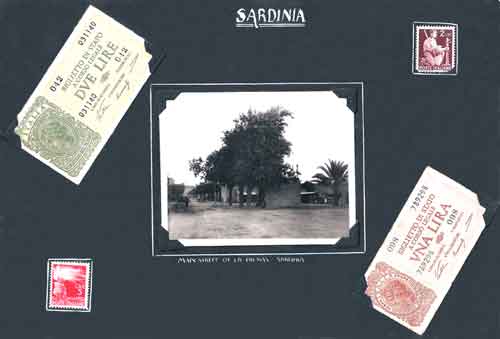
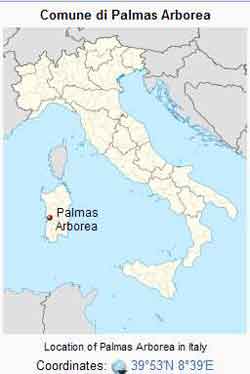
BeBe's Memorial page for his visit to La Palmas, Sardinia. Palmas Arborea (Sardinian: Pramas) is a comune (municipality) in the Province of Oristano in the Italian region Sardinia, located about 80 km northwest of Cagliari and about 6 km southeast of Oristano. As of 31 December 2004, it had a population of 1,366 and an area of 39.3 sq km.
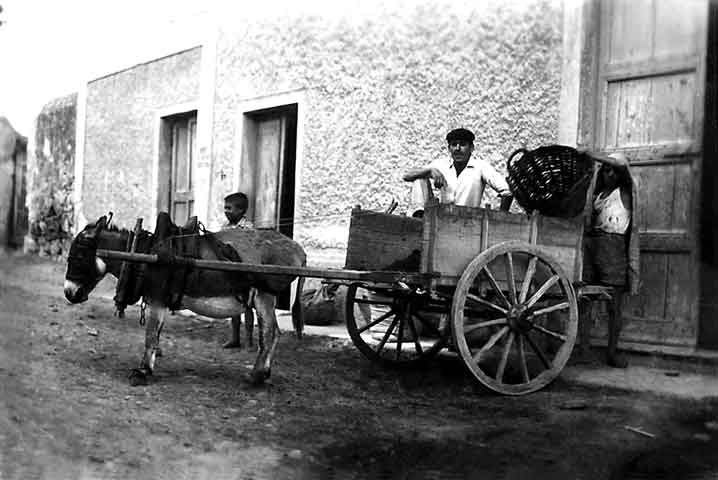
Delivering fuel!
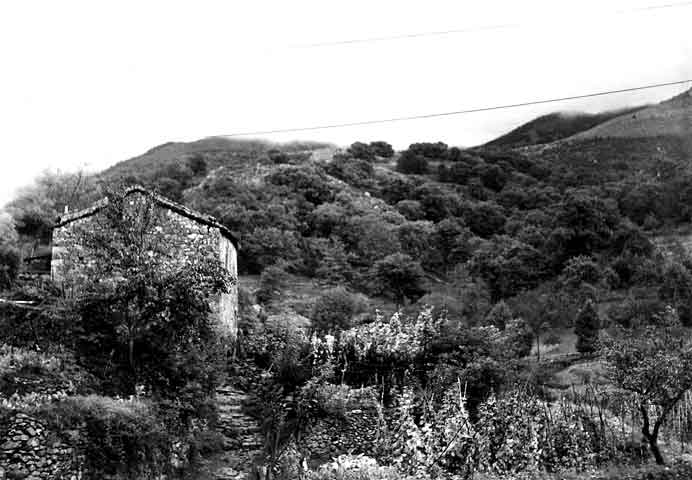
Country scene in Sardinia.
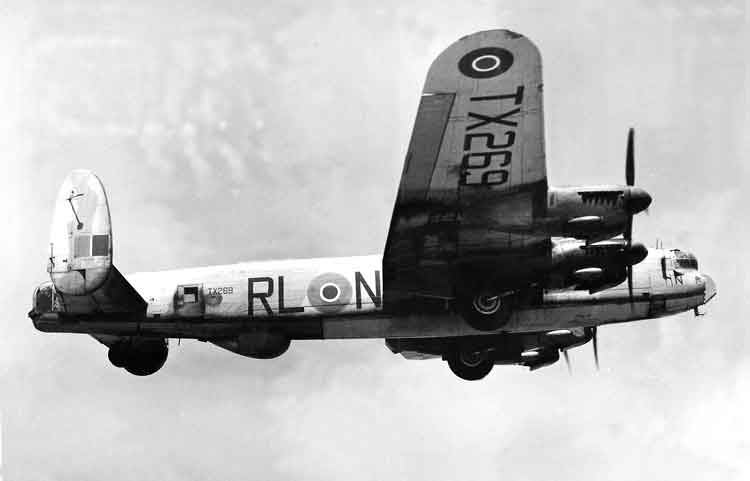
Avro Lancaster GR.3 N-NAN TX269 from 38 Sqn. Later crashed on Monte Cristo, see following report:
Friday 3Sep48 Lancaster GR3 TX269 N for NAN from 38 Sqn on Monte Cristo Island Italy. The aircraft was operating below its safety height and flew into a 1,300 feet high cliff face. 7 Crew killed: Flight Lieutenant James Bruce ARTHUR Pilot; Flying Officer John Noel KINGSLEY Co-Pilot; Flying Officer Edward BARTHORPE Navigator; Engineer Denis Geoffrey REYGATE; Signaler Kenneth Richard SHIMMONS; Signaler Samuel James HERD; Signaler George DICKENS;
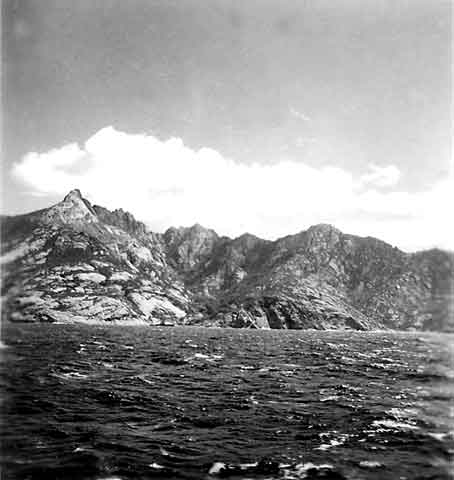
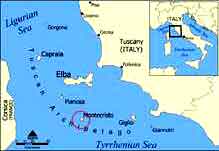
The island of Monte Cristo - Montecristo, (also Monte Cristo), formerly Oglasa, is an island in the Tyrrhenian Sea and part of the Tuscan Archipelago. Administratively it belongs to the municipality of Portoferraio in the province of Livorno, Italy. The island has an area of 10.39 sq km (4.01 sq mi) and is approximately 4.3 km (2.7 mi) wide at its widest point; the coasts are steep, and extend for 16 km (9.9 mi). The island is a state nature reserve and forms part of the Tuscan Archipelago National Park. Much of the island's fame derives from its providing the setting for part of the novel The Count of Monte Cristo, by Alexandre Dumas. In particular, the protagonist of the novel, Edmond Dant7egrave;s, finds on Monte Cristo the legendary treasure of the Spada family, which allows him to take his formidable revenge.
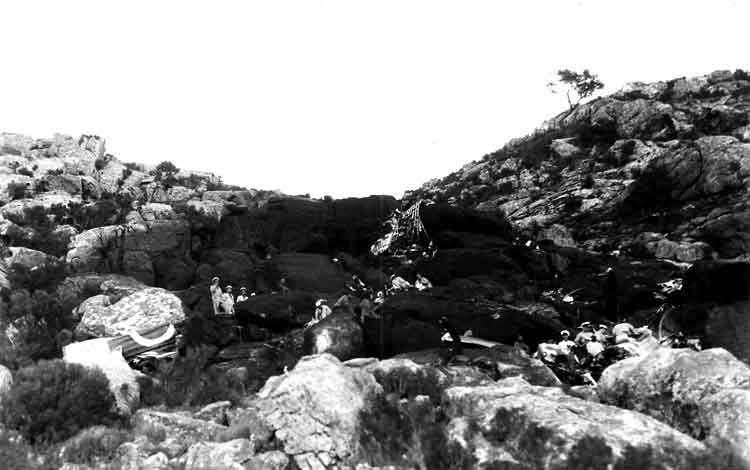
Wreckage of Lancaster GR.3 N.Nan from 38 Sqn on Monte Cristo Island. Taken by BeBe during a visit when he was sent on HMS Triumph to record the burial at sea of the aircrew.
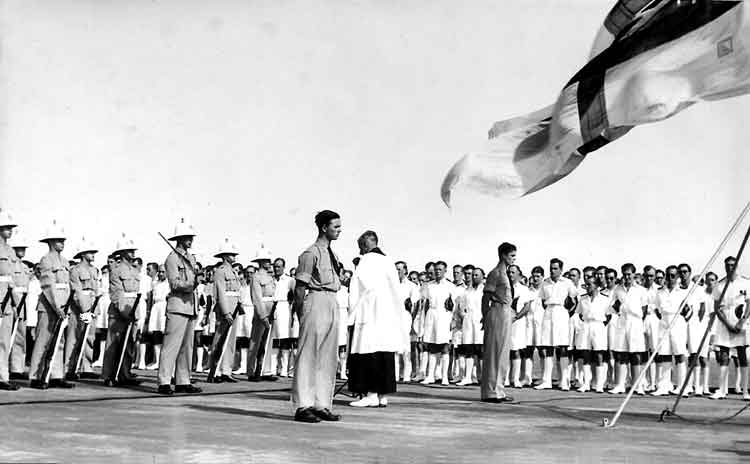
BeBe at the funeral of the crew of Lancaster GR.3 N-Nan from 38 Squadron which crashed into the mountains of Monte Cristo Island on Friday 3Sep48. This was probably why BeBe was sent on HMS Triumph to record for the RAF the burial at sea of the aircrew which was carried out by HMS Triumph.
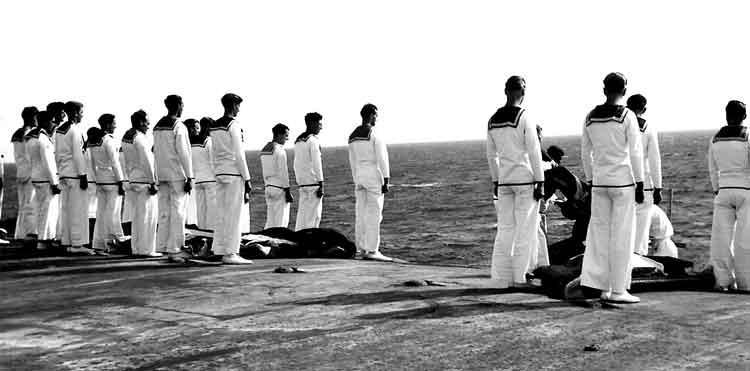
Crew of HMS Triumph carry out the burial at sea of the Lancaster aircrew of N-Nan from 38 Sqn.
CORSICA, FRANCE
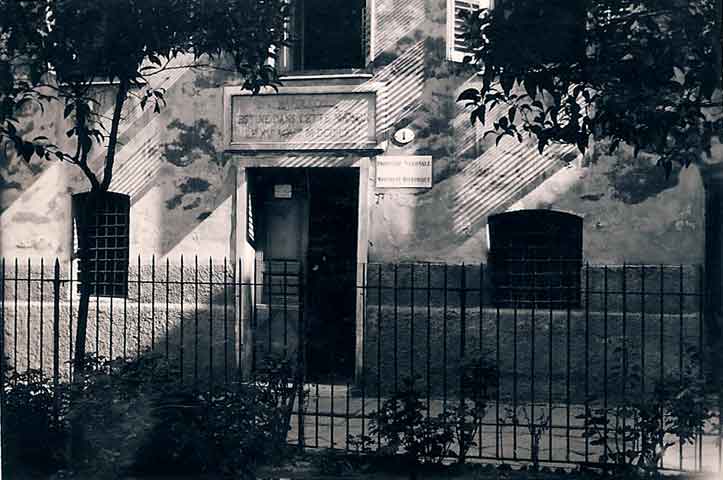
During a visit to Corsica with HMS Triumph, BeBe visited Napoleon's birthplace Ajaccio.
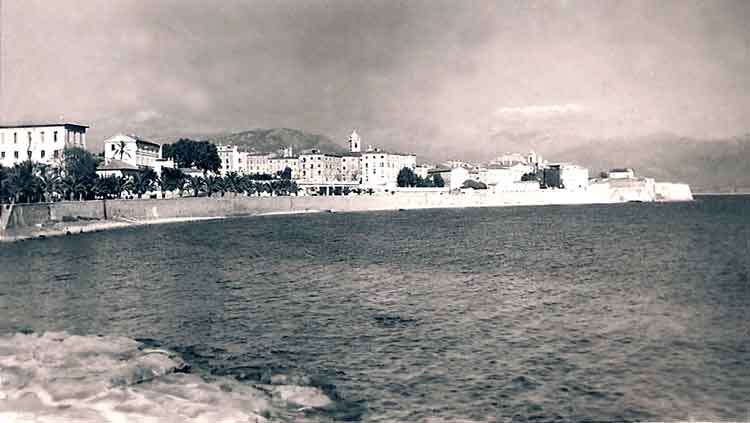
Coastline of Ajaccio, Corsica. Ajaccio (Latin: Adiacium; French: Ajaccio, Corsican: Aiacciu), is a French commune, prefecture of the department of Corse-du-Sud, prefecture of the Corse (Corsica) region, and head office of the Collectivité territoriale de Corse on the island of Corsica in France. Ajaccio is located on the west coast of the island of Corsica, 210 nautical miles (390 km) southeast of Marseille. The commune occupies a sheltered position at the foot of wooded hills on the northern shore of the Gulf of Ajaccio between Gravona and the pointe de la Parata and includes the îles Sanguinaires (Bloody Islands). The harbour lies to the east of the original citadel below a hill overlooking a peninsula which protects the harbour in the south where the Quai de la Citadelle and the Jettée de la Citadelle are. The modern city not only encloses the entire harbour but takes up the better part of the Gulf of Ajaccio and in suburban form extends for some miles up the valley of the Gravona River. The flow from that river is nearly entirely consumed as the city's water supply. Many beaches and coves border its territory and the terrain is particularly rugged in the west where the highest point is 790 metres. Napoleon Bonaparte (born as Nabulione Buonaparte) was born at Ajaccio in the same year as the Battle of Ponte Novu, 1769. The Bonapartes at the time had a modest four-story home in town (now a museum known as Casa Buonaparte) and a rarely used country home in the hills north of the city (now site of the Arboretum des Milelli). The father of the family, attorney Charles-Marie Buonaparte, was secretary to Pasquale Paoli during the Corsican Republic.
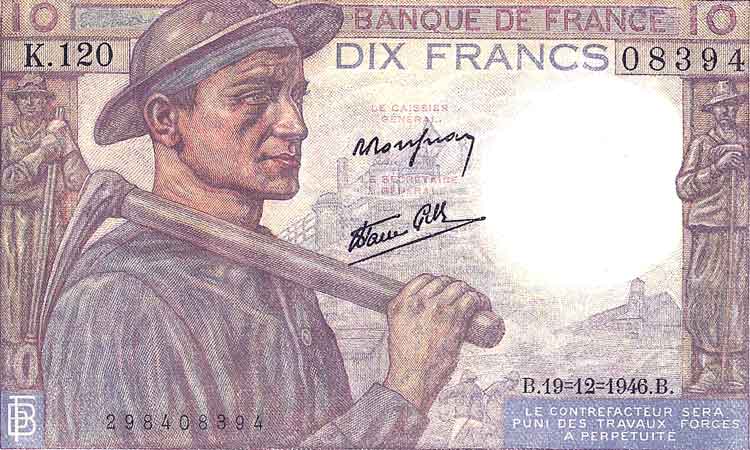
10 Franc Note
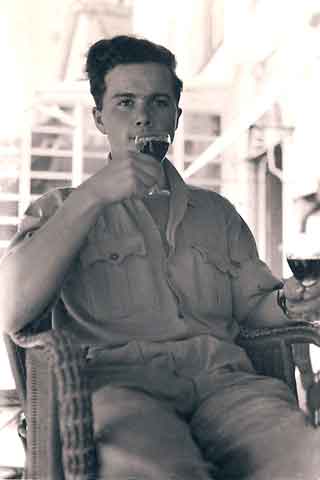
BeBe enjoys his Vermouth.
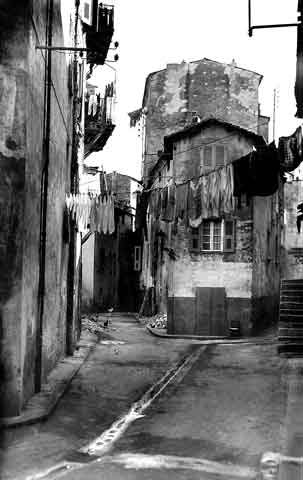
Old Street, Ajaccio, Corsica.
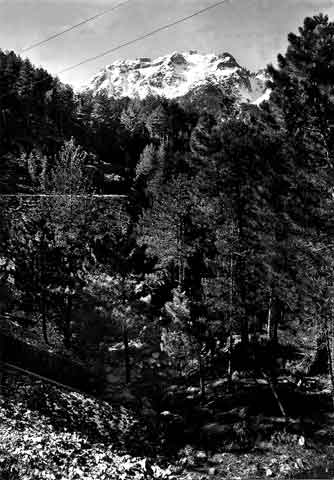
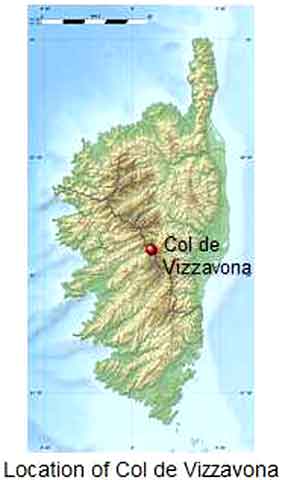
Col Vizza Vona and the Monte D'oro, Corsica. Col de Vizzavona is located between the two major peaks on Corsica: the Monte d'Oro (altitude 2,389 m (7,838 ft)), 3 km north-northwest, and the Monte Renoso (2,352 m (7,717 ft)), 6 km south-southeast. The pass is traversed by RN193 and is located in the Regional Natural Park of Corsica, and connects the Valley du Vecchio with the Gravona river and with the Gulf of Ajaccio.
LEGHORN, ITALY
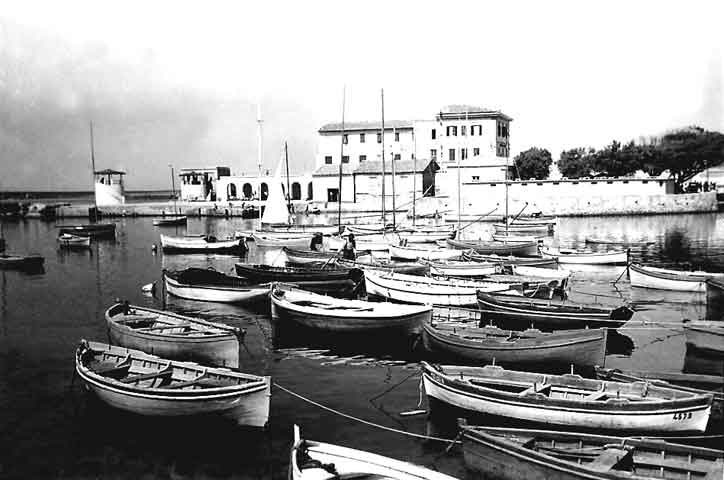
Leghorn, Italy. Livorno (Italian: [li'vorno] ( listen)), English traditionally Leghorn is a port city on the Ligurian Sea on the western coast of Tuscany, Italy. It is the capital of the Province of Livorno, having a population of approximately 161,000 residents in 2011.
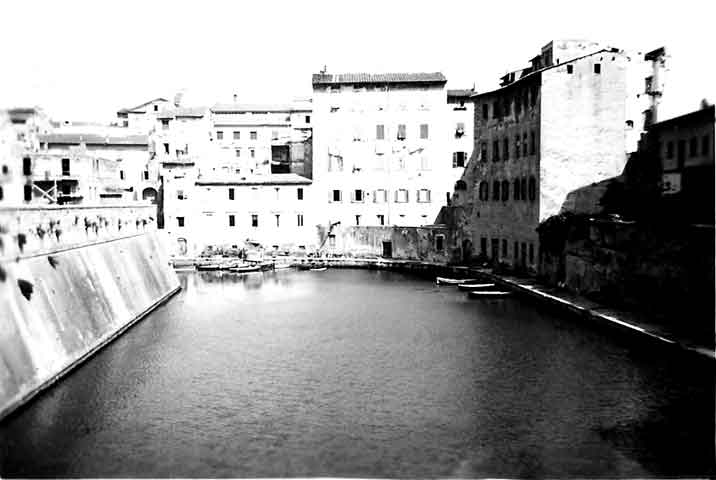
Canals in Leghorn, Italy. At the end of the 17th century, Livorno underwent a period of great town planning and expansion. Near the defensive pile of the Old Fortress, a new fortress was built, together with the town walls and the system of navigable canals through neighborhoods. After the port of Pisa silted up, its distance from the sea was increased and it lost its dominance in trade. Livorno took over as the main port in Tuscany. The New Venice district retains much of its original town planning and architectural features such as the bridges, narrow lanes, the noblemen's houses and a dense network of canals that once served to link its warehouses to the port. In the 18th and 19th centuries, Livorno had numerous neo-classical buildings, public parks housing important museums and cultural institutions, the market, and "Liberty" villas with sea views. (Thanks to Wikipedia).
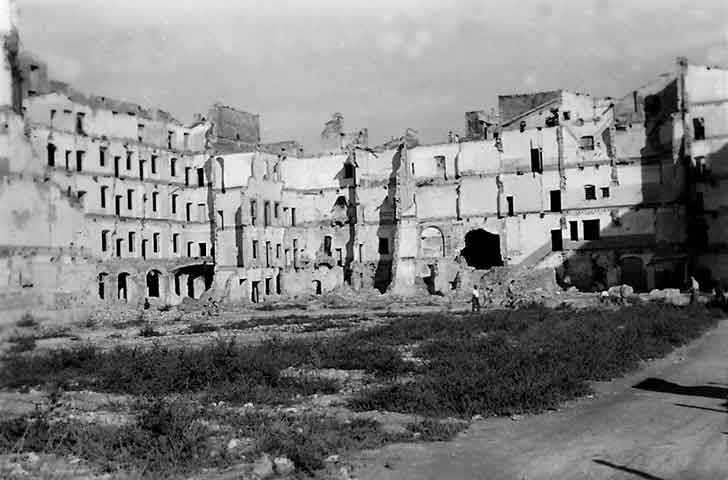
Bomb damage in Leghorn. Livorno suffered extensive damage during the Second World War. Many historic sites and buildings were destroyed by bombs of the Allies preceding their invasion, including the cathedral and the synagogue. A new synagogue was designed and built starting in 1958 and reflects contemporary styles. Livorno's loss of influence as a port led to economic decline into the 21st century; it is one of the poorest northern cities of Italy. (Thanks to Wikipedia).
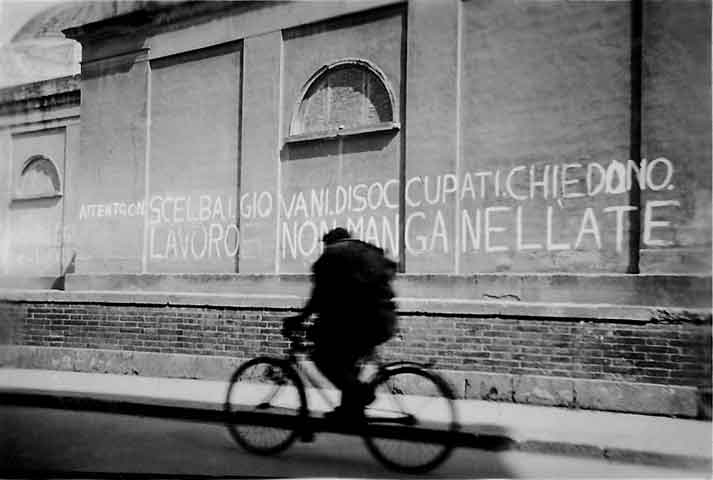
Political slogans. Thanks to Diego Meozzi he exlained that the slogan said: "Be careful, Mr Scelba. Young unemployed people are asking for jobs, not being billy-clubbed". It was a protest message against Mario Scelba, Italy's Prime Minister in 1954-55 and well known for his "heavy hand" with protestors.
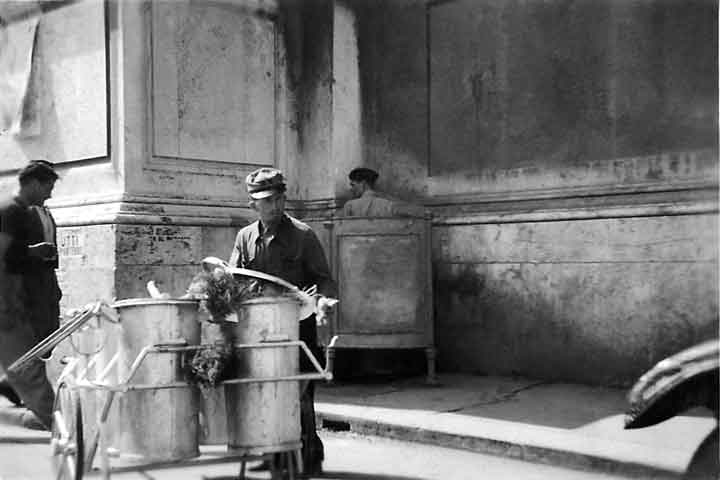
Road sweeper and Cave Brown using the very private urinals.
PISA, ITALY
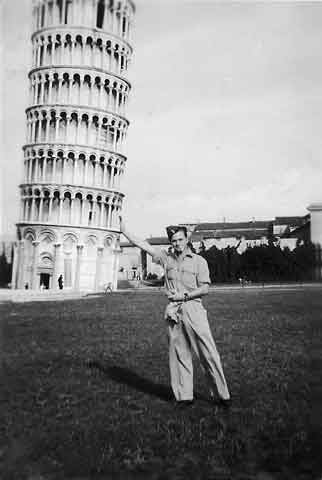

BeBe in a classic pose holding up the Tower of Pisa. A cutting from the "London Opinion" which was saved by BeBe. The Leaning Tower of Pisa (Italian: Torre pendente di Pisa) or simply the Tower of Pisa (Torre di Pisa) is the campanile, or freestanding bell tower, of the cathedral of the Italian city of Pisa, known worldwide for its unintended tilt to one side. It is situated behind the Cathedral and is the third oldest structure in Pisa's Cathedral Square (Piazza del Duomo) after the Cathedral and the Baptistry. The tower's tilt began during construction, caused by an inadequate foundation on ground too soft on one side to properly support the structure's weight. The tilt increased in the decades before the structure was completed, and gradually increased until the structure was stabilized (and the tilt partially corrected) by efforts in the late 20th and early 21st centuries. The height of the tower is 55.86 m (183.27 ft) from the ground on the low side and 56.70 m (186.02 ft) on the high side. The width of the walls at the base is 4.09 m (13.42 ft) and at the top 2.48 m (8.14 ft). Its weight is estimated at 14,500 metric tons (16,000 short tons). The tower has 296 or 294 steps; the seventh floor has two fewer steps on the north-facing staircase. Prior to restoration work performed between 1990 and 2001, the tower leaned at an angle of 5.5 degrees, but the tower now leans at about 3.99 degrees. This means that the top of the tower is displaced horizontally 3.9 metres (12 ft 10 in) from where it would be if the structure were perfectly vertical. On January 7, 1990, after over two decades of stabilisation studies, and spurred by the abrupt collapse of the Civic Tower of Pavia in 1989, the tower was closed to the public. The bells were removed to relieve some weight, and cables were cinched around the third level and anchored several hundred meters away. Apartments and houses in the path of the tower were vacated for safety. The final solution to prevent the collapse of the tower was to slightly straighten the tower to a safer angle, by removing 38 cubic meters (50 cubic yards) of soil from underneath the raised end. The tower was straightened by 45 centimeters (18 inches), returning to its 1838 position. After a decade of corrective reconstruction and stabilization efforts, the tower was reopened to the public on December 15, 2001, and was declared stable for at least another 300 years. In May 2008, after the removal of another 70 metric tons (77 short tons) of ground, engineers announced that the Tower had been stabilized such that it had stopped moving for the first time in its history. They stated it would be stable for at least 200 years. (Thanks to Wikipedia).
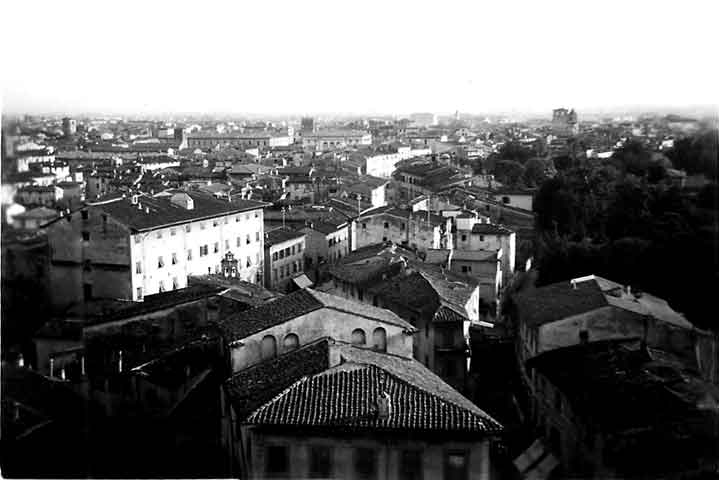
View from the top of the Leaning Tower of Pisa.
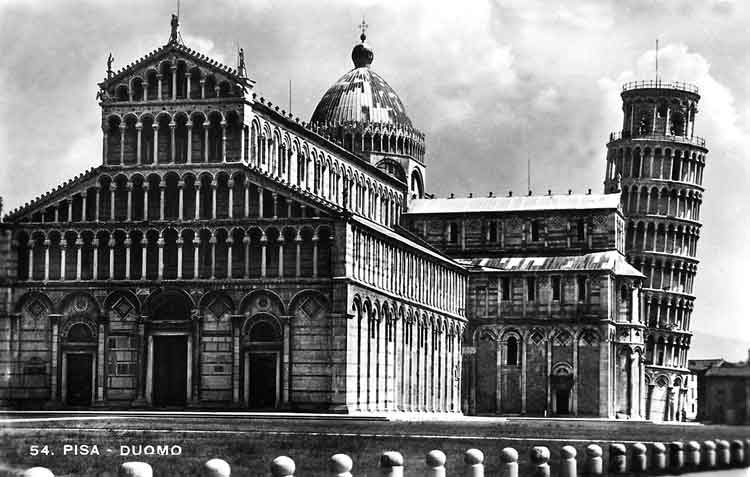
The Piazza del Duomo ("Cathedral Square") is a wide, walled area to the north of central Pisa, Tuscany, Italy, recognized as one of the main centers for medieval art in the world. Partly paved and partly grassed, it is dominated by four great religious edifices: the Duomo (cathedral), the Campanile (the cathedral's free standing bell tower seen on the right), the Baptistry and the Camposanto. It is otherwise known as Piazza dei Miracoli ("Square of Miracles"). This name was created by the Italian writer and poet Gabriele d'Annunzio who, in his novel Forse che sí forse che no (1910) described the square in this way: L'Ardea roteò nel cielo di Cristo, sul prato dei Miracoli. Which means: "The Ardea rotated over the sky of Christ, over the meadow of Miracles." Often people tend to mistake the term with Campo dei Miracoli ("Field of Miracles"). This one is a fictional magical field in the book Pinocchio, where a gold coin seed will grow a money tree. In 1987 the whole square was declared a UNESCO World Heritage Site. (Thanks to Wikipedia).
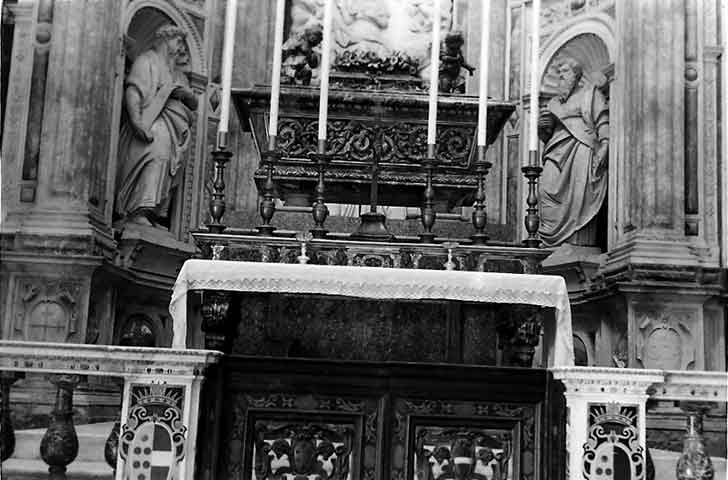
The alter in the Duomo Cathedral.
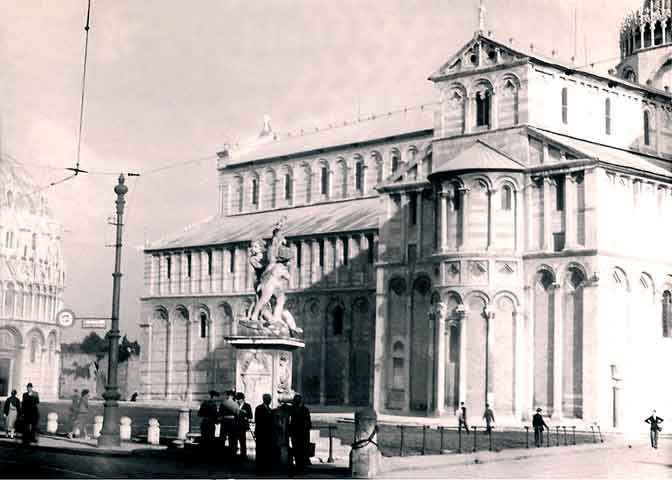
The Duomo Cathedral, Pisa.

10 Lira Note. BeBe records that it was worth 1.15 old pence then - which at July 2013 prices is about 15p.
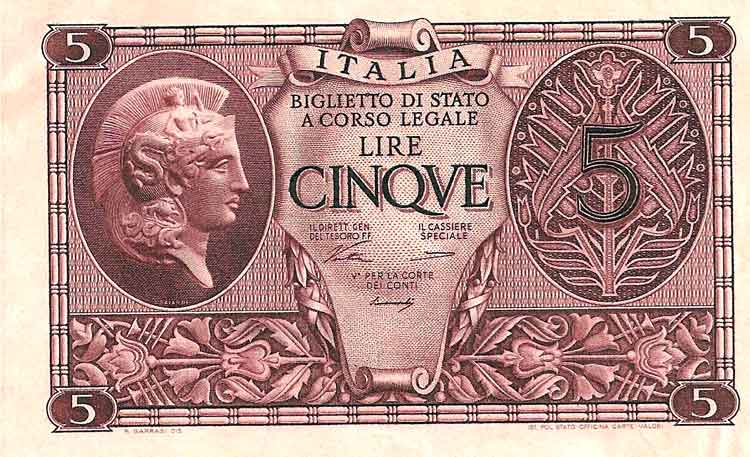 5 Lira note.
5 Lira note.
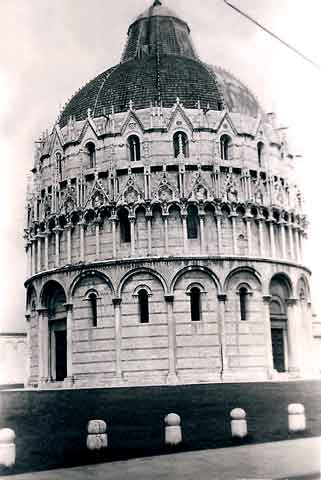
The Baptistery, dedicated to St. John the Baptist, stands opposite the west end of the Duomo. The round Romanesque building was begun in the mid 12th century: 1153 Mense August fundata fuit haec ("In the month of August 1153 was set up here..."). It was built in Romanesque style by an architect known as Diotisalvi ("God Save You"), who worked also in the church of the Holy Sepulchre in the city. His name is mentioned on a pillar inside, as Diotosalvi magister, the construction was not, however, finished until the 14th century, when the loggia, the top storey and the dome were added in Gothic style by Nicola Pisano and Giovanni Pisano. It is the largest baptistery in Italy. Its circumference measures 107.25 m. Taking into account the statue of St. John the Baptist (attributed to Turino di Sano) on top of the dome, it is even a few centimetres higher than the Leaning Tower.
FLORENCE, ITALY
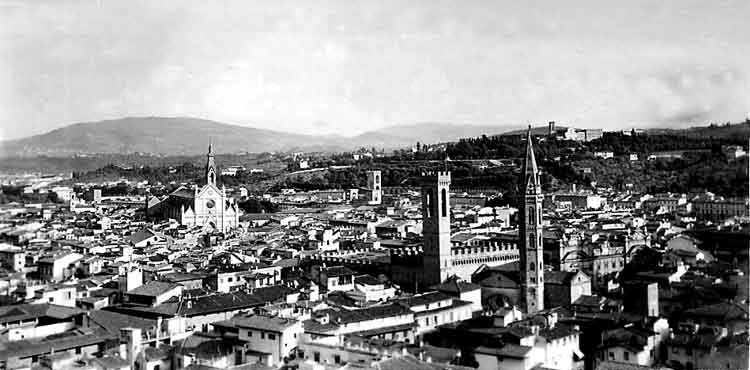
View from the dome of the Duomo, Florence, Italy. The Basilica of Santa Croce is on the left, (see next picture). The Basilica di Santa Croce (Basilica of the Holy Cross) is the principal Franciscan church in Florence, Italy, and a minor basilica of the Roman Catholic Church. It is situated on the Piazza di Santa Croce, about 800 metres south east of the Duomo. The site, when first chosen, was in marshland outside the city walls. It is the burial place of some of the most illustrious Italians, such as Michelangelo, Galileo, Machiavelli, Foscolo, Gentile and Rossini, thus it is known also as the Temple of the Italian Glories. The castellated building in the centre is the Il Bargello. The Bargello, also known as the Bargello Palace, Museo Nazionale del Bargello, or Palazzo del Popolo (Palace of the People) is a former barracks and prison, now an art museum, in Florence, Italy. (Thanks to Wikipedia).
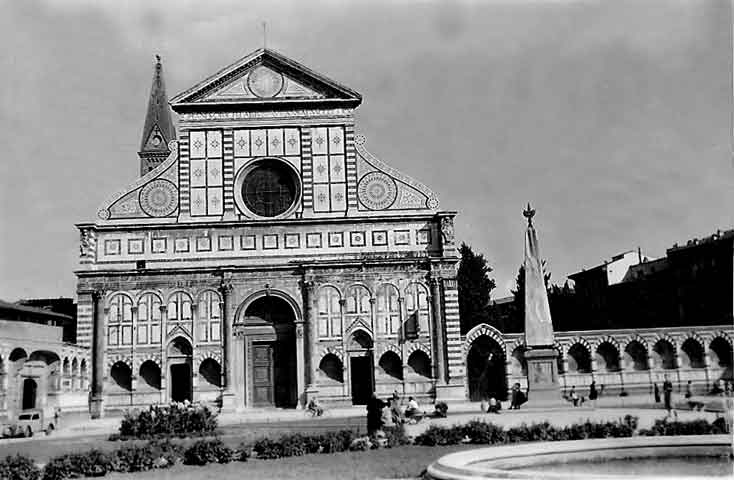
Santa Maria Novella is a church in Florence, Italy, situated just across from the main railway station which shares its name. Chronologically, it is the first great basilica in Florence, and is the city's principal Dominican church. The church, the adjoining cloister, and chapter house contain a store of art treasures and funerary monuments. Especially famous are frescoes by masters of Gothic and early Renaissance. They were financed through the generosity of the most important Florentine families, who ensured themselves of funerary chapels on consecrated ground. (Thanks to Wikipedia).
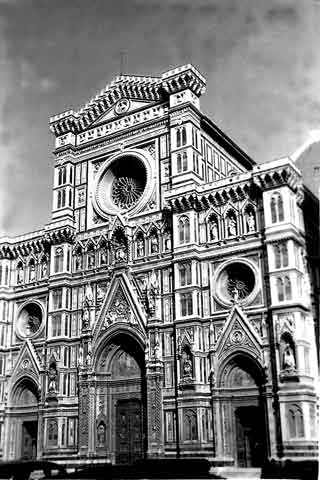
The Basilica di Santa Maria del Fiore (English: Basilica of Saint Mary of the Flower) is the main church of Florence, Italy. Il Duomo di Firenze, as it is ordinarily called, was begun in 1296 in the Gothic style to the design of Arnolfo di Cambio and completed structurally in 1436 with the dome engineered by Filippo Brunelleschi. The exterior of the basilica, shown here, is faced with polychrome marble panels in various shades of green and pink bordered by white and has an elaborate 19th-century Gothic Revival façade by Emilio De Fabris. The cathedral complex, located in Piazza del Duomo, includes the Baptistery and Giotto's Campanile. The three buildings are part of the UNESCO World Heritage Site covering the historic centre of Florence and are a major attraction to tourists visiting the region of Tuscany. The basilica is one of Italy's largest churches, and until development of new structural materials in the modern era, the dome was the largest in the world. It remains the largest brick dome ever constructed. The cathedral is the mother church of the Roman Catholic Archdiocese of Florence, whose archbishop is currently Giuseppe Betori. (Thanks to Wikipedia).
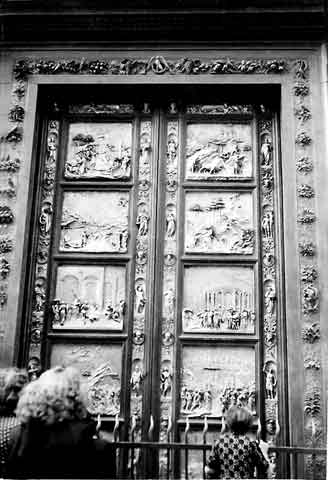

The Gates of Paradise - the doors to the Baptistry, Florence. In 1401, a competition was announced by the Arte di Calimala (Cloth Importers Guild) to design doors which would eventually be placed on the north side of the baptistry. (The original location for these doors was the east side of the baptistry, but the doors were moved to the north side of the baptistry after Ghiberti completed his second commission, known as the "Gates of Paradise.")
These new doors would serve as a votive offering to celebrate the sparing of Florence from relatively recent scourges such as the Black Death in 1348. Many artists competed for this commission and a jury selected seven semifinalists. These finalists include Lorenzo Ghiberti, Filippo Brunelleschi, Donatello and Jacopo della Quercia, with 21-year old Ghiberti winning the commission. At the time of judging, only Ghiberti and Brunelleschi were finalists, and when the judges could not decide, they were assigned to work together on them. Brunelleschi's pride got in the way, and he went to Rome to study architecture leaving Ghiberti to work on the doors himself. Ghiberti's autobiography, however, claimed that he had won, "without a single dissenting voice." The original designs of The Sacrifice of Isaac by Ghiberti and Brunelleschi are on display in the museum of the Bargello. (Thanks to Wikipedia).
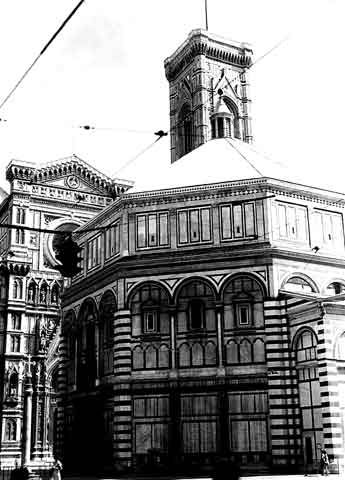
Florence Cathedral. Santa Maria del Fiore was built on the site of an earlier cathedral dedicated to Saint Reparata, according to Bartlett, the cojonied by Arnolfo di Cambio and approved by city council in 1294. Arnolfo di Cambio was also architect of the church of Santa Croce and the Palazzo Vecchio. He designed three wide naves ending under the octagonal dome, with the middle nave covering the area of Santa Reparata. The first stone was laid on September 9, 1296 by Cardinal Valeriana, the first papal legate ever sent to Florence. The building of this vast project was to last 140 years, the collective efforts of several generations; Arnolfo's plan for the eastern end, although maintained in concept, was greatly expanded in size. (Thanks to Wikipedia).
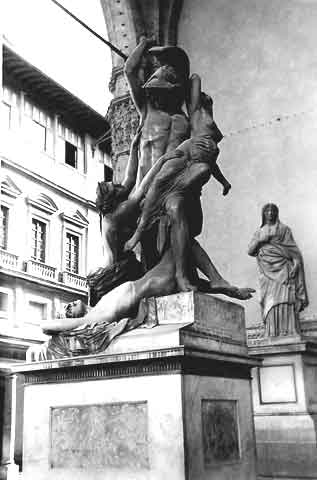
The Rape of the Sabine Women is an episode in the legendary history of Rome, traditionally dated to 750 BC, in which the first generation of Roman men acquired wives for themselves from the neighboring Sabine families. The English word "rape" is a conventional translation of Latin raptio, which in this context means "abduction" rather than its prevalent modern meaning in English language of sexual violation. Recounted by Livy and Plutarch (Parallel Lives II, 15 and 19), it provided a subject for Renaissance and post-Renaissance works of art that combined a suitably inspiring example of the hardihood and courage of ancient Romans with the opportunity to depict multiple figures, including heroically semi-nude figures, in intensely passionate struggle. The sculpture by Giambologna (1579-1583), shown above, that was reinterpreted as expressing this theme depicts three figures (a man lifting a woman into the air while a second man crouches) and was carved from a single block of marble. This sculpture is considered Giambologna's masterpiece. Originally intended as nothing more than a demonstration of the artist's ability to create a complex sculptural group, its subject matter, the legendary rape of the Sabines, had to be invented after Francesco I de' Medici, Grand Duke of Tuscany, decreed that it be put on public display in the Loggia dei Lanzi in Piazza della Signoria, Florence. True to mannerist densely-packed, intertwined figural compositions and ambitious overinclusive efforts, the statue renders a dynamic panoply of emotions, in poses that offer multiple viewpoints. When contrasted with the serene single-viewpoint pose of the nearby Michelangelo's David, finished nearly 80 years before, this statue is infused with the dynamics that lead towards Baroque, but the tight, uncomfortable, verticality - self-imposed by the author's virtuosic restriction to a composition that could be carved from a single block of marble - lacks the diagonal thrusts that Bernini would achieve forty years later with his Rape of Proserpina and Apollo and Daphne, both at the Galleria Borghese, Rome. (Thanks to Wikipedia).
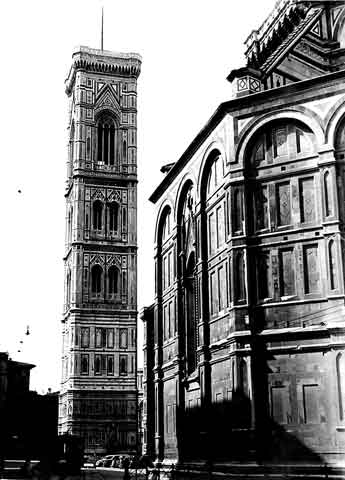
Giotto's Campanile is a free-standing campanile that is part of the complex of buildings that make up Florence Cathedral on the Piazza del Duomo in Florence, Italy. Standing adjacent the Basilica of Santa Maria del Fiore and the Baptistry of St. John, the tower is one of the showpieces of the Florentine Gothic architecture with its design by Giotto, its rich sculptural decorations and the polychrome marble encrustations. This slender structure stands on a square plan with a side of 14.45 metres (47.41 ft). It attains a height of 84.7 metres (277.9 ft) sustained by four polygonal buttresses at the corners. These four vertical lines are crossed by four horizontal lines, dividing the tower in five levels. (Thanks to Wikipedia).
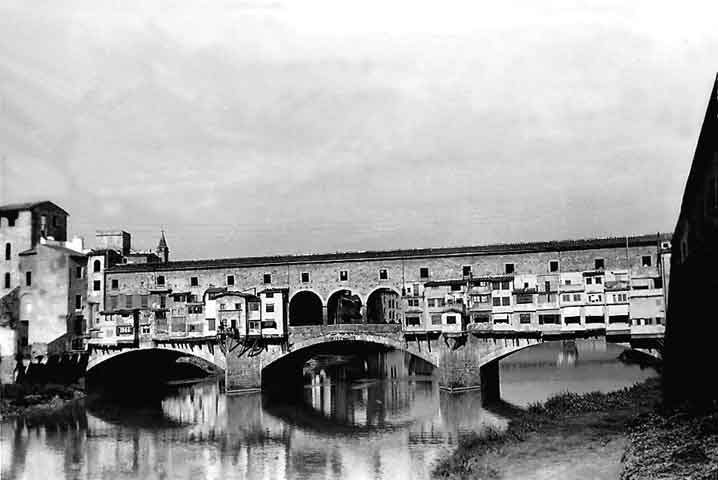
The Ponte Vecchio, "Old Bridge", is a Medieval stone closed-spandrel segmental arch bridge over the Arno River, in Florence, Italy, noted for still having shops built along it, as was once common. Butchers initially occupied the shops; the present tenants are jewellers, art dealers and souvenir sellers. The Ponte Vecchio's two neighbouring bridges are the Ponte Santa Trinita and the Ponte alle Grazie. (Thanks to Wikipedia).
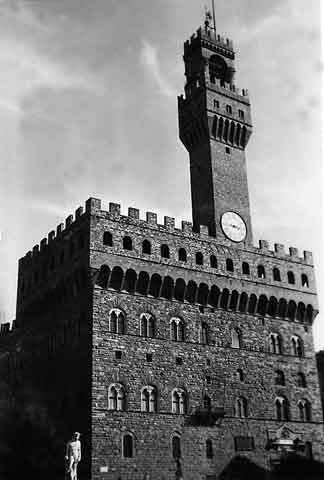
The Palazzo Vecchio "Old Palace" is the town hall of Florence, Italy. This massive, Romanesque, crenellated fortress-palace is among the most impressive town halls of Tuscany. Overlooking the Piazza della Signoria with its copy of Michelangelo's David statue as well as the gallery of statues in the adjacent Loggia dei Lanzi, it is one of the most significant public places in Italy. Originally called the Palazzo della Signoria, after the Signoria of Florence, the ruling body of the Republic of Florence, it was also given several other names: Palazzo del Popolo, Palazzo dei Priori, and Palazzo Ducale, in accordance with the varying use of the palace during its long history. The building acquired its current name when the Medici duke's residence was moved across the Arno to the Palazzo Pitti.
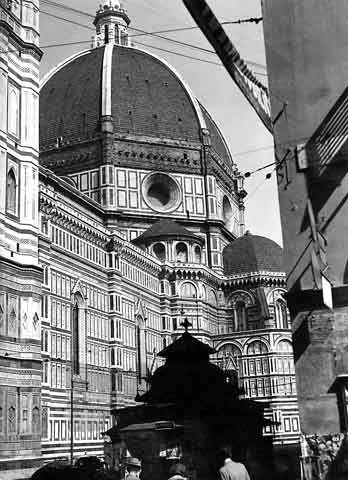
The Basilica di Santa Maria del Fiore. By the beginning of the 15th century, after a hundred years of construction, the structure was still missing its dome. The basic features of the dome had been designed by Arnolfo di Cambio in 1296. His brick model, 4.6 metres (15 ft) high 9.2 metres (30 ft) long, was standing in a side aisle of the unfinished building, and had long ago become sacrosanct. It called for an octagonal dome higher and wider than any that had ever been built, with no external buttresses to keep it from spreading and falling under its own weight. Brunelleschi's solutions were ingenious. The spreading problem was solved by a set of four internal horizontal stone and iron chains, serving as barrel hoops, embedded within the inner dome: one each at the top and bottom, with the remaining two evenly spaced between them. A fifth chain, made of wood, was placed between the first and second of the stone chains. Since the dome was octagonal rather than round, a simple chain, squeezing the dome like a barrel hoop, would have put all its pressure on the eight corners of the dome. The chains needed to be rigid octagons, stiff enough to hold their shape, so as not to deform the dome as they held it together. The building of the cathedral had started in 1296 with the design of Arnolfo di Cambio and was completed in 1469 with the placing of Verrochio's copper ball atop the lantern. But the façade was still unfinished and would remain so until the 19th century. (Thanks to Wikipedia).
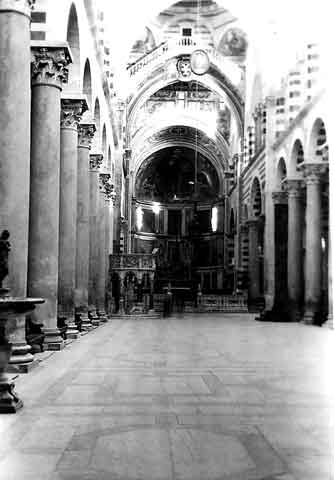
Interior of the Basilica di Santa Maria del Fiore. The Gothic interior is vast and gives an empty impression. The relative bareness of the church corresponds with the austerity of religious life, as preached by Girolamo Savonarola. Many decorations in the church have been lost in the course of time, or have been transferred to the Museum Opera del Duomo, such as the magnificent cantorial pulpits (the singing galleries for the choristers) of Luca della Robbia and Donatello. As this cathedral was built with funds from the public, some important works of art in this church honour illustrious men and military leaders of Florence. (Thanks to Wikipedia).
ROME, ITALY
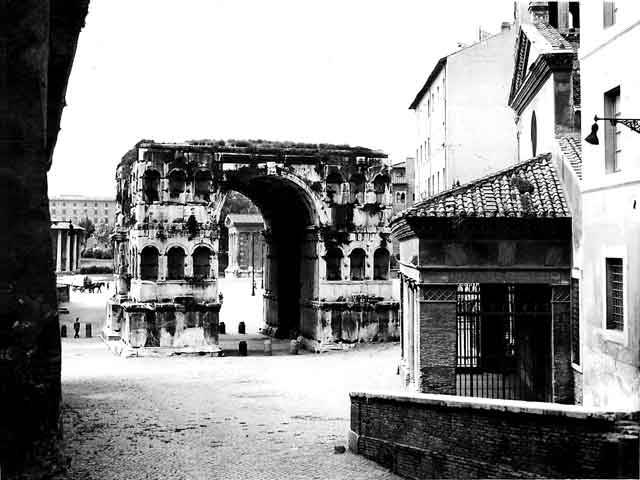
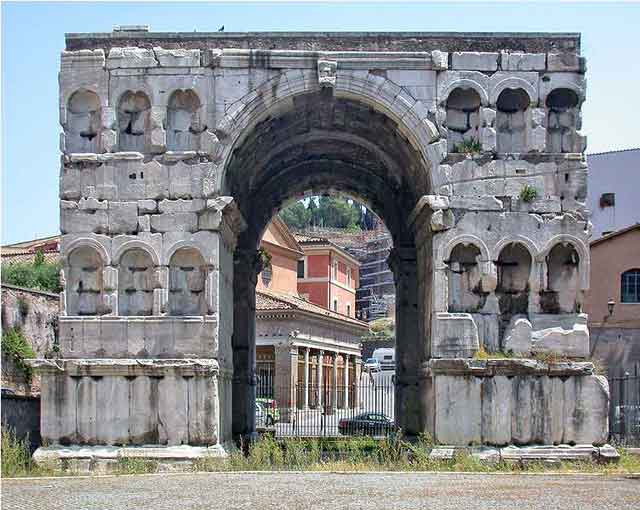
The Arch of Janus is the only quadrifrons triumphal arch preserved in Rome, across a crossroads in the Velabrum-Forum Boarium. his picture was taken in 1948 after the war. The colour picture shows it cleaned up today. It was built in the early 4th century, using spolia, possibly in honour of Constantine I or Constantius II. Its current name probably dates from the Renaissance or later, and was not used to describe it in classical antiquity. The name is derived from the structure's four-fronted, four-arched configuration; relating this to the four-faced version of Janus (Ianus Quadrifons), as well as to actual Janus-related structures mentioned in historic descriptions of ancient Rome. In the Middle Ages, the Frangipane family transformed the building into a fortress, and so it survived intact until 1830. Then, the attic and top were torn down because they were erroneously believed to not belong to the original structure. Fragments of the dedicatory inscription are still preserved inside the nearby church of San Giorgio al Velabro.
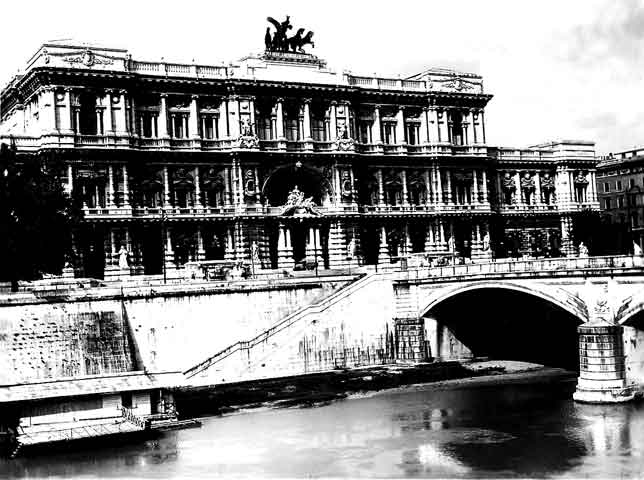
The Palace of Justice, Rome (Italian: Palazzo di Giustizia), the seat of the Supreme Court of Cassation and the Judicial Public Library, is located in the Prati district of Rome. It fronts onto the Piazza dei Tribunali, the Via Triboniano, the Piazza Cavour, and the Via Ulpiano. The huge building is popularly called in Italian the Palazzaccio (the bad Palace). Inspired by late Renaissance and Baroque architecture, the building is 170 meters by 155 in size and is completely covered with Travertine limestone. Above the façade looking towards the River Tiber it is surmounted by a great bronze quadriga, set there in 1926, the work of the sculptor Ettore Ximenes from Palermo. Ten large statues of notable jurists adorn the ramps before the main façade and the internal courtyard. The bridge is the Ponte Umberto.
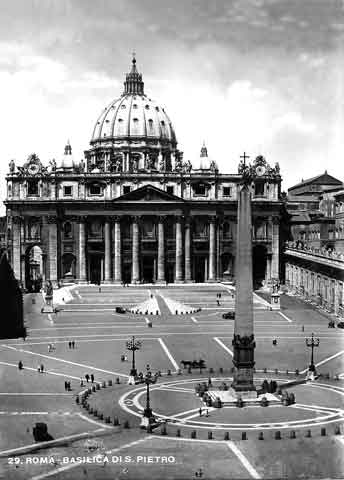
St. Peter's Basilica is a Late Renaissance church located within Vatican City. Designed principally by Donato Bramante, Michelangelo, Carlo Maderno and Gian Lorenzo Bernini, St. Peter's is the most renowned work of Renaissance architecture and remains one of the largest churches in the world. While it is neither the mother church of the Roman Catholic Church nor the cathedral of the Bishop of Rome, St. Peter's is regarded as one of the holiest Catholic sites. It has been described as "holding a unique position in the Christian world" and as "the greatest of all churches of Christendom". By Roman Catholic tradition, the basilica is the burial site of its namesake Saint Peter, one of the twelve apostles of Jesus and, also according to tradition, the first Bishop of Rome and therefore first in the line of the papal succession. Tradition and some historical evidence hold that Saint Peter's tomb is directly below the altar of the basilica. For this reason, many Popes have been interred at St. Peter's since the Early Christian period. There has been a church on this site since the time of Constantine. Construction of the present basilica, replacing the Old St. Peter's Basilica of the 4th century, began on 18 April 1506 and was completed on 18 November 1626. St. Peter's is famous as a place of pilgrimage, for its liturgical functions. Because of its location in the Vatican, the Pope presides at a number of services throughout the year, drawing audiences of 15,000 to over 80,000 people, either within the Vatican Basilica, or in St. Peter's Square. St. Peter's has many strong historical associations, with the Early Christian church, the papacy, the Counter-reformation and with numerous artists, most significantly Michelangelo. As a work of architecture, it is regarded as the greatest building of its age. St. Peter's is one of the four churches of Rome that hold the rank of Major Basilica. Contrary to popular misconception, it is not a cathedral as it is not the seat of a bishop; the cathedra of the Bishop of Rome is located in the Archbasilica of St. John Lateran.
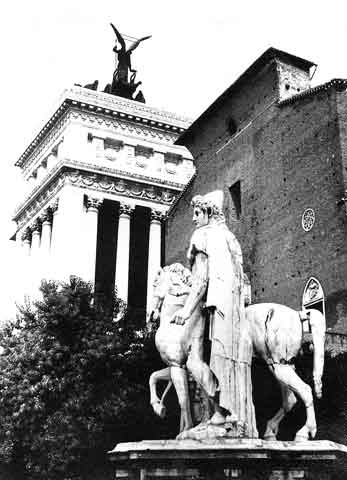
Statue of Castor on the Capitoline Hill at the top of the Cordonata steps. One of the two restored ancient statues of the twin gods Castor and Pollux, also known as the Dioscuri, that flank the top of the Cordonata Steps leading to the Capitoline. Traditionally, only Castor was a horse-tamer and Pollux was a boxer, although both figures are depicted with horses. In the background is the brick facade of the Basilica of St. Mary of the Altar of Heaven which is a titular basilica in Rome, located on the highest summit of the Campidoglio. It is still the designated Church of the city council of Rome, which uses the ancient title of Senatus Populusque Romanus. The present Cardinal Priest of the Titulus Sancta Mariae de Aracoeli is Salvatore De Giorgi. Behind it can be seen one of the wings of the Altare della Patria (Altar of the Fatherland) also known as the Monumento Nazionale a Vittorio Emanuele II (National Monument to Victor Emmanuel II) or "Il Vittoriano" is a monument built in honour of Victor Emmanuel, the first king of a unified Italy, located in Rome, Italy. It occupies a site between the Piazza Venezia and the Capitoline Hill. The monument was designed by Giuseppe Sacconi in 1885; sculpture for it was parceled out to established sculptors all over Italy, such as Leonardo Bistolfi and Angelo Zanelli. It was inaugurated in 1911 and completed in 1925. The monument is built of white marble from Botticino, Brescia, and features stairways, Corinthian columns, fountains, an equestrian sculpture of Victor Emmanuel and two statues of the goddess Victoria riding on quadrigas, the back of one can be seen in the picture. The structure is 135 m (443 ft) wide and 70 m (230 ft) high. If the quadrigae and winged victories are included, the height is to 81 m (266 ft). The base of the structure houses the museum of Italian Unification. In 2007, a panoramic elevator was added to the structure, allowing visitors to ride up to the roof for 360 degree views of Rome.
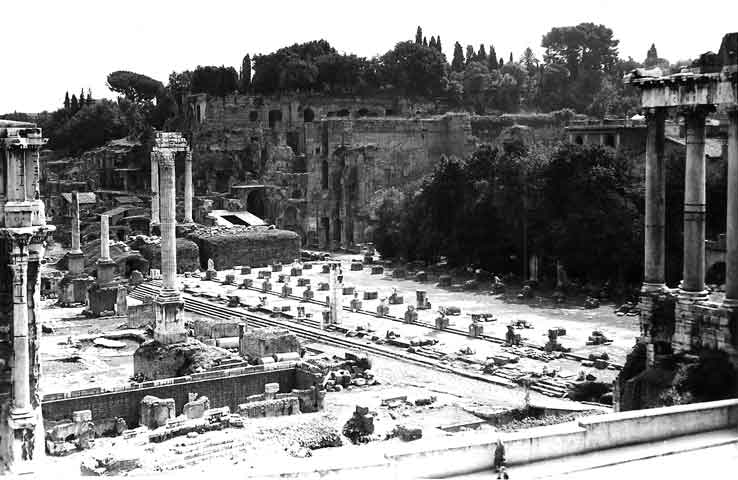
The Roman Forum is a rectangular forum (plaza) surrounded by the ruins of several important ancient government buildings at the center of the city of Rome. Citizens of the ancient city referred to this space, originally a marketplace, as the Forum Magnum, or simply the Forum. It was for centuries the center of Roman public life: the site of triumphal processions and elections; the venue for public speeches, criminal trials, and gladiatorial matches; and the nucleus of commercial affairs. Here statues and monuments commemorated the city's great men. The teeming heart of ancient Rome, it has been called the most celebrated meeting place in the world, and in all history. Located in the small valley between the Palatine and Capitoline Hills, the Forum today is a sprawling ruin of architectural fragments and intermittent archeological excavations attracting numerous sightseers. Many of the oldest and most important structures of the ancient city were located on or near the Forum. The Roman kingdom's earliest shrines and temples were located on the southeastern edge. These included the ancient former royal residence, the Regia (8th century BC), and the Temple of Vesta (7th century BC), as well as the surrounding complex of the Vestal Virgins, all of which were rebuilt after the rise of imperial Rome. On the right the edge of the Portico Dii Consentes ("Portico of the Harmonious Gods"), sometimes known as the Area of the Dii Consentes, which is located at the bottom of the ancient Roman road that leads up to the Capitol in Rome and to the Temple of Jupiter at its summit. The Clivus Capitolinus ("Capitoline Rise") turned sharply at the head of the Forum Romanum where this portico of marble and composite material was discovered and re-erected in 1835. (Thanks to Wikipedia).
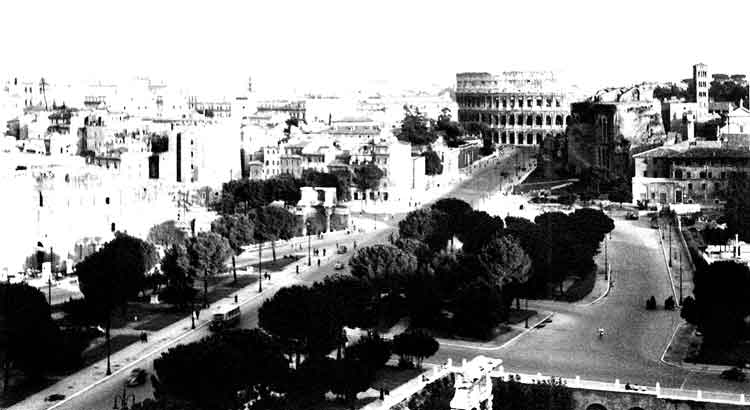
The Colosseum or Coliseum, also known as the Flavian Amphitheatre is an elliptical amphitheatre in the centre of the city of Rome. Built of concrete and stone, it was the largest amphitheatre of the Roman Empire, and is considered one of the greatest works of Roman architecture and engineering. It is the largest amphitheatre in the world. The Colosseum is situated just east of the Roman Forum. Construction began under the emperor Vespasian in 70 AD, and was completed in 80 AD under his successor and heir Titus. Further modifications were made during the reign of Domitian (81-96). These three emperors are known as the Flavian dynasty, and the amphitheatre was named in Latin for its association with their family name (Flavius). The Colosseum could hold, it is estimated, between 50,000 and 80,000 spectators, and was used for gladiatorial contests and public spectacles such as mock sea battles, animal hunts, executions, re-enactments of famous battles, and dramas based on Classical mythology. The building ceased to be used for entertainment in the early medieval era. It was later reused for such purposes as housing, workshops, quarters for a religious order, a fortress, a quarry, and a Christian shrine. Although in the 21st century it stays partially ruined because of damage caused by devastating earthquakes and stone-robbers, the Colosseum is an iconic symbol of Imperial Rome. It is one of Rome's most popular tourist attractions and has close connections with the Roman Catholic Church, as each Good Friday the Pope leads a torchlit "Way of the Cross" procession that starts in the area around the Colosseum. To protect the structure from pollution the roads around have just been closed to traffic in Summer 2013. (Thanks to Wikipedia).
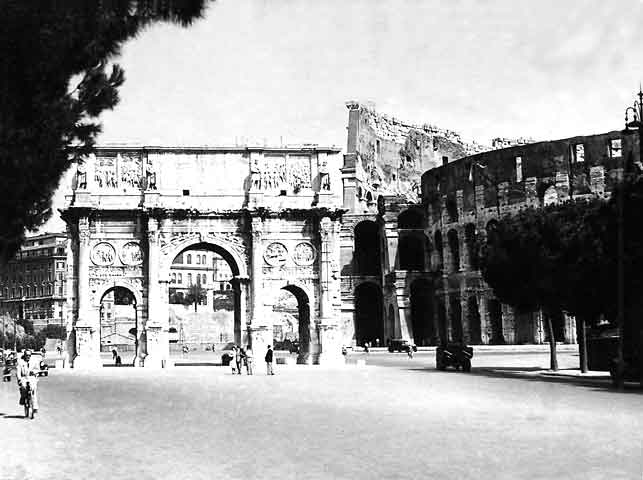
The Arch of Constantine is a triumphal arch in Rome, situated between the Colosseum, (see on the right), and the Palatine Hill. It was erected by the Roman Senate to commemorate Constantine I's victory over Maxentius at the Battle of Milvian Bridge on October 28, 312. Dedicated in 315, it is the latest of the existing triumphal arches in Rome, and the only one to make extensive use of spolia, re-using several major reliefs from 2nd century imperial monuments, which give a striking and famous stylistic contrast to the sculpture newly-created for the arch. The arch spans the Via Triumphalis, the way taken by the emperors when they entered the city in triumph. This route started at the Campus Martius, led through the Circus Maximus and around the Palatine Hill; immediately after the Arch of Constantine, the procession would turn left at the Meta Sudans and march along the Via Sacra to the Forum Romanum and on to the Capitoline Hill, passing both the Arches of Titus and Septimius Severus. (Thanks to Wikipedia).
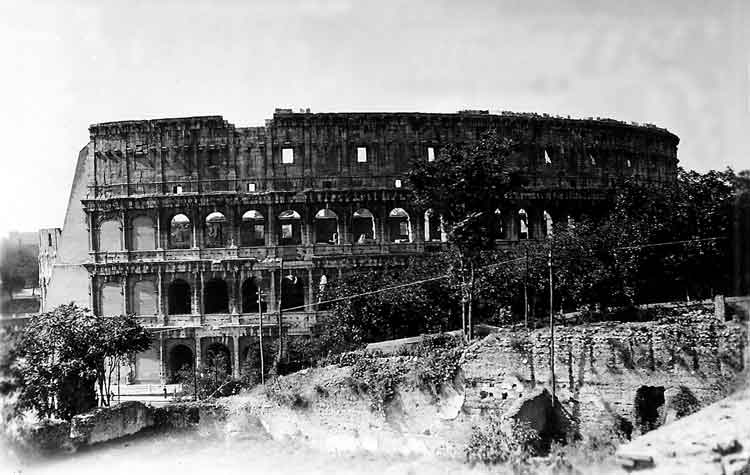
Closer photo of the Coloseum. The Colosseum was used to host gladiatorial shows as well as a variety of other events. The shows, called munera, were always given by private individuals rather than the state. They had a strong religious element but were also demonstrations of power and family prestige, and were immensely popular with the population. Another popular type of show was the animal hunt, or venatio. This utilized a great variety of wild beasts, mainly imported from Africa and the Middle East, and included creatures such as rhinoceros, hippopotamuses, elephants, giraffes, aurochs, wisents, Barbary lions, panthers, leopards, bears, Caspian tigers, crocodiles and ostriches. Battles and hunts were often staged amid elaborate sets with movable trees and buildings. Such events were occasionally on a huge scale; Trajan is said to have celebrated his victories in Dacia in 107 with contests involving 11,000 animals and 10,000 gladiators over the course of 123 days. During the early days of the Colosseum, ancient writers recorded that the building was used for naumachiae (more properly known as navalia proelia) or simulated sea battles. Accounts of the inaugural games held by Titus in AD 80 describe it being filled with water for a display of specially trained swimming horses and bulls. There is also an account of a re-enactment of a famous sea battle between the Corcyrean (Corfiot) Greeks and the Corinthians. This has been the subject of some debate among historians; although providing the water would not have been a problem, it is unclear how the arena could have been waterproofed, nor would there have been enough space in the arena for the warships to move around. It has been suggested that the reports either have the location wrong, or that the Colosseum originally featured a wide floodable channel down its central axis (which would later have been replaced by the hypogeum). (Thanks to Wikipedia).
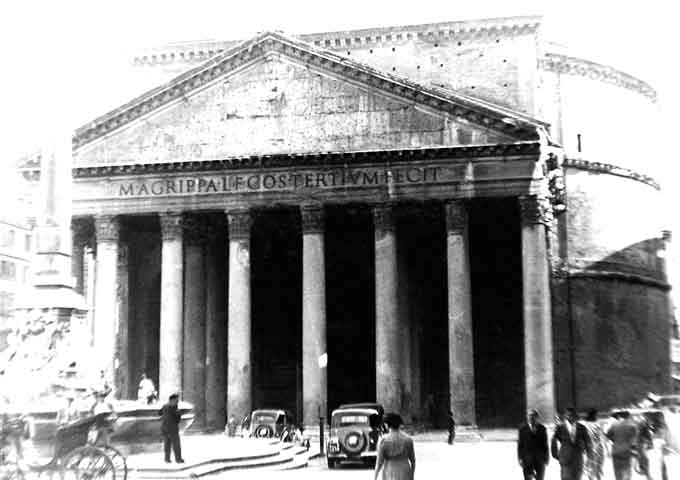
The Pantheon, an adjective understood as "[temple consecrated] to all gods" is a building in Rome, Italy, commissioned by Marcus Agrippa during the reign of Augustus as a temple to all the gods of ancient Rome, and rebuilt by the emperor Hadrian about 126 AD. The building is circular with a portico of large granite Corinthian columns (eight in the first rank and two groups of four behind) under a pediment. A rectangular vestibule links the porch to the rotunda, which is under a coffered concrete dome, with a central opening (oculus) to the sky. Almost two thousand years after it was built, the Pantheon's dome is still the world's largest unreinforced concrete dome. The height to the oculus and the diameter of the interior circle are the same, 43.3 metres (142 ft). It is one of the best-preserved of all Roman buildings. It has been in continuous use throughout its history, and since the 7th century, the Pantheon has been used as a Roman Catholic church dedicated to "St. Mary and the Martyrs" but informally known as "Santa Maria della Rotonda." The square in front of the Pantheon is called Piazza della Rotonda. (Thanks to Wikipedia).
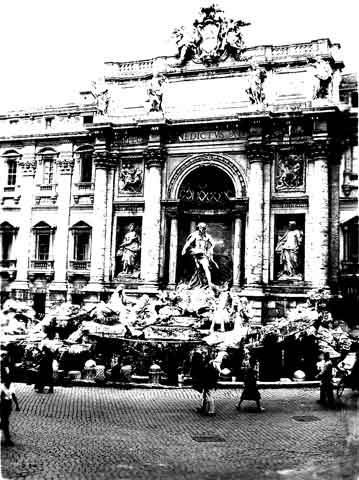
Trevi Fountain is a fountain in the Trevi district in Rome, Italy, designed by Italian architect Nicola Salvi and completed by Pietro Bracci. Standing 26.3 metres (86 ft) high and 49.15 metres (161.3 ft) wide, it is the largest Baroque fountain in the city and one of the most famous fountains in the world. The fountain at the junction of three roads (tre vie) marks the terminal point of the "modern" Acqua Vergine, the revived Aqua Virgo, one of the aqueducts that supplied water to ancient Rome. In 19 BC, supposedly with the help of a virgin, Roman technicians located a source of pure water some 13 km (8.1 mi) from the city. (This scene is presented on the present fountain's façade.) However, the eventual indirect route of the aqueduct made its length some 22 km (14 mi). This Aqua Virgo led the water into the Baths of Agrippa. It served Rome for more than 400 years. The coup de grâce for the urban life of late classical Rome came when the Goth besiegers in 537/38 cut off the aqueducts. Medieval Romans were reduced to drawing water from polluted wells and the Tiber River. (Thanks to Wikipedia).
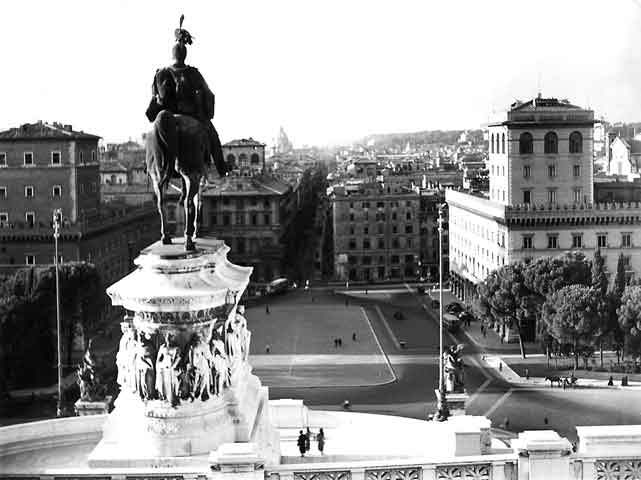
View from the top of the National Monument to Victor Emmanuel II. The monument holds the Tomb of the Unknown Soldier with an eternal flame, built under the statue of Italy after World War I following an idea of General Giulio Douhet. The body of the unknown soldier was chosen on 26Oct21 from among 11 unknown remains by Maria Bergamas, a woman from Gradisca d'Isonzo whose only child was killed during World War I. Her son's body was never recovered. The selected unknown was transferred from Aquileia, where the ceremony with Bergamas had taken place to Rome and buried in a state funeral on 4 November 1921. (Thanks to Wikipedia).
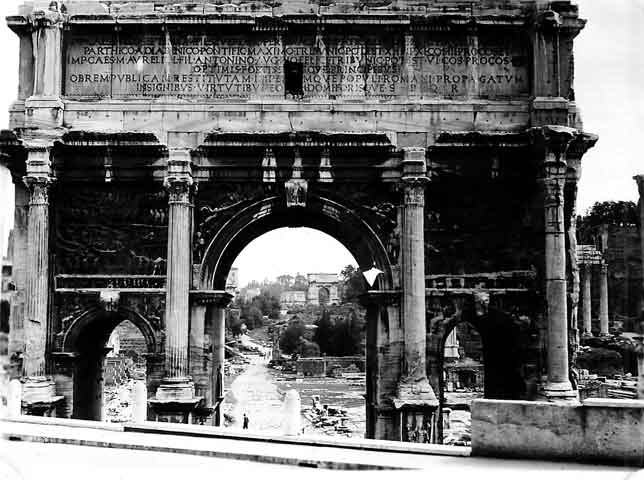
The white marble Arch of Septimius Severus (Italian: Arco di Settimio Severo) at the northwest end of the Roman Forum is a triumphal arch dedicated in AD 203 to commemorate the Parthian victories of Emperor Septimius Severus and his two sons, Caracalla and Geta, in the two campaigns against the Parthians of 194/195 and 197-199. After the death of Septimius Severus, his sons Caracalla and Geta were initially joint emperors. Caracalla had Geta assassinated in 212; Geta's memorials were destroyed and all images or mentions of him were removed from public buildings and monuments. Accordingly Geta's image and inscriptions referring to him were removed from the arch. The arch was raised on a travertine base originally approached by steps from the Forum's ancient level. The central archway, spanned by a richly coffered semicircular vault, has lateral openings to each side archway, a feature copied in many Early Modern triumphal arches. The Arch is about 68 feet in height and about 76 feet in width. (Thanks to Wikipedia).
BACK TO MALTA!
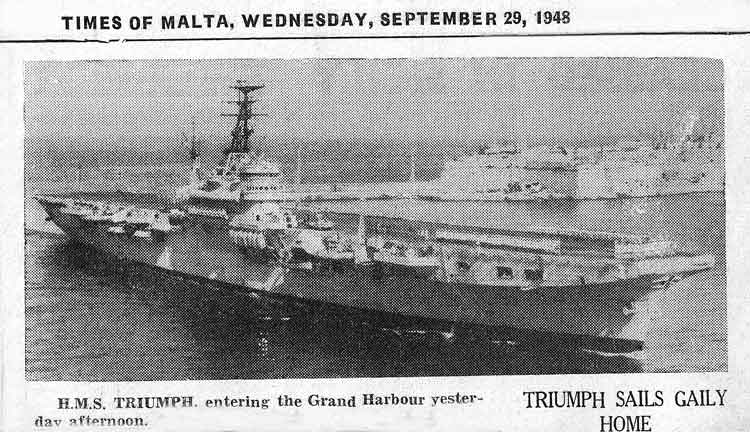
HMS Triumph returns to the Grand harbour, Malta and BeBe's Grand Tour comes to an end - Tuesday 28Sep48.
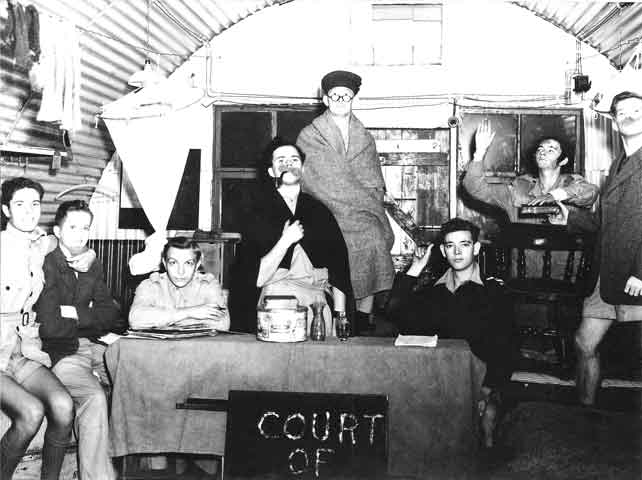
Court of Enquiry - Accused taking oath before, presumably, Judge BeBe.
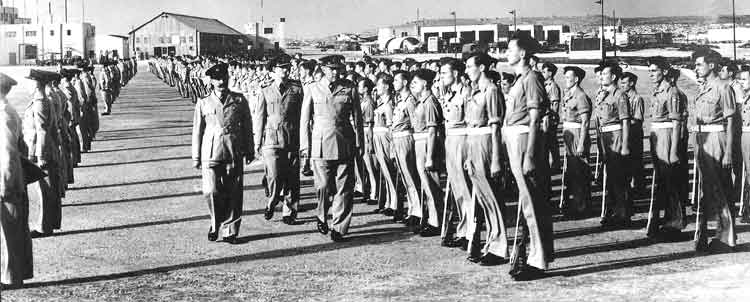
AOC's Parade - October 1948. Air Vice Marshal Sir Charles Ronald Steele KCB, DFC - Air Officer Commanding Malta 6Jun47 to 31Dec49.
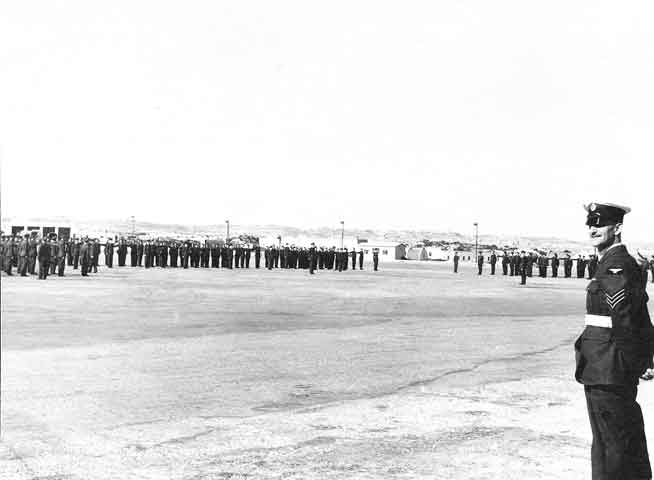
Remembrance Day Parade Nov48 - Sgt. Milne stops BeBe getting any nearer.
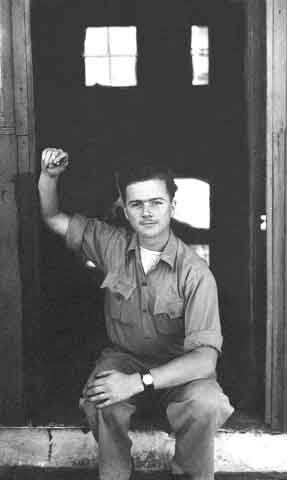
BeBe's final page in his first album. Last day of Summer period - hence the pullover under the KD.
(Thanks to Mamie Sharman and many quotations from Wikipedia.)
(
Click to go to Album 2.)





 Airmen's Mess Christmas Dinner Menu signed by everyone - Dec47.
Airmen's Mess Christmas Dinner Menu signed by everyone - Dec47. The Mess Christmas Day - '47.
The Mess Christmas Day - '47.






 Floats in the Valletta Carnival - Feb48. Carnival (Maltese: il-Karnival ta' Malta) has had an important place on the Maltese cultural calendar for just under five centuries, having been introduced to the Islands by Grand Master Piero de Ponte in 1535. It is held during the week leading up to Ash Wednesday, and typically includes masked balls, fancy dress and grotesque mask competitions, lavish late-night parties, a colourful, ticker-tape parade of allegorical floats presided over by King Carnival (Maltese: ir-Re tal-Karnival), marching bands and costumed revellers. (Thanks to Wikipedia).
Floats in the Valletta Carnival - Feb48. Carnival (Maltese: il-Karnival ta' Malta) has had an important place on the Maltese cultural calendar for just under five centuries, having been introduced to the Islands by Grand Master Piero de Ponte in 1535. It is held during the week leading up to Ash Wednesday, and typically includes masked balls, fancy dress and grotesque mask competitions, lavish late-night parties, a colourful, ticker-tape parade of allegorical floats presided over by King Carnival (Maltese: ir-Re tal-Karnival), marching bands and costumed revellers. (Thanks to Wikipedia).







 The Turkish Cemetery at Marsa - Jul48. On a visit to Malta in 1867 the Turkish Sultan Abdul Aziz presented Emmanuel Luigi Galizia (1830 - 1906), the Chief Government Architect, with the Order of the Mejidie. He also financed the building of the Turkish cemetery at Marsa which was designed by Galizia and completed in 1874. For this commission he based his design on Persian-Indian architecture. Islam came to Malta as early as the ninth century. When the Turks invaded Malta in 1565, they camped out in Marsa because of its harbour facilities and water supplies. Many died there though, because the wells had been poisoned in advance of their arrival. Since then, Muslims from a number of Arab countries have come to the islands with different intentions, and have received warmer welcomes. Galizia's travels in Cyprus, where the British twice sent him to report on the feasibility of a Maltese settlement, must have helped him to design this "fine example of Moorish architecture" (Zammit 233). He evidently enjoyed the style, turning to it again in the houses he built in the fashionable town of Sliema - one of which was for his own use. Muslims are very much in a minority in predominantly Roman Catholic Malta (about 1.2% of the population), and the cemetery is no longer used. (Thanks to Wikipedia).
The Turkish Cemetery at Marsa - Jul48. On a visit to Malta in 1867 the Turkish Sultan Abdul Aziz presented Emmanuel Luigi Galizia (1830 - 1906), the Chief Government Architect, with the Order of the Mejidie. He also financed the building of the Turkish cemetery at Marsa which was designed by Galizia and completed in 1874. For this commission he based his design on Persian-Indian architecture. Islam came to Malta as early as the ninth century. When the Turks invaded Malta in 1565, they camped out in Marsa because of its harbour facilities and water supplies. Many died there though, because the wells had been poisoned in advance of their arrival. Since then, Muslims from a number of Arab countries have come to the islands with different intentions, and have received warmer welcomes. Galizia's travels in Cyprus, where the British twice sent him to report on the feasibility of a Maltese settlement, must have helped him to design this "fine example of Moorish architecture" (Zammit 233). He evidently enjoyed the style, turning to it again in the houses he built in the fashionable town of Sliema - one of which was for his own use. Muslims are very much in a minority in predominantly Roman Catholic Malta (about 1.2% of the population), and the cemetery is no longer used. (Thanks to Wikipedia).

 Grand Harbour, Valletta, Malta with dry dock and aircraft carrier. Grand Harbour (in Maltese: Il-Port il-Kbir) is a natural harbour on the island of Malta. It has been used as a harbour since at least Phoenician times. The natural harbour has been greatly improved with extensive docks and wharves, and has been massively fortified. The harbour mouth faces north east and is bounded to the north by St Elmo's Point and further sheltered by an isolated breakwater and is bounded to the south by Ricasoli Point. Its north west shore is formed by the Scebarras peninsula, which is largely covered by the city of Valletta and its suburb Floriana. This peninsula also divides Grand Harbour from a second parallel natural harbour, Marsamxett Harbour. The main waterway of Grand Harbour continues inland almost to Marsa. The south eastern shore of the harbour is formed by a number of inlets and headlands, principally Rinella Creek, Kalkara Creek, Dockyard Creek, and French Creek, which are covered by Kalkara and the Three Cities: Cospicua, Vittoriosa, and Senglea. With its partner harbour of Marsamxett, Grand Harbour lies at the centre of gently rising ground. Development has grown up all around the twin harbours and up the slopes so that the whole bowl is effectively one large conurbation. Much of Malta's population lives within a three kilometer radius of Floriana. This is now one of the most densely populated areas in Europe. The harbours and docks are still active but with the departure of the British Military the harbour lost much of its military significance. A considerable part of Malta's commercial shipping is now handled by the new free port at Kalafrana, so the harbour is much quieter than it was in the first half of the 20th century. (Thanks to Wikipedia).
Grand Harbour, Valletta, Malta with dry dock and aircraft carrier. Grand Harbour (in Maltese: Il-Port il-Kbir) is a natural harbour on the island of Malta. It has been used as a harbour since at least Phoenician times. The natural harbour has been greatly improved with extensive docks and wharves, and has been massively fortified. The harbour mouth faces north east and is bounded to the north by St Elmo's Point and further sheltered by an isolated breakwater and is bounded to the south by Ricasoli Point. Its north west shore is formed by the Scebarras peninsula, which is largely covered by the city of Valletta and its suburb Floriana. This peninsula also divides Grand Harbour from a second parallel natural harbour, Marsamxett Harbour. The main waterway of Grand Harbour continues inland almost to Marsa. The south eastern shore of the harbour is formed by a number of inlets and headlands, principally Rinella Creek, Kalkara Creek, Dockyard Creek, and French Creek, which are covered by Kalkara and the Three Cities: Cospicua, Vittoriosa, and Senglea. With its partner harbour of Marsamxett, Grand Harbour lies at the centre of gently rising ground. Development has grown up all around the twin harbours and up the slopes so that the whole bowl is effectively one large conurbation. Much of Malta's population lives within a three kilometer radius of Floriana. This is now one of the most densely populated areas in Europe. The harbours and docks are still active but with the departure of the British Military the harbour lost much of its military significance. A considerable part of Malta's commercial shipping is now handled by the new free port at Kalafrana, so the harbour is much quieter than it was in the first half of the 20th century. (Thanks to Wikipedia).
 The officers have a dance. Presumably Officers' Mess, RAF Luqa, early 1948 - anyone able to add names?
The officers have a dance. Presumably Officers' Mess, RAF Luqa, early 1948 - anyone able to add names?


 Group taken after the opening of the Ten Pot Inn by the
Group taken after the opening of the Ten Pot Inn by the 


 St Paul's Island, Malta. St. Paul's Island (also referred to as Selmunett) is a small island close to Selmun near the north-east of the island of Malta. St. Paul's Island is sometimes split into two islands when the sea is rough. It has been uninhabited since the sole farmer abandoned his tiny dwelling and fields decades ago, thus making it the largest uninhabited island of Malta. The Acts of the Apostles tell the story of how St Paul was shipwrecked on an island which some scholars have identified as Malta while on his way to Rome to face charges. Traditionally, St Paul's Bay and, specifically, St Paul's Island are identified as the location for this shipwreck. A prominent statue of the saint, erected in 1845, stands on the island. (Thanks to Wikipedia).
St Paul's Island, Malta. St. Paul's Island (also referred to as Selmunett) is a small island close to Selmun near the north-east of the island of Malta. St. Paul's Island is sometimes split into two islands when the sea is rough. It has been uninhabited since the sole farmer abandoned his tiny dwelling and fields decades ago, thus making it the largest uninhabited island of Malta. The Acts of the Apostles tell the story of how St Paul was shipwrecked on an island which some scholars have identified as Malta while on his way to Rome to face charges. Traditionally, St Paul's Bay and, specifically, St Paul's Island are identified as the location for this shipwreck. A prominent statue of the saint, erected in 1845, stands on the island. (Thanks to Wikipedia).



 Lord Mountbatten, now dressed in his uniform, inspecting the Marines.
Lord Mountbatten, now dressed in his uniform, inspecting the Marines.




 The Last Post.
The Last Post.










 Billet photos - just a shower in B.8!!!
Billet photos - just a shower in B.8!!! 







 Taking the salute on the King's Birthday Parade - June 1948.
Taking the salute on the King's Birthday Parade - June 1948.


















 Avro 688 Tudor II taking off from RAF Luqa - June 1948. The second Tudor II to be completed, G-AGRY, went to Nairobi for tropical trials as VX202 (see this photo which may have been taken on its way to or from the trials), but these were unsatisfactory and Tudor II orders were reduced to 18. Eventually, only four Tudor IIs were completed including the prototype. Avro's Type 688 Tudor was a British piston-engined airliner based on their four-engine Lincoln bomber, itself a descendant of the famous
Avro 688 Tudor II taking off from RAF Luqa - June 1948. The second Tudor II to be completed, G-AGRY, went to Nairobi for tropical trials as VX202 (see this photo which may have been taken on its way to or from the trials), but these were unsatisfactory and Tudor II orders were reduced to 18. Eventually, only four Tudor IIs were completed including the prototype. Avro's Type 688 Tudor was a British piston-engined airliner based on their four-engine Lincoln bomber, itself a descendant of the famous 






 Vickers Valetta at RAF Luqa.
Vickers Valetta at RAF Luqa.

 Douglas DC-4 Skymaster in dispersal at RAF Luqa July 1948.
Douglas DC-4 Skymaster in dispersal at RAF Luqa July 1948.


































































 5 Lira note.
5 Lira note.





























